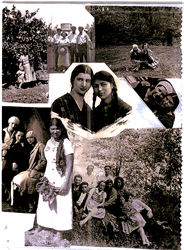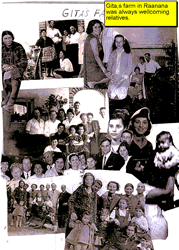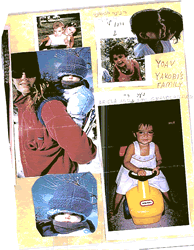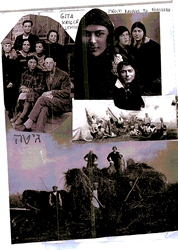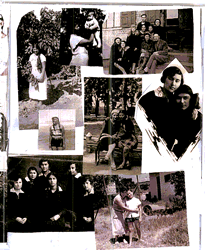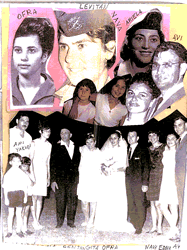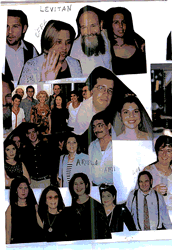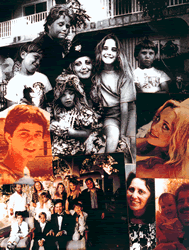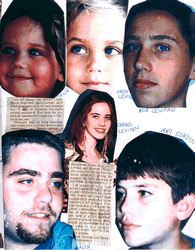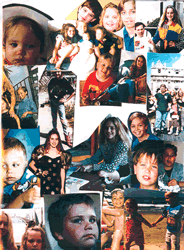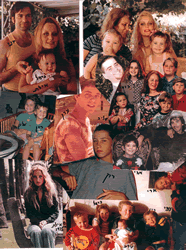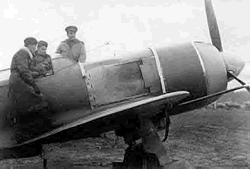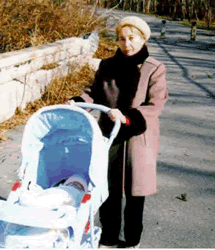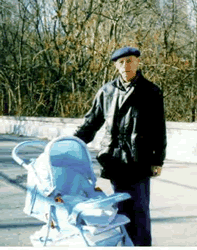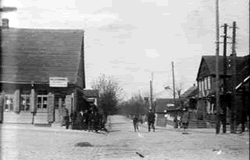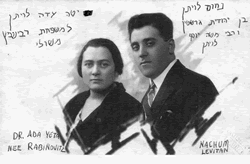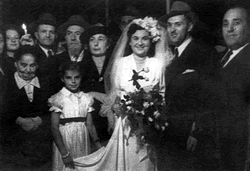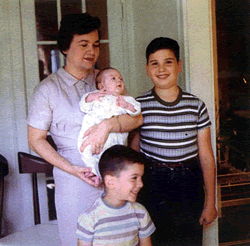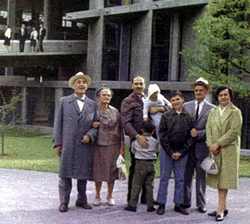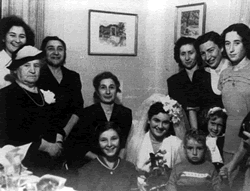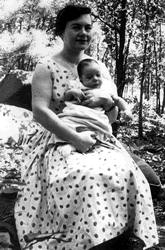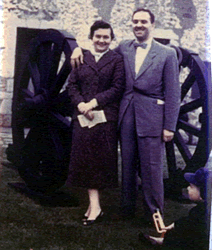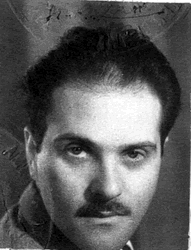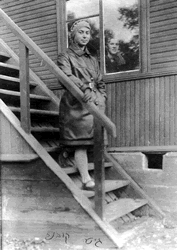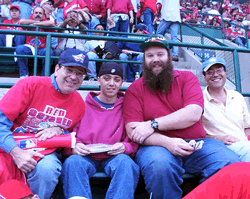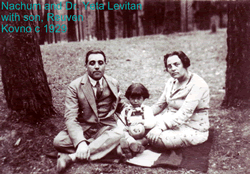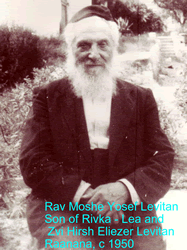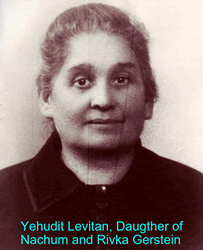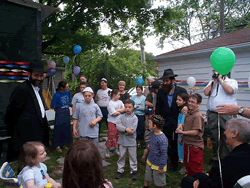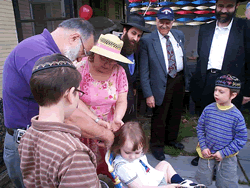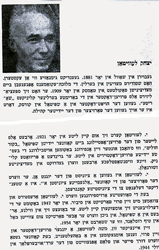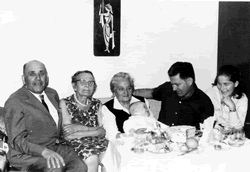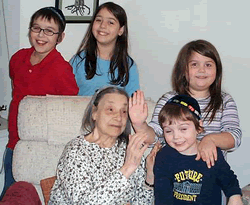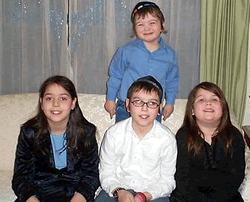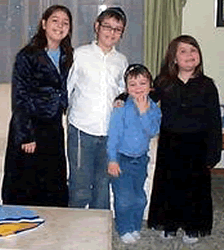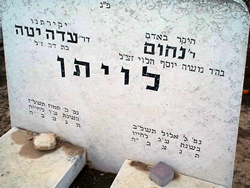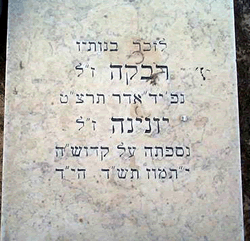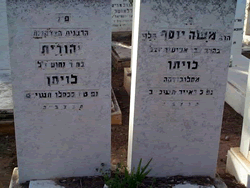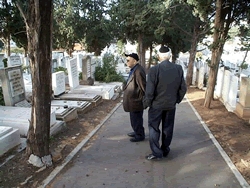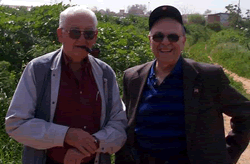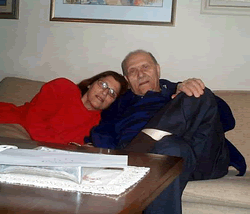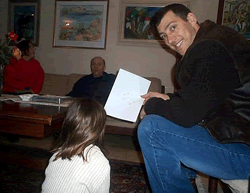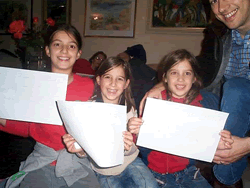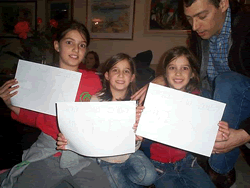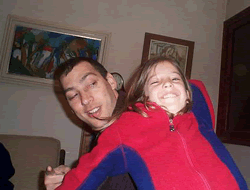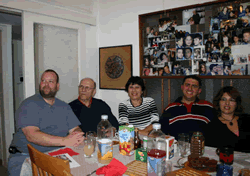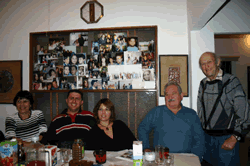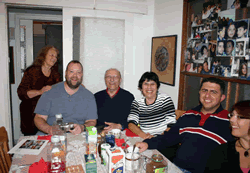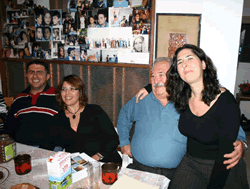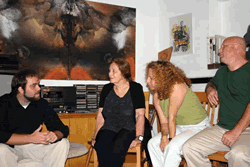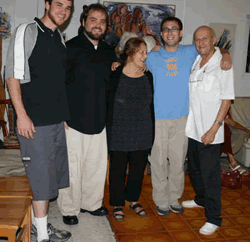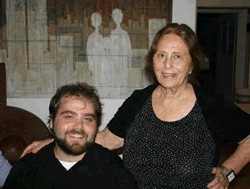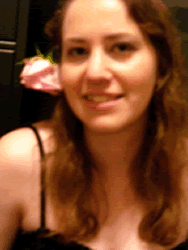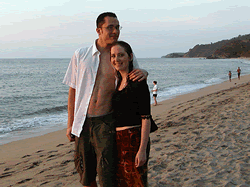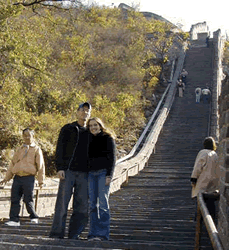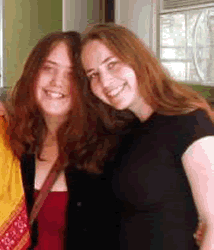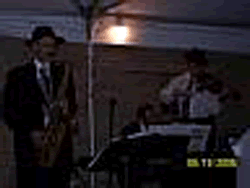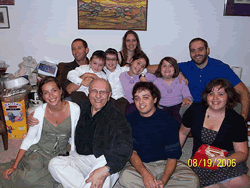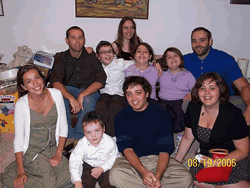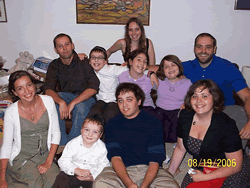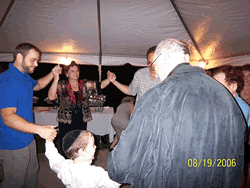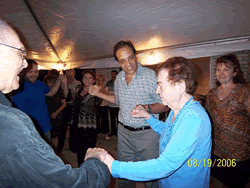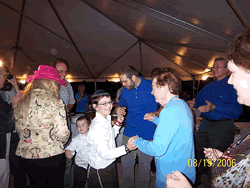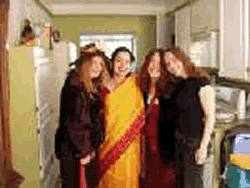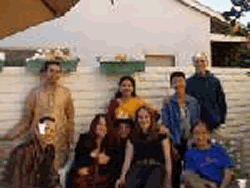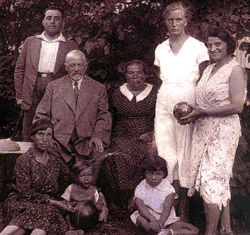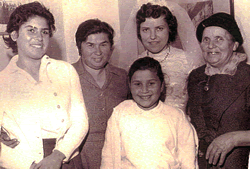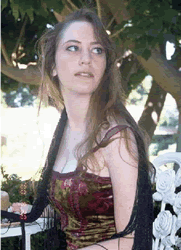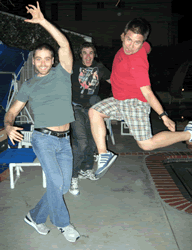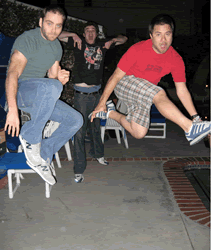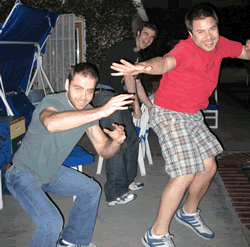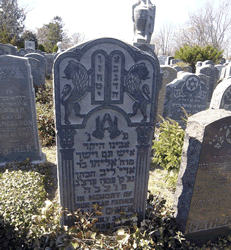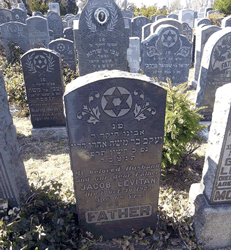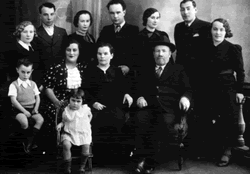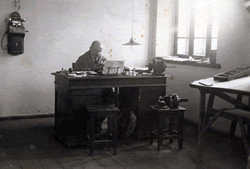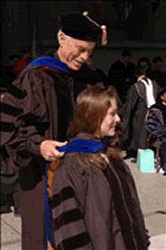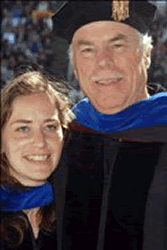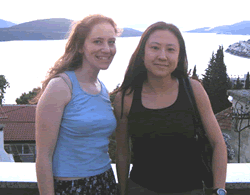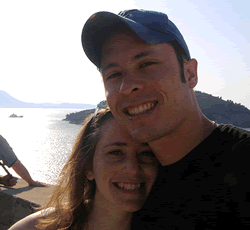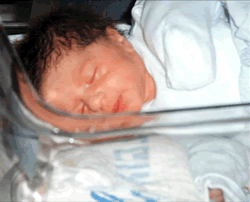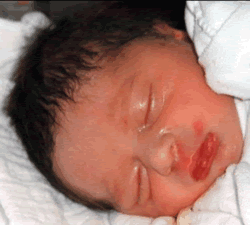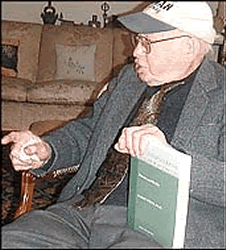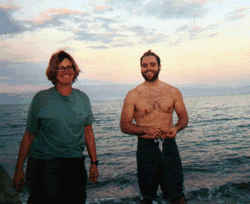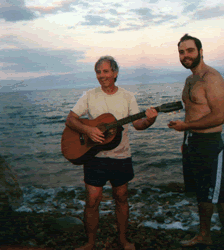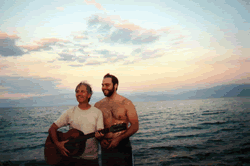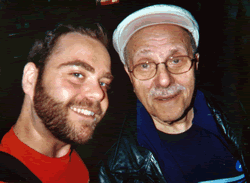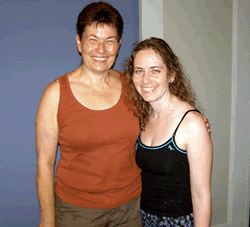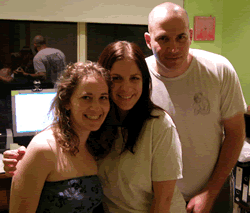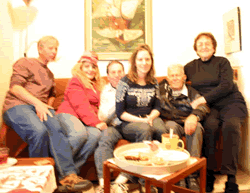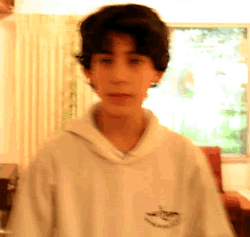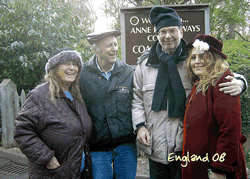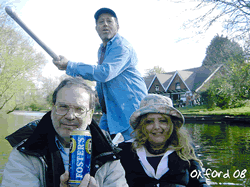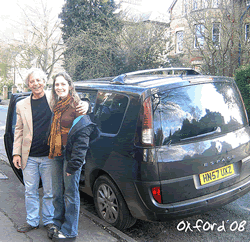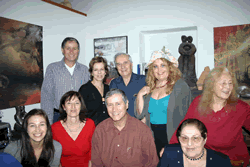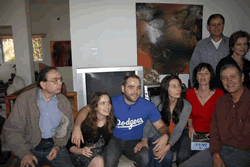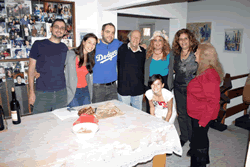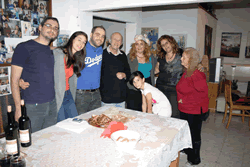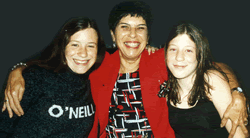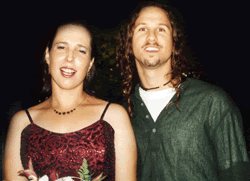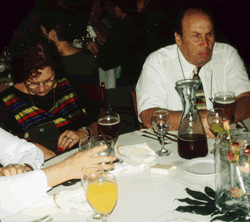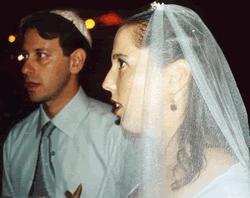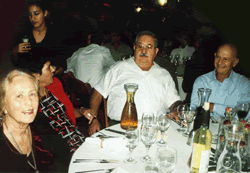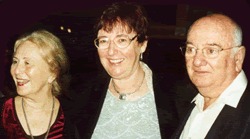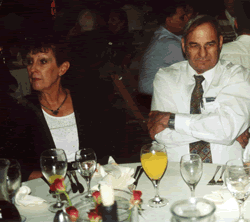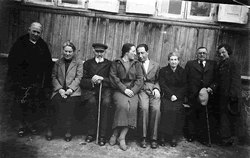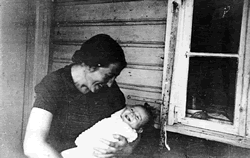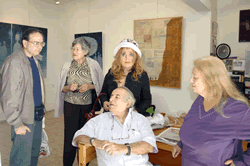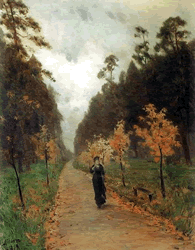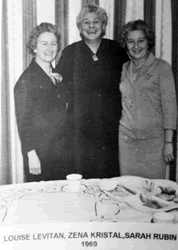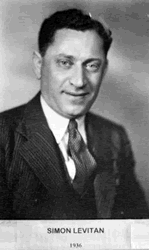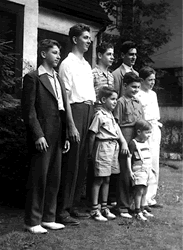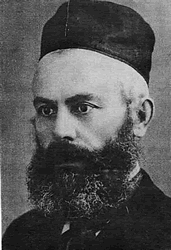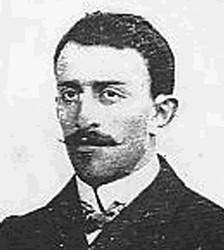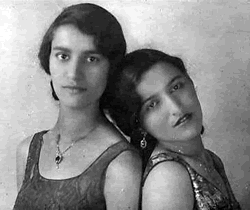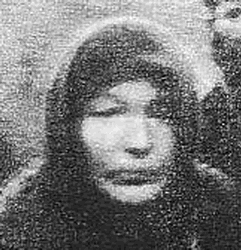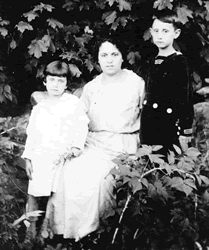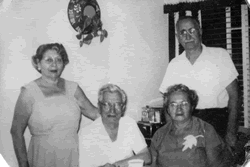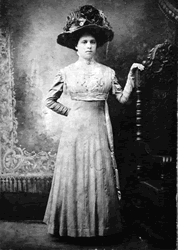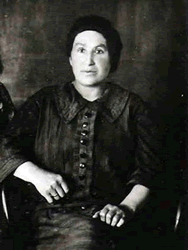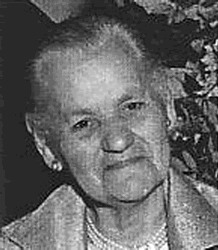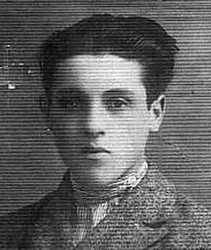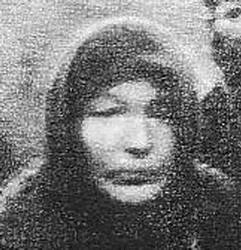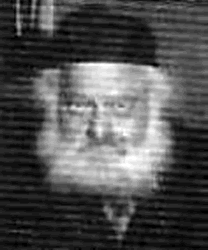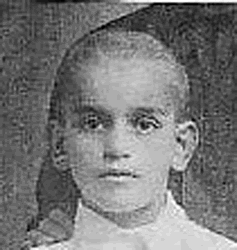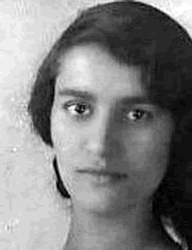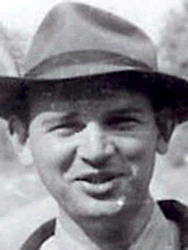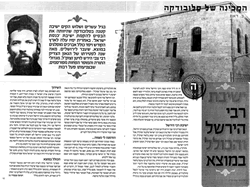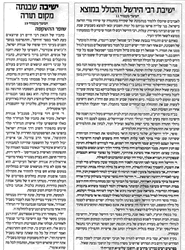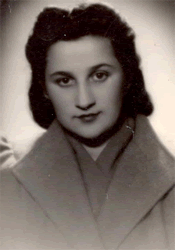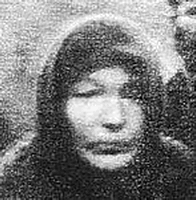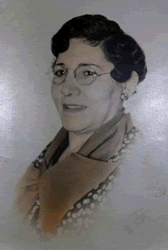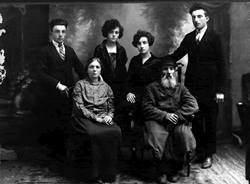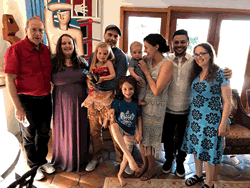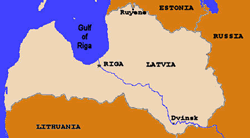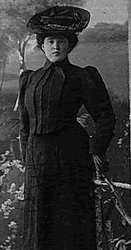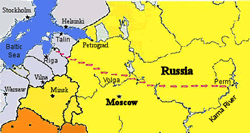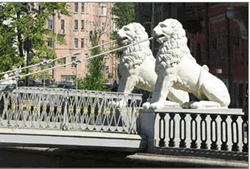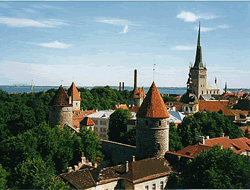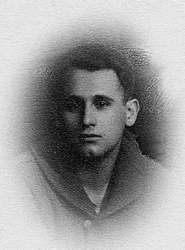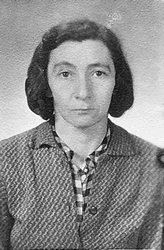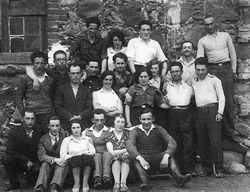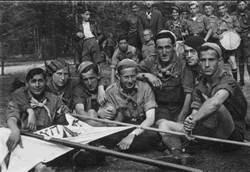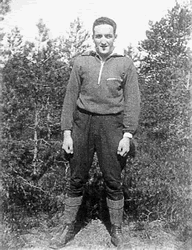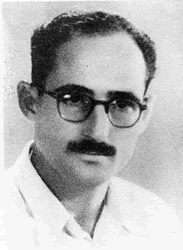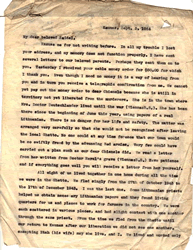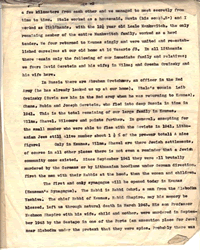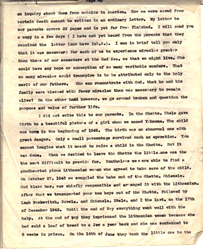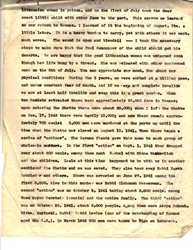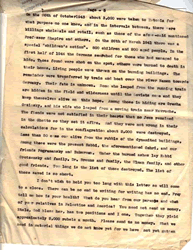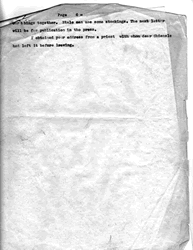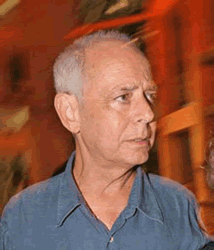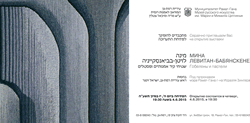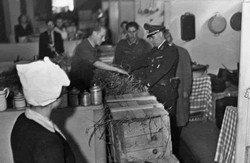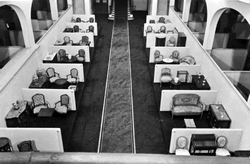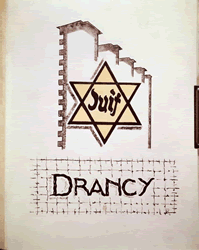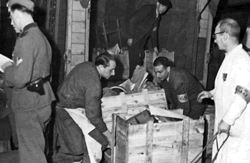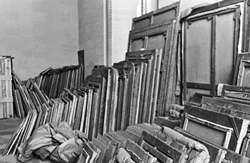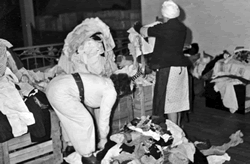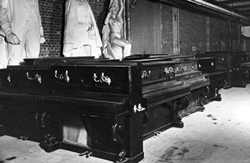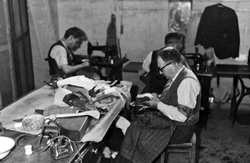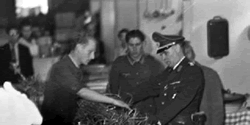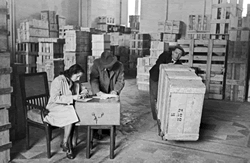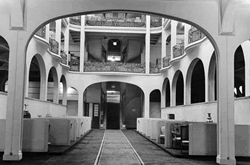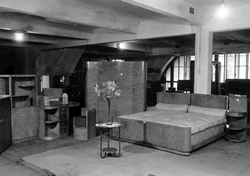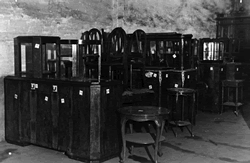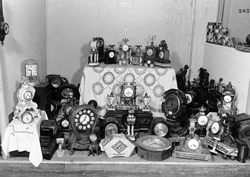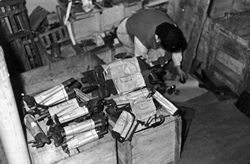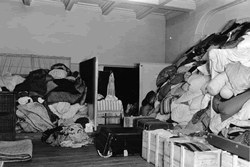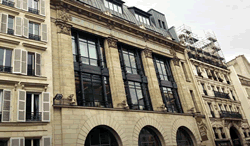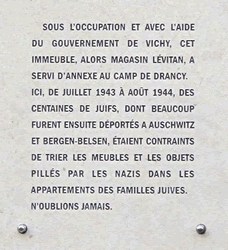was born in Kurenets c 1902. Badana came to Eretz Israel in 1924 and
married Yaakov Dori (1899–1973) who was the first
Chief of Staff of the Israel Defense Forces (IDF).
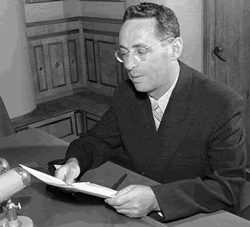
#lev-1a:
Yuri Levitan: a legendary Soviet announcer
Adolph Hitler considered Yuri Levitan his personal enemy and
promised to pay 250,000 marks for murdering him. Yuri Levitan worked
for the Soviet radio for 50 years. During the WW II he each day read
the most important news. Millions of people impatiently waited to hear
his voice. On May, 9, 1945 he announced the end to the war.

#lev-1b
Alon Levitan and Asher Book at the premier of the movie Fame (2009).
Alon wrote a song for the movie.
Alon Levitan composed the song "Try" for the movie "Fame"
http://www.vfactoryfans.com/news.php
Actor Asher Book said;
"Try" was his favorite song he sang in the movie and it was also his favorite scene to film.
To hear it go to;
http://www.amazon.com/gp/product/B002DYKW86?ie=UTF8&tag=ashboo-20&linkCode=as2&camp=1789&creative=390957&creativeASIN=B002DYKW86
-- Thanks,
Eilat Gordin Levitan
City Skuodas A view of the cobblestone street where the synagogue was located. (Left) boys pose outside M. Levitan's grocery store. (Left, Lithuanian sign advertising L. Levitan's tea shop which sold 'kvas' and lemonade.)
#lev-19:
Dr. Nachum and Dr. Ada Yeta Levitan
#lev-20:
Sara Levitan,
Purim, 2005
( in the blue dress)
#lev-21:
The wedding of Ilana and Ruben Levitan
#lev-22:
Ilana with ther three sons Daniel, Ed and Arnold – Boston 1963
#lev-23:
Levitan family and the in-law Yechiel Rosenbloom
#lev-24:
Wedding day of Ilana (nee Rosenbloon) Levitan with Famiily
#lev-25:
Ilana with one of her sons
#lev-26:
Ilana and Ruven levitan
#lev-28:
Dr. Ruven Levitan
#lev-35:
Ari Levitan's first hair cut.
#lev-36:
Dr. Ytzhak Levitan was born in Shavli in 1881. He studied Medicine in Berlin and settled in Kovno. He was sent with his wife to Siberia (by the Soviets) for Zionist activities. in 1947 he returned to Lithuania he was sent again to Siberia and died in the 1950s. His son, Dr Moshe Levitan, perished with his wife in Kovno in 1944.
#lev-37:
#lev-39:
#lev-39:
Leviatan family 2005. My wife, Rachel, my daughter Inbal (on the right), my son offir, (on the left) and Lior -- behind his parents. Also in the picture -- Tzur Kraus, Inbal's husband and our grand child Barry, and Pavani -- Offir's wife -- and their son Morrie, on his grandmother's lap.
Prof. Uriel Leviatan
Chair,
Department of Sociology and Anthropology and member,
Institute for Kibbutz Research University of Haifa
#lev-40:
Sanhedria orphanage in late 1947.
The little child in center of the picture (Flanged on both sides by two big boys) is Uriel Levitan, Son of Dr. Misha Levitan and Mira (daughter of Wolf Alperovitz) who perished in 1944 in Ghetto Kovno. His grandfather was the well known community leader and Zionist; Dr. Ytzhak Levitan of Kovno.
#lev-42:
Sarah, Jacob Hanna and Ari, children of Arnie and Janice Levitan
#lev-48:
Dr. Ruven Levitan and Mr. Meidan. Israel, 2006
#lev-49:
Raanana, March 2006 ; the grandaughters of Ariela nee Levitan and Ami Yaakobi (see #lev-51 &52)
#lev-50:
Raanana, March 2006 ; Doron Yaakobi
#lev-51:
Raanana, March 2006 ; Doron Yaakobi with his daughters. Doron is the son of Ariela (nee Levitan) and Ami Yaakobi.
#lev-52:
Raanana, March 2006 ; Doron Yaakobi with his daughters. Doron is the son of Ariela (nee Levitan) and Ami Yaakobi.
#lev-53:
Raanana, March 2006 ; Doron Yaakobi with his daughter.
#lev-54:
Arnold, Ruven, Nava, Yosi and Neta.
#lev-55:
Nava nee Levitan, Yosi, Neta, Uri Tal, Barak Nachsholy.
#lev-56:
( l-R) Rachel Gordin, Arnold Levitan, his father; Ruven Levitan,
Nava, Yosi and Neta.
#lev-57:
Uri Tal with his daughters; Neta and Limor and his son in law; Yosi.
#lev-58:
Sitting in the middle; Neta and her hasband Yosi. Next to Yosi is
his mother in law; Nava (nee Levitan) Tal. Next to her is her first
cousin; Reuven Levitan. all the way on the right ( cut) Newtas'
father; Uri Tal ( nee Rosental)
#lev-59:
Alon Levitan with relatives
#lev-60:
Alon Levitan with friends; Mike and Loui, his grandmother, Rachel
and Barak
#lev-61:
Alon Levitan with his grandmother; Rachel.
#lev-62:
Alon Levitan with his double relative; Nava nee Levitan. Navas'
father; Benzion, was the brother of Alons' great grandfather; Nachum.
Navas' mother; Gita, was the first cousin of Alons' great grandmother;
Lola nee Chait
#lev-63:
Carmel Levitan
#lev-64:
Carmel and Josh
#lev-65:
Carmel and Josh in China
#lev-66:
Carmel and Josh
#lev-67:
Carmel and Talia Levitan, daughters of Eilat Gordin and Daniel Levitan
#lev-76:
Carmel, Talia and their mother; Eilat Gordin Levitan with Tandra
#lev-77:
Carmel, Talia and Eilat Gordin Levitan with Josh Fisher and his
family, at the home of Tandra
#lev-78: Sitting in the middle the elderly rabinocvich from Shavli to the left is their son-in-law Nachum Levitan to the right is the german nanny of Ruven levitan next to her is Nachums sister Dr. Chienna Shereshevsky. Children are Ruven and Zvi, next to Zvi sits his nanny. Zvi Shereshevsky perished in Auzhwitz in 1944
#lev-79:
Gita Levitan nee Kriger and her daughters Ofra, Nava with Levitan relatives
#lev-80:
Dr. Daniel Levitan and Rabbi Yossi Baitelman
#lev-81:
Carmel Levitan PhD
#lev-82:
Alon with friends 2007
#lev-83:
Alon with friends 2007
#lev-84:
Alon with friends 2007
#lev-84a:
Hi Eilat,
I thought you would want these two matzevot photos from a Minsker plot
at
Montefiore Cemetery in NY.
Steven Lasky
www.museumoffamilyhistory.com
steve@museumoffamilyhistory.com
#lev-84b:
Hi Eilat,
I thought you would want these two matzevot photos from a Minsker plot
at
Montefiore Cemetery in NY.
Steven Lasky
www.museumoffamilyhistory.com
steve@museumoffamilyhistory.com
#lev-84c:
My grandmother and her children made a trip from South Africa to visit
the family in Lithuania just before the war.
This photo is of the Levin family (my grandmother's in-laws) taken in
Birzai sometime in 1938 (approx). The two children are my mother
(Lily) and uncle (Robert). My maternal grandmother Rochel is sitting
behind and between them.
The two older individuals are my grandfather's (Chona Levin) parents:
Zorach and Golda. The other individuals are unnamed unfortunately but
would likely include their children: Mina, Ruska, Israel, Mendel and
Rivka.
Mina went to live in the USA (Portland, Maine) – I think the others
stayed behind.
Dr. Wainer
#lev-84d:
Levitan, the principal of an ORT vocational school in Dvinsk
#lev-84e:
Carmel awarded her PhD
#lev-84f:
Carmel awarded her PhD
#lev-84g:
Carmel and Gerry in Bosnia.
for more pictures go to; http://josh.yosh.org/travel/
#lev-84h:
Drs. Joshua B. Fisher and Carmel Levitan in Dubrovnik. http://josh.yosh.org/travel/
#lev-86:
Our granddaughters
We`re happy to announce the birth of our twin
granddaughters, Na`ama and Romi.
Neta , the mother' and her daughters are feeling fine
and healthy.
NAVA ( nee Levitan) & URI Tal
#lev-87:
from;http://www.washingtonpost.com/wp-dyn/content/article/2007/12/08/AR2007120801543.html?referrer=emailarticle
Albert Viton was born Azriel Levitan in Tver, Lithuania, on Nov. 13, 1913, and immigrated with his family to the United States when he was in his teens. He grew up in Rock Island, Ill.
He changed his name when he decided in the 1930s to report from Nazi Germany for a Rock Island newspaper. But Mr. Viton was expelled and made his way to the Middle East.
He was in Palestine and other parts of the Middle East for three years, writing dispatches that were picked up by newspapers across the United States and Canada, as well as articles for the Nation, the Christian Century and Asia Magazine.
In 1940, he wrote about the Nazi policy of shipping skilled workers from occupied countries to Germany, liquidating the intelligentsia and consigning thousands to concentration camps. "Why don't the Czechs and Poles rebel?" he asked. "Thousands have asked this question. But this question reveals habits of mind formed under liberal democracy -- and blissful ignorance of the techniques of Fascist rule".....
His wife, Elaine Hofsteede Viton, died in 1993.
Survivors include three children, Philip Viton of Columbus, Ohio, Gail Fischberg of New York and Karen Dunster of Thurgarton, England; two brothers; a sister; and three grandchildren.
#lev-88:
Alon Levitan and his aunt Anat Geffen
#lev-89:
Alon Levitan and his aunt Anat Geffen
#lev-90:
Eran Gordin and Alon Levitan
#lev-91:
Eran Gordin and Alon Levitan
#lev-92:
Alon and Ruven Levitan
#lev-93:
Miri Dick Ph.D with her second cousin once removed: Carmel Levitan Ph.D. Miri is the grandaughter of Hela Hinda Ripshtein nee Herlberg the sister of Ester Rosenblum nee Helberg ( Carmels" Great grandmother)
Hela Hinda and Ester were daughters of Shmuel HELBERG and Sara nee RAKOWER Born in 1870, Krakow
#lev-94:
Melbourne, 2008. middle; Yael Wolfson, grandaughter of Jenia Chait Viniar ,with her second cousin once removed, Carmel Levitan. Carmel is the great granddaughter of Jenia' sister; Lola (nee Chait) Gordin Moher. The guy in the picture is Yael' husband, Moshe Wolfson
#lev-95:
Daniel Levitan and Shimon Kristal, Afikim, 2008
#lev-96:
From left; Eran Gordin, Eilat Gordin Levitan, Daniel Levitan, Carmel Levitan and Shimon Kristal and his wife. Afikim, 2008
#lev-97:
Shimon Kristals' grandson
#lev-98:
Rachel Gordin, Barak Nachsholi, Daniel Levitan, Eilat Gordin Levitan
#lev-99:
Sitting: Daniel Levitan, Eilat Gordin Levitan Standing: Tzafrir Gordin ( Tzafy)
#lev-100a:
From left: Barak Nachsholi, Daniel Levitan, Rachel Gordin, Carmel Levitan, Kathleen Burk ( Gordin)
#lev-100b:
Eran Gordin and Carmel Levitan
#lev-100c:
Naama and Romi: grandaughters of Nava (nee Levitan)
Great grandaughters of Gita ( nee Kriger) and Ben Zion Levitan
Great great grandaughters of Sheina ( nee Levin) and Leib Kriger ( son of Gitl and Zusia Kriger)
#lev-101:
Talia Levitan and her boyfriend Jason Sanchez in Chile, 2008
#lev-102:
ISRAEL, DECEMBER 2008
#lev-103:
ISRAEL, DECEMBER 2008
#lev-104:
ISRAEL, DECEMBER 2008
#lev-105:
ISRAEL, DECEMBER 2008
#lev-106:
ISRAEL, DECEMBER 2008
#lev-117:
ALIZA HELBERG WITH DANIEL LEVITAN (THE SON OF HER FIRST COUSIN ILANA) EILAT GORDIN LEVITAN, RACHEL GORDIN AND EFRAIM BEN YAKIR ( SITTING)
DECEMBER 2008
#lev-118:
Isaac Levitan: Autumn Day, 1879
Nosson Notte Yerachmiel [Levitan] Litvin Icn_world Icn_collaborator_both_14
Birth: 1873
Lithuania
Death: July 16, 1941 (68)
Immediate Family:
Son of Yisroel Meir Levitan and Gittel Levitan
Husband of Fruma Devorah [Yacobson] Litvin and Toibe 'Alta' [Levinson] Litvin
Father of Yitzchak Dovid [Levitan] Litvin; Yisroel Litvin; Leib
Litvin; Rivka Litvin; Moshe Litvin; Avraham Yehoshua Litvin; Yoseph
[Yossa] Litvin; Zlatte [Lottie Glaser] Litvin and Miriam [Meras]
Litvin « less
Brother of Benzion Ya'akov Levitan; Bat-Sheva [Levitan] Shach;
Toube-Dine Sher; Movsha-Faivish Levitan; Azriel Moshe Levitan; Osher
Nissan Levitan; Movsha Levitan and Rivka Litvin
#lev-122:
Azriel Moshe Levitan Icn_world Icn_collaborator_both_14
Birth: July 2, 1879
Pumpenai, Lithuania
Death: November 8, 1915 (36)
Kiev, Russia
Immediate Family:
Son of Yisroel Meir Levitan and Gittel Levitan
Husband of Masha [Polonsky] Levitan
Father of Yocheved Metzger; Judith [Levitan] Shapiro and Jack Levitan
Brother of Benzion Ya'akov Levitan; Bat-Sheva [Levitan] Shach;
Toube-Dine Sher; Nosson Notte Yerachmiel Litvin; Movsha-Faivish
Levitan; Osher Nissan Levitan; Movsha Levitan and Rivka Litvin
#lev-123:
#lev-124:
Yehudit and Yoceved daughters of Azriel Levitan
#lev-125:
Bat-Sheva Shach (Levitan)
Birth: 1867
Siauliai (Shavil), Lithuania
Death: September 22, 1939 (72)
Vabalninkas, Lithuania
Daughter of Yisroel Meir Levitan and Gittel Levitan
Wife of Azriel Shach
Mother of Elazar Shach; Esther Singer; Asher Shach; Israel Shach;
Shraga Shach; Henya Shach; Gittel Shach; Fayga Ettil Shach and Avraham
Shach « less
Sister of Benzion Ya'akov Levitan; Toube-Dine Sher; Nosson Notte
Yerachmiel Litvin; Movsha-Faivish Levitan; Azriel Moshe Levitan; Osher
Nissan Levitan; Movsha Levitan and Rivka Litvin
#lev-126:
#lev-127:
This is a photo taken in Miami, Florida circa 1954. Left to right:
Fannie Miller, Solomon Miller, Minnie Ziman Levitan, Abraham Levitan .
Minnie and Abraham were the parents of Hyman Robert Levitan.
Thanks,
Robin Meltzer
#lev-128:
From: Robin Meltzer
Minnie Ziman Levitan in St. Petersburg, Russia ca 1900.
#lev-129:
Masha Levitan (Polonsky)
Birth:
1884
Siauliai (Shavil), Lithuania
Death:
July 20, 1958 (74)
Johannesburg, South Africa
I
Daughter of Yakov [Yankel Jacob] Polonsky and Libe Riva [Kook] Polonsky
Wife of Azriel Moshe (Azriel Movsha) Levitan
Mother of Yocheved Metzger; Judith [Levitan] Shapiro; Jack Levitan and (No Name)
Sister of Reuven (Robert) Polonsky; Keile Melman; Eliezer (Lazer) Pelunsky and Dina Burland
#lev-130:
Azriel Moshe (Azriel Movsha) Levitan
Birth:
July 2, 1879
Pumpenai, Lithuania
Death:
November 8, 1915 (36)
Kiev, Russia
Immediate Family:
Son of YIisroel Meir Levitan and Gittel [surname unknown] Levitan
Husband of Masha Levitan
Father of Yocheved Metzger; Judith [Levitan] Shapiro; Jack Levitan
Brother of Bat-Sheva [Levitan] Shach; Benzion Ya'akov Levitan; Toube-Dine Esther Leah Sher; Nosson Notte Yerachmiel [Levitan] Litvin; Movsha Faivush Levitan; Osher Nissan Levitan;
#lev-131:
Bat-Sheva Shach (born Levitan)
Birth:
1867 - Siauliai (Shavil), Lithuania
Death:
Sep 22 1939 - Vabalninkas, Lithuania
Parents:
Yisroel Meir Levitan and Sora- Gena (Gittel) Levitan
Daughter of YIisroel Meir Levitan and Gittel
Wife of Rabbi Azriel Shach
Mother of Rabbi Eliezar Menachem Mann Sach / ??? ????? ???? ?? ??; Esther Singer; Asher Shach; Israel Meier Shach; Avraham Itzchak Shach Shraga Feivel Shach; Henya Shach; Gittel Rivka Shach and Fayga Ettil Shach
Sister of Benzion Ya'akov Levitan; Toube-Dine Esther Leah Sher; Nosson Notte Yerachmiel [Levitan] Litvin; Movsha Faivush Levitan; Osher Nissan Levitan; Azriel Moshe (Azriel Movsha) Levitan;
#lev-132:
Benzion Ya'akov Levitan
Birth:
1865 - Siauliai (Shavil), Lithuania
Death:
1938 - Sidleva, Lithuania
#lev-133:
Nosson Notte Yerachmiel [Levitan] Litvin
Birth:
1873
Lithuania
Death:
July 16, 1941 (68)
Immediate Family:
Son of YIisroel Meir Levitan and Gittel [surname unknown] Levitan
Husband of Fruma Devorah Levitan; Taibe Alba Levitan (Litvin); Fruma Devorah [Yacobson] Litvin and Toibe 'Alta' [Levinson] Litvin
Father of Yitzchak Dovid [Levitan] Litvin; Yisroel Litvin; Leib Litvin; Rivka Litvin; Moshe Litvin; Avraham Yehoshua Litvin; Yoseph [Yossa] Litvin; Zlatte [Lottie Glaser] Litvin and Miriam [Meras] Litvin
#lev-135:
JACK LEVITAN
#lev-136:
Judith [NEE Levitan] Shapiro
#lev-137:
Nathan Yeshayahu Levitan
1910 - 1955
and
Aug 30 1910
Siauliai son of
Rabbi Osher Nison Levitan
1879 - 1956
Yocheved Hinda Rapoport Levitan
1884 - 1944
#lev-138:
Judith Shapiro(1913
Siauliai - 1998 South Africa) and Yocheved Metzger (1911
Siauliai - 1996 South Africa) daughters of Azriel Moahe and Masha Levitan
#lev-139:
Levitan Story
#lev-140:
Hi,
My name is Azriel Abramovich. <aabramovich@gmail.com>
My wife's name is Ephrat Levitan (not a big clan, is it?!)
My grandfather's name was Azriel Abramovich it's my grandad in photo 21 on Siualai page.. His wife? Mania (Marija) Gordon.
So you can see how there's an overlap. Coincidence?
My side of the family is from Siualai, before the war, and Vilnius after. My wife's side is from Kaunas. Don't know if any of this makes sense to you...
I don't know if there's any relation, but... Who knows.
Happy to share any knowledge of history I have, though you seem to have done significantly more than me. Jews in the Siauliai ghetto, Lithuania, standing in a roll call assembly opposite uniformed Germans, beside the "Red Prison" before being taken for extermination. The Jews were taken to Kuziai, where they were killed. In the photo: Rabbi Nachumowski, Shapira, Rosenberg, and Abramowicz, an attorney.
Azriel
#lev-141:
Asne Lewitas perished in the holocaust
#lev-142:
Bat-Sheva Shach (Levitan)
Gender:
Female
Birth:
1867
Siauliai (Shavil), Lithuania
Death:
September 22, 1939 (72)
Vabalninkas, Lithuania
Immediate Family:
Daughter of Yisroel Meir Levitan and Sora-Gena [surname unknown] Levitan
Wife of Rabbi Azriel Shach
Mother of Rabbi Eliezar Menachem Mann Shach; Esther Singer; Asher Shach; Israel Meier Shach; Avraham Itzchak Shach Feivel Shach; Henya Shach; Gittel Rivka Shach and Feyga Etil Shach
Sister of Benzion Ya'akov Yaakov Levitan; Toube-Dine Esther Leah Sher; Nosson Notte Yerachmiel [Levitan] Litvin; Movsha Faivush Levitan; Osher Nissan Levitan; and Azriel Moshe (Azriel Movsha) Levitans
#lev-143:
From: Kevin Brownstein <kevin.brownstein@gmail.com>
Date: Fri, Jul 5, 2019 at 9:52 AM
My great-grandmother, Rebecca Levitan immigrated from Krekenava to the US around 1900. Attached is a picture of my great-grandmother and a picture she kept with her family pictures that we are unable to identify. It looks very much like other pictures on your website. Likely it is from between 1915-1920. If anyone recognizes anyone from their family photos or can identify the studio, I would appreciate it.
Thank you again for making this information available to appreciate and remember.
Kevin
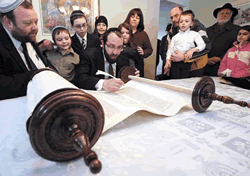
#lev-150:
Rabbi Betzalel Shur finishes a letter on a restored scroll as members of Wilmette's North Shore Jewish Center-Congregation Or Simcha observe. The restored Torah scroll is the first that belongs to the young congregation ( including the Levitan family of Arnie and Janis, on the left) http://www.pioneerlocal.com/wilmette/news/873492,wi-torah-040308-s1.article

#lev-151:
Bob Levitan, Ben Hecht captain
Historians and Family Remember the SS Ben Hecht
for pictures go to;
http://wymaninstitute.org/special/photoexhibit2.php
by Ezra HaLevi
(IsraelNN.com) Dozens of ships attempted to bring Holocaust survivors
past the British blockade of pre-state Israel in the 1940s, but only a
few - including the S.S. Ben Hecht - managed to become entangled in
controversies on three different continents. The 60th anniversary of
the voyage of the Ben Hecht was recounted by historians and relatives
of the boat's captain at an event near Washington, D.C. earlier this
week.
The commemoration of the voyage was sponsored by The David S. Wyman
Institute for Holocaust Studies, and took place at the Silver Spring
Jewish Center, in Silver Spring, Maryland.
Barbara Randall of Florida, the daughter of Ben Hecht captain Bob
Levitan, was one of the featured speakers. She said her father "simply
recognized that it was his obligation to do what he could to help the
survivors of the Holocaust. It was nothing more complicated than
that."
Captain Levitan's grand-nephew, David Miller of Silver Spring, also
spoke. Miller recalled that as a child, he often heard stories from
relatives about how when the Ben Hecht crew members were arrested and
sent to Acre Prison, Levitan had a camera with him. "Because the crew
were Americans, the British guards didn't think of them as a security
risk, so they didn't carefully search them," Miller said. That camera
was used to make false identification papers that helped facilitate
the May 1947 Acre Prison breakout. "Uncle Bob didn't have to get
involved in this dangerous mission," Miller said. "At the end of the
war, he could have just returned to his normal civilian life. Instead,
he risked himself to try to crash the British blockade - just because
it was the right thing to do."
Levitan's niece, Dr. Carol Rose, came from Pittsburgh to take part in
the event.
The audience viewed a video interview with Captain Levitan, in which
he recalled the voyage. "Many of the crew members were not even
Jewish," he remembered. "Two were Norwegian-Americans. One was black.
Like me, they were just sick of the world kicking the Jews around, and
they wanted to help." ..... for the rest go to;
http://www.israelnationalnews.com/News/News.aspx/121730
My father's sister, (Sala) was married to a man named Avraham Lewitan. He was
born in Warsaw, Poland.
Avraham's father, named Yeshayahu was born in Siaului, Lithuania (if I'm not
mistaken) and settled in Warsaw. Avraham is the only member of the family,to
have survived(he survived the Warsaw ghetto uprising together with his wife and
daughter, only to be caught in a burning building (Aprill 1943), to be sent to
Treblinka(he survived this camp and several others) this is how we know who and
how they perished. Avraham had a sister who emigrated to Israel(early 1930's),
and they were in the construction business. Avraham settled in Eretz Yisrael
after the war and remarried.
Would Avraham Lewitan be any relation?
He passed away only a couple of years ago. I recently was told this story and
I'm sorry I never met him.
Geri Levine (geri@levinecorp.com)
Panevezys
Kaunas 22/11/1894
Kislev 6 RABINOVICH, Beinus LEVITAN, Taube Dina Mordukh
Lepel Isroel Meier
Seduva 34 24 Groom Is a widower FRIDMAN Mordkhel SHULMAN Girsh Eliash FUKS
Age Died Page Number Row Grave
LEVITAN Leah Zelik Krishchiukaichio Ant. 1860 16MarKheshvan5704
14Nov1943 45 150 20 3
LEVITAN Zalman Abba - - 26Iyyar5703
31May1943 42 86 16 18
LEVITON Sarah-Etel Wolf Griniaus 19 76 y 5Shevat5702
23Jan1942 20 39
LEVITAN Meir-Zusha (textile store
Name
(Other Surnames) Date of Death Date of Birth
/ Age More Information Cemetery Name / City / Country
HELMAN, Yosef
(LEVITAN) 31-May-1943 14-Nov-1941 View Full Burial Record Viliampole Chevra Kadisha, 1941-1943 / Kovno / Lithuania
LEVITAN, Zalman
(KARPELOVITZ) 23-Mar-1943 Age: 31 View Full Burial Record Viliampole Chevra Kadisha, 1941-1943 / Kovno / Lithuania
LEVITAN, Leah
(YOSELEVITZ) 05-Aug-1943 09-Feb-1942 View Full Burial Record Viliampole Chevra Kadisha, 1941-1943 / Kovno / Lithuania
LEVITAN, Chaim Tzvi 1872 View Full Burial Record / Jurbarkas / Lithuania
LEVITAN, Sarah Feiga View Full Burial Record / Jurbarkas / Lithuania
LEVITAN, Zalman View Full Burial Record / Jurbarkas / Lithuania
LEVITON, Sarah-etel
(FISHELEVITZ) 23-Feb-1943 1873 View Full Burial Record Viliampole Chevra Kadisha, 1941-1943 / Kovno / Lithuania
ROZENBLIUM, Avraham-mordecai
(LEVITAN) 14-Nov-1943 1932 View Full Burial Record Viliampole Chevra Kadisha, 1941-1943 / Kovno / Lithuania
WILENCHIK, Devorah
(LEVITON) 23-Jan-1942 1922 View Full Burial Record Viliampole Chevra Kadisha, 1941-1943 / Kovno / Lithuania
Day Month Year Address Town Uyezd Name
(Maiden Name) Marital Status Father Relationship to
Head of Household Age Place of Birth Left Reason Left Passport # Occupation Comments Record Type Archive/Fond/Inventory/File
8 June 1926 Klaipedos st. 44 Panevezys Panevezys LEVITAN, Moshe single Haim
25-Jan-10 1938 naturalized the British citizenship 452/885252 schoolboy Internal Passport LCVA/1264/3/10958
26 Sep 1924 Klaipedos st. 44 Panevezys Panevezys LEVITAN, Khaya single
10-Oct-04 Panevezys 290/709653 schoolgirl Internal Passport Application LCVA/1264/3/10618
7 Aug 1931 Klaipedos st. 52 Panevezys Panevezys LEVITAN, Pesa single Haim
29-May-11 Panevezys 274/1433474 employee Internal Passport Application LCVA/1264/3/10589
23 June 1920 Sinagogos st. 4 Panevezys Panevezys KOTZIN, Abraham Berel married Yosel Head of the household 5 Aug 1879 Panevezys 1010/121412 butcher Internal Passport Application LCVA/1264/3/10220
KOTZIN, Tsipe
(MINOK) married Wife 28 in 1920 Kedainiai 1012/121414 Internal Passport Application LCVA/1264/3/10220
KOTZIN, Gite
(LEVITAN) widow Simeon Mother 67 in 1920 Panevezys 22-Dec-30 Died 1011/121413 butcher Internal passport is in the file Internal Passport Application LCVA/1264/3/10220
KOTZIN, Bentsel Abraham Berel Son 4 in 1920 Internal Passport Application LCVA/1264/3/10220
KOTZIN, Sora Abraham Berel Daughter 1 in 1920 Internal Passport Application LCVA/1264/3/10220
21 Nov 1924 Jonava Jonava Kaunas LEVITIENE / [LEVIT], Mera Riva
33 in 1924 Jonava 2974/1241856 home help Internal Passport Card KRA/71/3/1744
26 Apr 1920 Kaunas Kaunas Kaunas BLIUMBERGIENE / [BLIUMBERG], Leah Rayne
(LEVITANYTE / [LEVITAN])
61 in 1920 Kaunas 1921/56721 housewife Passport Card KRA/66/1/1921
Day Month Year Address Town Uyezd Name
(Maiden Name) Marital Status Father Relationship to
Head of Household Age Place of Birth Left Reason Left Passport # Occupation Comments Record Type Archive/Fond/Inventory/File
1 Mar 1930 Panevezys Panevezys Panevezys LEVITIENE / [LEVIT], Olga
(SMUKLERAITE / [SHMUKLER]) Bentsion
born in 1900 Vilnius 98/1058558 housewife The First Internal Passport Nr. 147/61748 issued in Baisogala 31 May 1920 and the certificate of second Marriage Nr. 1867 issued in Kaunas 9 Dec 1929 are in the file. Her surname from the first marriage was KAPLAN. Second Internal Passport Application LCVA/1264/3/11215
1925 various towns in Kaunas Uyezd Kaunas LEVITANAS / [LEVITAN], Leib
440 Internal Passport Application LCVA/402/1vp/2
1925 various towns in Kaunas Uyezd Kaunas LEVITANAS / [LEVITAN], Isaac
1262 Internal Passport Application LCVA/402/1vp/2
1925 various towns in Kaunas Uyezd Kaunas LEVITANAS / [LEVITAN], Volf
2369 Internal Passport Application LCVA/402/1vp/2
1925 various towns in Kaunas Uyezd Kaunas LEVITANAS / [LEVITAN], Shreider Zelman
2372 Internal Passport Application LCVA/402/1vp/2
1925 various towns in Kaunas Uyezd Kaunas LEVITONYTE / [LEVITON], Sara
4187 Internal Passport Application LCVA/402/1vp/2
27 Oct 1920 Kaunas Kaunas Kaunas EIRUFAS / [EYRUF], Girsh
49 in 1920 Kaunas 17681/460363 carrier Passport Card KRA/66/1/17681
EIRUFAS / [EYRUF], Shmuel Ayzik
born in 1901 Kaunas 44426/? carrier Passport Card KRA/66/1/44426
EIRUFAS / [EYRUF], Kadish Benjamin Girsh
born in 1911 Vilijampole (Kaunas) 6854/1124537 tailor Passport Card KRA/66/1/6854
EIREFAS / [EYREF], Iser Girsh
born in 1908 Kaunas 2724/1506702 metal-worker Passport Card KRA/66/1/2724
EIRUFIENE / [EYRUF], Rochel
(ARONOVSKAITE / [ARONOVSKY])
46 in 1920 Vilijampole (Kaunas) 17874/460283 housewife Passport Card KRA/66/1/17874
EIRUFIENE / [EYRUF], Zlate
(LEVITANAITE / [LEVITAN]) Abram Vigdor
born in 1906 Kaunas 6855/1124536 housewife Passport Card KRA/66/1/6855
EIRUFAITE / [EYRUF], Basel
20 in 1920 Vilijampole (Kaunas) 17873/460282 dressmaker Passport Card KRA/66/1/17873
EIRUFAITE / [EYRUF], Riva
18 in 1924 Kaunas 40574/1238644 modiste Passport Card KRA/66/1/40574
EIRUFAITE / [EYRUF], Estera Girsh
born in 1914 Kaunas 15102/1438852 Passport Card KRA/66/1/15102
EIRUFYTE / [EYRUF], Mere
born in 1906 Kaunas 39393/1236048 dressmaker Passport Card KRA/66/1/39293
Day Month Year Address Town Uyezd Name
(Maiden Name) Marital Status Father Relationship to
Head of Household Age Place of Birth Left Reason Left Passport # Occupation Comments Record Type Archive/Fond/Inventory/File
11 May 1931 Kaunas Kaunas Kaunas FRIZERIENE / [FRIZER], Freyde
(LEVITANAITE / [LEVITAN]) Leyb
born in 1891 Kaunas 13381/1416074 housewife Passport Card KRA/66/1/13381
21 Jan 1939 Kaunas Kaunas Kaunas GEICENIENE / [GEYTSEN], Gita
(LEVITANAITE / [LEVITAN])
born in 1921 Russia 294/104631 housewife Mera's daughter Passport Card KRA/66/1/294
2 Mar 1922 Kaunas Kaunas Kaunas GERVISIENE / [GERVIS], Chase
(LEVITANYTE / [LEVITAN])
45 in 1922 Seduva 29703/822453 housewife Passport Card KRA/66/1/29703
July 1932 Kaunas Kaunas Kaunas LEVITANAS / [LEVITAN], Mendel
2436 Internal Passport Application LCVA/402/1vp/76
3 July 1920 Kaunas Kaunas Kaunas HAIFECIENE / [HAYFETS] / [HEYFETS], Mina
(LEVITANAITE / [LEVITAN])
28 in 1920 Radun, Lida uyezd 8008/251264 housewife Internal Passport Card KRA/66/1/8008
9 Aug 1922 Kaunas Kaunas Kaunas CHVOLESIENE / [KHVOLES], Rocha Riva
(LEVITANAITE / [LEVITAN])
42 in 1922 Kaunas 33621/941252 housewife Internal Passport Card KRA/66/1/33621
CHVOLESAITE / [KHVOLES], Sheyna Freyda
born in 1900 Kaunas 33620/941223 Internal Passport Card KRA/66/1/33620
26 Feb 1921 Kaunas Kaunas Kaunas KACIENE / [KATS], Krayne
(LEVITANYTE / [LEVITAN])
born in 1888 Vilijampole (Kaunas) 23025/500655 housewife Internal Passport Card KRA/66/1/23025
2 Sep 1920 Kaunas Kaunas Kaunas LACHBERGIENE / [LAKHBERG], Rachil
(LEVITANYTE / [LEVITAN])
born in 1886 Kaunas 14255/452110 housewife Internal Passport Card KRA/66/1/14255
2 June 1929 Kaunas Kaunas Kaunas LEVITIENE / [LEVIT], Ester
(ZELBOVICAITE / [ZELBOVICH]) Chaim Movsha
22 in 1929 Pandelys 5693/1349365 housewife Internal Passport Card KRA/66/1/5693
Day Month Year Address Town Uyezd Name
(Maiden Name) Marital Status Father Relationship to
Head of Household Age Place of Birth Left Reason Left Passport # Occupation Comments Record Type Archive/Fond/Inventory/File
192? Kaunas Kaunas Kaunas LEVITANAS / [LEVITAN], Abram Gershon Itsik Leyzer
born in 1910 Vilijampole (Kaunas) 6267/1123653 tailor Internal Passport Card KRA/66/1/6267
2 Nov 1936 Kaunas Kaunas Kaunas LEVITANAS / [LEVITAN], Zalman David
born in 1902 Veliuona 3165/15300 worker Internal Passport Card KRA/66/1/3165
5 July 1934 Kaunas Kaunas Kaunas LEVITANAS / [LEVITAN], Salmon Isaak Zisman
born in 1919 Kaunas 1695/1536646 student Internal Passport Card KRA/66/1/1695
10 Feb 1933 Kaunas Kaunas Kaunas LEVITANAS / [LEVITAN], Hone Yudel
born in 1914 Raseiniai 471/1505251 worker Internal Passport Card KRA/66/1/471
3 Sep 1931 Kaunas Kaunas Kaunas LEVITANAS / [LEVITAN], Mikhel Itsik
born in 1913 Tcekhanov?, Russia 14930/1438624 student Internal Passport Card KRA/66/1/14930
4 July 1931 Kaunas Kaunas Kaunas LEVITANAS / [LEVITAN], Shlioma Mordkhel
born in 1902 Kaunas 14261/1437166 tinsmith Internal Passport Card KRA/66/1/14261
11 Apr 1928 Kaunas Kaunas Kaunas LEVITANAS / [LEVITAN], Ayzik Nisel
born in 1910 Kedainiai 2427/1297671 shopman Internal Passport Card KRA/66/1/2427
13 Jan 1927 Kaunas Kaunas Kaunas LEVITANAS / [LEVITAN], Ilia
born in 1908 Kaunas 97/1279984 metal-worker Internal Passport Card KRA/66/1/97
16 Nov 1926 Kaunas Kaunas Kaunas LEVITANAS / [LEVITAN], Zundel
born in 1896 Kaunas 48111/1279480 merchant Internal Passport Card KRA/66/1/48111
3 Nov 1926 Kaunas Kaunas Kaunas LEVITANAS / [LEVITAN], Yudel Abel
born in 1901 Kaunas 47996/1279340 Internal Passport Card KRA/66/1/47996
Day Month Year Address Town Uyezd Name
(Maiden Name) Marital Status Father Relationship to
Head of Household Age Place of Birth Left Reason Left Passport # Occupation Comments Record Type Archive/Fond/Inventory/File
13 Feb 1925 Kaunas Kaunas Kaunas LEVITANAS / [LEVITAN], Shneyer Zalman
62 in 1925 Kaunas 42603/1244845 merchant Internal Passport Card KRA/66/1/42603
28 June 1923 Kaunas Kaunas Kaunas LEVITANAS / [LEVITAN], Zelman David
born in 1903 Kaunas 36913/1232153 worker Internal Passport Card KRA/66/1/36913
10 Feb 1925 Kaunas Kaunas Kaunas LEVITANAS / [LEVITAN], Isaak Wolf
born in 1903 Kaunas 42551/1244789 shopman Internal Passport Card KRA/66/1/42551
26 June 1923 Kaunas Kaunas Kaunas LEVITANAS / [LEVITAN], Abram Avigdor
born in 1875 Kaunas 36911/1232154 worker Internal Passport Card KRA/66/1/36911
Name Father Mother Spouse Residence Comments Date of Death
DD/MM/YY
Hebrew Date Age Cause of Death Town Uyezd Guberniya Place Recorded Year Record # Microfilm
Item
Image
Archive / Fond
HERR LEVITAN, Khana Ber Nokhum Khaia Seduva, Panevezys district The deceased a widow-was a housewife;She buried on 10-Oct-1935 in Seduva cemetery. Document No.609 in centre archive.Her Maiden Name-LEVITAN 9/10/1935
12 Tishri 5696 1852 old age Seduva Panevezys Panevezys 1935 F 75 Not Filmed
LVIA/1817/1/216
KACIENE / [KATZ], Mariasha Josif Ber Khaia SABAN Siauliniai The deceased a widow-was a housewife;She died in Jewish hospital,buried on 27-Feb-1927 in Panevezys Jew cemetery. Document No.53 in centre archive.Her maiden name-LEVITAN 25/2/1927
23 Adar I 5687 65 paralysis Panevezys Panevezys Panevezys 1927 F 8 Not Filmed
LVIA/1817/1/216
KOCINIENE / [KATZIN], Gita Simon Eiga Panevezys, Rabbi Itsel str.13 The deceased a widow-was a meatwoman;She died in one's apartment,buried on 23-Dec-1930 in Panevezys Jew cemetery. Document No.349 in centre archive.Maiden name-LEVITAN 22/12/1930
2 Tevet 5691 77 heamiplegia Panevezys Panevezys Panevezys 1930 F 105 Not Filmed
LVIA/1817/1/216
LAPATIENE / [LAPATA], Cipe Hene Siauliai widow 25/2/1937
87 pneumonia Siauliai Siauliai Kaunas Siauliai 1937 17 Not filmed
LVIA1817/1/276
LEVITAN, Chaim Leyba Itsik Kamajai 10/11/1884
2 Rokiskis Panevezys Kaunas Rokiškis 1884 Not filmed
KRA/210/1/621/29
LEVITAN, Maushe Berel Leizer Mera Reiza Krekenava, Panevezys district The deceased a married-was a meatman;He buried on 24-Jun-1935 in Krekenava. Document No.374 in centre archive 23/6/1935
22 Sivan 5695 76 heart disease Krekenava Panevezys Panevezys 1935 M 57 Not Filmed
LVIA/1817/1/216
LEVITAN, Abram Itsyk Ieishua Panevezys, Sodu str.15 The deceased a widow; She died in one's apartment,buried on 3-Oct-1937 in Panevezys Jew cemetery. Document No.720/722 in centre archive 2/10/1937
27 Tishri 5698 76 old age No.78 Panevezys Panevezys Panevezys 1937 M 73 Not Filmed
LVIA/1817/1/216
LEVITAN, Masha Zelig Dveira ZIBEL Seduva, Kedainiu str. The deceased a girl ;She died in Jewish hospital,buried on 15-Apr-1938 in Panevezys Jew cemetery. Document No.243/245 in centre archive 14/4/1938
13 Nisan 5698 6 diphteria toxica No.7 Panevezys Panevezys Panevezys 1938 F 21 Not Filmed
LVIA/1817/1/216
LEVITAN, Cherna Iakov Lieba Krekenava, Panevezys district The deceased a widow-was a housewife;He buried on 17-Jun-1940 in Krekenava. Document No.749-750 in centre archive.Maiden name-VARKUL 16/6/1940
10 Sivan 5700 69 diabetes No.27,angina pectoris No.42, maiciditis No.37 Kaunas Kaunas Panevezys 1940 F 63 Not Filmed
LVIA/1817/1/216
LEVITANAS / [LEVITAN], Jekelis Smuelis Elija Fruma Siauliai 1/11/1924
4 Heshvan 63 cancer Siauliai Siauliai Kaunas Siauliai 1924 M20 Not filmed
LVIA1817/1/269
Name Father Mother Spouse Residence Comments Date of Death
DD/MM/YY
Hebrew Date Age Cause of Death Town Uyezd Guberniya Place Recorded Year Record # Microfilm
Item
Image
Archive / Fond
LEVITANAS / [LEVITAN], Smuelis Jankelis Siauliai widower 17/10/1925
29 Tishri 85 old age Siauliai Siauliai Kaunas Siauliai 1925 M19 Not filmed
LVIA1817/1/272
LEVITANAS / [LEVITAN], Leiba Smuelis Jankelis Chava DOGOLAICERAITE / [DOGOLAICER] Siauliai 8/12/1929
6 Kislev 1876 heart disease Siauliai Siauliai Kaunas Siauliai 1929 M44 Not filmed
LVIA1817/1/272
LEVITANIENE / [LEVITAN], Rachile Jankelis MATEMATIKAS / [MATEMATIK] Siauliai widow 7/11/1927
12 Heshvan 1880 heart paralysis Siauliai Siauliai Kaunas Siauliai 1927 72 Not filmed
LVIA1817/1/272
LEVITANIENE / [LEVITAN], Chane Siauliai widow 23/2/1930
22 Shevat 66 heart disease Siauliai Siauliai Kaunas Siauliai 1930 9 Not filmed
LVIA1817/1/272
LEVITANIENE / [LEVITAN], Riva Leja Siauliai widow 18/5/1931
2 Sivan 70 cancer Siauliai Siauliai Kaunas Siauliai 1931 F13 Not filmed
LVIA1817/1/272
LEVITANIENE / [LEVITAN], Liba Siauliai widow 4/1/1937
85 old age Siauliai Siauliai Kaunas Siauliai 1937 1 Not filmed
LVIA1817/1/276
LEVITANIENE / [LEVITAN], Chiene Siauliai widow 20/9/1937
67 cancer Siauliai Siauliai Kaunas Siauliai 1937 55 Not filmed
LVIA1817/1/276
LEVITANIENE / [LEVITAN], Elka Siauliai widow 19/3/1939
1869 heart disease Siauliai Siauliai Kaunas Siauliai 1939 22 Not filmed
LVIA1817/1/276
LEVITANUS / [LEVITAN], Zalmanas Rachmielis Sora Ita Rokiškis 4/2/1933
1889 Tuberculosis Rokiškis Novo-Aleksandrovsk Kaunas Rokiškis 1933 5 Not microfilmed
LVIA/1817/1/244
LEVITIENE / [LEVIT], Base Bencelis Rive LEVINZONAS / [LEVINZON] Šilale 5/3/1933
71 Rheumatism Šilale Raseiniai Kaunas Šilale 1933 F4 Not Microfilmed
LVIA / 1817 / 1 / 277 / 221
Name Father Mother Spouse Residence Comments Date of Death
DD/MM/YY
Hebrew Date Age Cause of Death Town Uyezd Guberniya Place Recorded Year Record # Microfilm
Item
Image
Archive / Fond
LEVITIENE / [LEVIT], Khava Berel Ginda Krekenava The deceased a widow-was a housewife;She buried on 6-Jan-1929 in Krekenava Jew cemetery. Document No.165 in centre archive 5/1/1929
23 Tevet 5689 75 brain apoplexy Krekenava Panevezys Panevezys 1929 F 16 Not Filmed
LVIA/1817/1/216
LEVITIENE / [LEVIT], Rocha Jankelis RACHMILAS / [RACHMIL] Dobre Tryskiai widow 17/1/1930
17 Tevet 76 pneumonia Tryskiai Siauliai Kaunas Siauliai 1930 86 Not filmed
LVIA1817/1/272
MARKOVIENE / [MARKOV], Braina Lipmanas LEVITANAS / [LEVITAN] Mera Siauliai 13/1/1922
13 Tevet 65 heart disease Siauliai Siauliai Kaunas Siauliai 1922 F4 Not filmed
LVIA1817/1/269
SACHIENE / [SAKH], Seve Izraelis Meieras LEVITANAS / [LEVITAN] Vabalninkas 22/9/1939
b.1862 old age Vabalninkas Panevezys Kaunas Birzai 1939 20 Not filmed
LVIA 1817/1/18
SACHYTE / [SHAKH], Helena Izraelis SHACHAS / [SHAKH] Seve LEVITANAITE / [LEVITAN] Vabalninkas 10/4/1932
4 Nisan b.1901 Vabalninkas Panevezys Kaunas Birzai 1932 12 Not filmed
LVIA 1817/1/18
(Maiden Name) Marital Status Father Relationship to
Head of Household Age Place of Birth Left Reason Left Passport # Occupation Comments Record Type Archive/Fond/Inventory/File
26 Sep 1922 Kaunas Kaunas Kaunas LEVITANAS / [LEVITAN], Leyb
born in 1858 Vilijampole (Kaunas) 34577/1227729 merchant Internal Passport Card KRA/66/1/34577
27 July 1922 Kaunas Kaunas Kaunas LEVITANAS / [LEVITAN], Aron
31 in 1922 Kaunas 33290/941464 tradesman Internal Passport Card KRA/66/1/33290
21 July 1922 Kaunas Kaunas Kaunas LEVITANAS / [LEVITAN], Shlioma
born in 1902 Kaunas 33171/941171 tinsmith Internal Passport Card KRA/66/1/33171
21 July 1922 Kaunas Kaunas Kaunas LEVITANAS / [LEVITAN], Markus
59 in 1922 Kaunas 33169/941173 tinsmith Internal Passport Card KRA/66/1/33169
23 June 1922 Kaunas Kaunas Kaunas LEVITANAS / [LEVITAN], Zundel
born in 1903 Kaunas 32744/940489 tradesman Internal Passport Card KRA/66/1/32744
23 June 1922 Kaunas Kaunas Kaunas LEVITANAS / [LEVITAN], Isaya Yuda
born in 1894 Vilijampole (Kaunas) 32741/940491 merchant Internal Passport Card KRA/66/1/32741
28 Jan 1921 Kaunas Kaunas Kaunas LEVITANAS / [LEVITAN], Bentsel
15 in 1921 Gyviai?, Veiveriai volostj 22186/475632 student Internal Passport Card KRA/66/1/33286
2 Oct 1920 Kaunas Kaunas Kaunas LEVITANAS / [LEVITAN], Movsha Iosel
47 in 1920 Kaunas 16414/457865 merchant Internal Passport Card KRA/66/1/16414
10 Sep 1920 Kaunas Kaunas Kaunas LEVITANAS / [LEVITAN], Nokhim
21 in 1920 Gyviai?, Veiveriai volostj 15040/453948 lawyer Internal Passport Card KRA/66/1/15040
9 July 1920 Kaunas Kaunas Kaunas LEVITANAS / [LEVITAN], Shneyer Zelman
56 in 1920 Kaunas 8832/251360 merchant Internal Passport Card KRA/66/1/8832
Day Month Year Address Town Uyezd Name
(Maiden Name) Marital Status Father Relationship to
Head of Household Age Place of Birth Left Reason Left Passport # Occupation Comments Record Type Archive/Fond/Inventory/File
20 May 1920 Kaunas Kaunas Kaunas LEVITANAS / [LEVITAN], Mendel
born in 1851 Josvainiai 4148/105708 Internal Passport Card KRA/66/1/4148
12 May 1920 Kaunas Kaunas Kaunas LEVITANAS / [LEVITAN], Otto
born in 1892 Josvainiai 3209/105285 merchant Internal Passport Card KRA/66/1/3209
8 May 1920 Kaunas Kaunas Kaunas LEVITANAS / [LEVITAN], Zisman
born in 1882 Kaunas 3129/59383 merchant Internal Passport Card KRA/66/1/3129
8 May 1920 Kaunas Kaunas Kaunas LEVITANAS / [LEVITAN], Moze
born in 1891 Kaunas 3121/59381 merchant Internal Passport Card KRA/66/1/3121
21 Apr 1939 Kaunas Kaunas Kaunas LEVITANIENE / [LEVITAN], Gita
(KAPELIUSNIKAITE / [KAPELIUSHNIK]) Mendel
born in 1905 Panevezys 1373/106410 housewife Internal Passport Card KRA/66/1/1373
5 June 1936 Kaunas Kaunas Kaunas LEVITANIENE / [LEVITAN], Asne
(STOLERAITE / [STOLER]) Itsik
born in 1914 Vilnius 1714/8299 housewife Internal Passport Card KRA/66/1/1714
28 Dec 1936 Kaunas Kaunas Kaunas LEVITANIENE / [LEVITAN], Dveyre
(MACAITE / [MATS?]) David
born in 1906 Kaunas 3810/28145 employee Internal Passport Card KRA/66/1/3810
6 Feb 1937 Kaunas Kaunas Kaunas LEVITANIENE / [LEVITAN], Gitel Iokhved
(BARONAITE / [BARON]) Velve
born in 1904 Kaunas 446/28731 worker Internal Passport Card KRA/66/1/446
12 Oct 1937 Kaunas Kaunas Kaunas LEVITANIENE / [LEVITAN], Miriam
(APERAVICIUTE / [APEROVICH]) Wulf
born in 1913 Vilnius 3203/48439 employee Internal Passport Card KRA/66/1/3203
22 Apr 1938 Kaunas Kaunas Kaunas LEVITANIENE / [LEVITAN], Dveyre
(NOCHIMZONAITE / [NOKHIMZON]) Izrael
born in 1908 Jurbarkas 1397/080882 worker Internal Passport Card KRA/66/1/1397
Day Month Year Address Town Uyezd Name
(Maiden Name) Marital Status Father Relationship to
Head of Household Age Place of Birth Left Reason Left Passport # Occupation Comments Record Type Archive/Fond/Inventory/File
14 June 1938 Kaunas Kaunas Kaunas LEVITANIENE / [LEVITAN], Roza
(KARALIUNSKAITE / [KARALIUNSKY]) Bentsion
born in 1905 Karmelava, Kaunas uyezd 2035/081770 housewife Internal Passport Card KRA/66/1/2035
192? Kaunas Kaunas Kaunas LEVITANIENE / [LEVITAN], Chana
(KIRKELYTE / [KIRKEL]) Wulf
36 in 1920? Kaunas 3431/1345621 trades-woman Internal Passport Card KRA/66/1/3431
192? Kaunas Kaunas Kaunas LEVITANIENE / [LEVITAN], Bashe
(PLOTKINAITE / [PLOTKIN]) Itsik
born in 1906 Kaunas 8631/1127808 housewife Internal Passport Card KRA/66/1/8631
21 Nov 1930 Kaunas Kaunas Kaunas LEVITANIENE / [LEVITAN], Rocha
(LEVINAITE / [LEVIN]) Abram
born in 1904 Kaunas 11654/1412832 dressmaker Internal Passport Card KRA/66/1/11654
4 July 1931 Kaunas Kaunas Kaunas LEVITANIENE / [LEVITAN], Rochel Leah
(BRIKERAITE / [BRIKER]) Ber
born in 1906 Kaunas 14261/1437167 trades-woman Internal Passport Card KRA/66/1/14262
14 May 1932 Kaunas Kaunas Kaunas LEVITANIENE / [LEVITAN], Berta
(LEVINAITE / [LEVIN]) David
born in 1909 Kaunas 16330/1440579 housewife Internal Passport Card KRA/66/1/16330
12 Nov 1920 Kaunas Kaunas Kaunas LEVITANIENE / [LEVITAN], Tsipe
(ROZINAITE / [ROZIN])
62 in 1920 Kaunas 18397/492679 housewife Internal Passport Card KRA/66/1/18397
1 Feb 1921 Kaunas Kaunas Kaunas LEVITANIENE / [LEVITAN], Yudisa
(GERSTEINYTE / [GERSHTEYN])
43 in 1921 Gyviai?, Veiveriai volostj 22185/475633 merchant Internal Passport Card KRA/66/1/22185
18 Nov 1920 Kaunas Kaunas Kaunas LEVITANIENE / [LEVITAN], Emma
(FRIDMANYTE / [FRIDMAN])
24 in 1920 Vilkija 23098/500622 housewife Internal Passport Card KRA/66/1/23098
28 Mar 1922 Kaunas Kaunas Kaunas LEVITANIENE / [LEVITAN], Beyle
(CHARNYTE / [KHARNY?])
56 in 1922 Kedainiai 30396/823881 seller Internal Passport Card KRA/66/1/30396
Day Month Year Address Town Uyezd Name
(Maiden Name) Marital Status Father Relationship to
Head of Household Age Place of Birth Left Reason Left Passport # Occupation Comments Record Type Archive/Fond/Inventory/File
7 Apr 1922 Kaunas Kaunas Kaunas LEVITANIENE / [LEVITAN], Sonia
(RACKAITE / [RACHKO?])
22 in 1922 Ziezmariai 30709/824326 housewife Internal Passport Card KRA/66/1/30709
20 July 1922 Kaunas Kaunas Kaunas LEVITANIENE / [LEVITAN], Sora Eta
(TABACHOVICIUTE / [TABAKHOVICH])
48 in 1922 Kaunas 33174/941172 housewife Internal Passport Card KRA/66/1/33174
23 Feb 1923 Kaunas Kaunas Kaunas LEVITANIENE / [LEVITAN], Rocha Leah
63 in 1923 Kaunas 35353/1229140 housewife Internal Passport Card KRA/66/1/35353
26 June 1923 Kaunas Kaunas Kaunas LEVITANIENE / [LEVITAN], Eta
(KRIVORUCKAITE / [KRIVORUCHKA?])
49 in 1923 Kaunas 36912/1232155 housewife Internal Passport Card KRA/66/1/36912
28 Dec 1927 Kaunas Kaunas Kaunas LEVITANIENE / [LEVITAN], Eta
(RABINOVICIUTE / [RABINOVICH]) Ber
born in 1901 Siauliai 1813/1296186 doctor Internal Passport Card KRA/66/1/1813
11 May 1920 Kaunas Kaunas Kaunas LEVITANIENE / [LEVITAN], Shifra
(KOSSOVSKAITE? / [KOSSOVSKY?])
29 in 1920 Vilnius 2764/59485 housewife Internal Passport Card KRA/66/1/2764
7 Apr 1933 Kaunas Kaunas Kaunas LEVITANAITE / [LEVITAN], Leah Leyb
born in 1905 Kaunas 1024/1504091 Internal Passport Card KRA/66/1/1024
28 Apr 1934 Kaunas Kaunas Kaunas LEVITANAITE / [LEVITAN], Sora Rocha Abram
born in 1915 Kaunas 1132/1535783 dressmaker Internal Passport Card KRA/66/1/1132
23 Dec 1937 Kaunas Kaunas Kaunas LEVITANAITE / [LEVITAN], Gita
born in 1921 Melitopol, Russia 4123/62709 Mera's daughter Internal Passport Card KRA/66/1/4123
11 Apr 1928 Kaunas Kaunas Kaunas LEVITANAITE / [LEVITAN], Leah Nisel
19 in 1928 Kedainiai 2428/1297672 student Internal Passport Card KRA/66/1/2428
Day Month Year Address Town Uyezd Name
(Maiden Name) Marital Status Father Relationship to
Head of Household Age Place of Birth Left Reason Left Passport # Occupation Comments Record Type Archive/Fond/Inventory/File
22 Nov 1928 Kaunas Kaunas Kaunas LEVITANAITE / [LEVITAN], Basia Movsha Iosel
born in 1911 Gyviai?, Veiveriai volostj 4346/1347142 student Internal Passport Card KRA/66/1/4346
21 June 1930 Kaunas Kaunas Kaunas LEVITANAITE / [LEVITAN], Chana Mera Abram Avigdor
born in 1911 Vilijampole (Kaunas) 10167/1376866 modiste Internal Passport Card KRA/66/1/10167
12 May 1920 Kaunas Kaunas Kaunas LEVITANAITE / [LEVITAN], Roza
born in 1898 Kaunas 2781/59631 Internal Passport Card KRA/66/1/2781
23 Sep 1920 Kaunas Kaunas Kaunas LEVITANAITE / [LEVITAN], Sheyna Bashe
born in 1901 Veiveriai 15729/456323 student Internal Passport Card KRA/66/1/15729
Apr 1922 Kaunas Kaunas Kaunas LEVITANAITE / [LEVITAN], Dvora
43 in 1922 Siauliai 23710/502760 teacher Internal Passport Card KRA/66/1/23710
21 July 1922 Kaunas Kaunas Kaunas LEVITANAITE / [LEVITAN], Dveyra
born in 1898 Kaunas 33172/941174 Internal Passport Card KRA/66/1/33172
LEVITANAITE / [LEVITAN], Sheyna
23 in 1922 Kaunas 33170/941170 student Internal Passport Card KRA/66/1/33170
LEVITANAITE / [LEVITAN], Shifra
born in 1900 Kaunas 33173/941175 Internal Passport Card KRA/66/1/33173
LEVITANAITE / [LEVITAN], Chana
26 in 1922 Kaunas 33175/941151 Internal Passport Card KRA/66/1/33175
23 June 1923 Kaunas Kaunas Kaunas LEVITANAITE / [LEVITAN], Freyda
born in 1891 Kaunas 32742/940487 Internal Passport Card KRA/66/1/32742
Day Month Year Address Town Uyezd Name
(Maiden Name) Marital Status Father Relationship to
Head of Household Age Place of Birth Left Reason Left Passport # Occupation Comments Record Type Archive/Fond/Inventory/File
18 July 1922 Kaunas Kaunas Kaunas LEVITANIENE / [LEVITAN], Mikhla
60 in 1922 Jonava 33003/940944 housewife Internal Passport Card KRA/66/1/33003
23 June 1922 Kaunas Kaunas Kaunas LEVITANAITE / [LEVITAN], Godes
born in 1885 Vilijampole (Kaunas) 32745/940488 doctor Internal Passport Card KRA/66/1/32745
23 Feb 1923 Kaunas Kaunas Kaunas LEVITANAITE / [LEVITAN], Mera
23 in 1923 Kaunas 35354/1229139 Internal Passport Card KRA/66/1/35354
26 June 1923 Kaunas Kaunas Kaunas LEVITANAITE / [LEVITAN], Zlate
born in 1906 Kaunas 36914/1232152 Internal Passport Card KRA/66/1/36914
1924 Kaunas Kaunas Kaunas LEVITANAITE / [LEVITAN], Liuba
born in 1905 Minsk 40106/1237525 student Internal Passport Card KRA/66/1/40106
30 Sep 1920 Kaunas Kaunas Kaunas LEVITANYTE / [LEVITAN], Hiyena?
born in 1905 Gyviai?, Veiveriai volostj 16266/457041 student Internal Passport Card KRA/66/1/16266
2 Mar 1921 Kaunas Kaunas Kaunas LEVITANYTE / [LEVITAN], Fani
24 in 1921 Kaunas 23168/501079 Internal Passport Card KRA/66/1/23168
13 Oct 1920 Kaunas Kaunas Kaunas LEVINIENE / [LEVIN], Fani
(LEVITONYTE / [LEVITON])
29 in 1920 Kaunas 17060/459068 seller Internal Passport Card KRA/66/1/17060
12 May 1920 Kaunas Kaunas Kaunas LEVITIENE / [LEVIT], Ietta
(GELMANAITE / [GELMAN])
born in 1865 Kaunas 2782/59632 worker Internal Passport Card KRA/66/1/2782
25 June 1920 Kaunas Kaunas Kaunas LEVITIENE / [LEVIT], Mnukha
(LURIEYTE / [LURYE] / [LURIE])
60 in 1920 Kaunas 7639/217857 housewife Internal Passport Card KRA/66/1/7639
Day Month Year Address Town Uyezd Name
(Maiden Name) Marital Status Father Relationship to
Head of Household Age Place of Birth Left Reason Left Passport # Occupation Comments Record Type Archive/Fond/Inventory/File
21 Aug 1920 Kaunas Kaunas Kaunas LEVITIENE / [LEVIT], Frida
(RABINOVICAITE / [RABINOVICH])
born in 1883 Vilnius 13285/448464 housewife Internal Passport Card KRA/66/1/13285
20 Jan 1921 Kaunas Kaunas Kaunas LEVITIENE / [LEVIT], Risel
(KRUPAITE / [KRUP])
23 in 1921 Kaunas 21712/468828 housewife Internal Passport Card KRA/66/1/21712
16 May 1929 Kaunas Kaunas Kaunas LEVITIENE / [LEVIT], Tauba
(JURBOVSKAITE? / [YURBOVSKY?]) Mikhel
23 in 1929 Prienai 6138/1349935 housewife Internal Passport Card KRA/66/1/6138
24 Aug 1935 Kaunas Kaunas Kaunas LEVITIENE / [LEVIT], Chaya Feyge
(GARBERAITE / [GARBER]) Leyb
born in 1905 Kelme 2153/963993 housewife Internal Passport Card KRA/66/1/2153
8 Mar 1938 Kaunas Kaunas Kaunas LEVITIENE / [LEVIT], Iente
(SALONTAITE / [SHALONT]) Leyb Iosel
born in 1904 Kaunas 903/64138 housewife Internal Passport Card KRA/66/1/903
18 Jan 1936 Kaunas Kaunas Kaunas LEVITIENE / [LEVIT], Mikhle
(GALERAITE / [GALER]) Shimen
born in 1908 Kaunas 236/2771 housewife Internal Passport Card KRA/66/1/236
20 July 1922 Kaunas Kaunas Kaunas LEVITIENE / [LEVIT], Mina
(KARPESAITE / [KARPES])
born in 1880 Kaunas 33239/941086 housewife Internal Passport Card KRA/66/1/33239
16 July 1930 Kaunas Kaunas Kaunas LEVITIENE / [LEVIT], Tsetsilia
(ABRAMICKAITE / [ABRAMITSKY]) Aron
born in 1907 Berlin 10457/1377555 student Internal Passport Card KRA/66/1/10457
19 Dec 1935 Kaunas Kaunas Kaunas LEVITIENE / [LEVIT], Muse
(SAPIRAITE / [SHAPIRO]) Yakov
born in 1900 Moletai 3450/2160 nurse Internal Passport Card KRA/66/1/3450
23 June 1922 Kaunas Kaunas Kaunas LEVITONAS / [LEVITON] / [LEVITAN], Leyba
born in 1858 Vilijampole (Kaunas) 32743/940490 merchant Internal Passport Card KRA/66/1/32743
Day Month Year Address Town Uyezd Name
(Maiden Name) Marital Status Father Relationship to
Head of Household Age Place of Birth Left Reason Left Passport # Occupation Comments Record Type Archive/Fond/Inventory/File
5 May 1920 Kaunas Kaunas Kaunas LEVITANAS / [LEVITAN], Leyba
born in 1884 Vilnius 2530/59210 merchant Internal Passport Card KRA/66/1/2530
192? Kaunas Kaunas Kaunas LEVITANAS / [LEVITAN], Iosif
born in 1895 Kaunas 10180/255793 teacher Internal Passport Card KRA/66/1/10180
11 Oct 1938 Kaunas Kaunas Kaunas LEVITANAS / [LEVITAN], Ruvin Iosif
born in 1921 Kaunas 3384/083819 student Internal Passport Card KRA/66/1/3384
18 Oct 1920 Kaunas Kaunas Kaunas LEVITANIENE / [LEVITAN], Leah
(GOFENBERGAITE / [GOFENBERG])
born in 1860 Josvainiai 17236/459210 housewife Internal Passport Card KRA/66/1/17236
28 Jan 1939 Kaunas Kaunas Kaunas LEVITANIENE / [LEVITAN], Rivka
(LEVINAITE / [LEVIN]) Shmuel
born in 1914 Vilkaviskis 410/104747 housewife Internal Passport Card KRA/66/1/410
5 Aug 1920 Kaunas Kaunas Kaunas LEVITANIENE / [LEVITAN], Mariasha
born in 1894 Kaunas 10474/257089 teacher Internal Passport Card KRA/66/1/10474
8 Feb 1940 Kaunas Kaunas Kaunas LEVITANAITE / [LEVITAN], Dina Zisman
born in 1922 Kaunas 468/128816 student Internal Passport Card KRA/66/1/468
17 Aug 1920 Kaunas Kaunas Kaunas LIEVITANIENE / [LIEVITAN] / [LEVITAN], Dvere
(OPNHEIMYTE / [OPENHEYM] / [OPENGEYM])
born in 1869 Kaunas 11907/447460 housewife Internal Passport Card KRA/66/1/11907
8 Mar 1930 Kaunas Kaunas Kaunas LOPATIENE / [LOPATA] / [LOPATO], Dobra
(KUPERSTEINAITE / [KUPERSHTEYN]) Mikhail
born in 1894 Kaunas 9200/1375284 housewife Internal Passport Card KRA/66/1/9200
9 Aug 1930 Kaunas Kaunas Kaunas LOPATIENE / [LOPATA] / [LOPATO], Mina
(GOLDAITE / [GOLD]) Peysakh
born in 1903 Kaunas 10681/1377805 dressmaker Internal Passport Card KRA/66/1/10681
Day Month Year Address Town Uyezd Name
(Maiden Name) Marital Status Father Relationship to
Head of Household Age Place of Birth Left Reason Left Passport # Occupation Comments Record Type Archive/Fond/Inventory/File
6 Aug 1926 Kaunas Kaunas Kaunas MICHLIENE / [MIKHLES], Mera
(LEVITANAITE / [LEVITAN])
26 in 1926 Kaunas 47309/1278092 housewife Internal Passport Card KRA/66/1/47309
20 Aug 1920 Kaunas Kaunas Kaunas RUBINSONAS / [RUBINSON], Liper
29 in 1920 Vilnius 12467/448771 shoemaker Internal Passport Card KRA/66/1/12467
RUBINSONIENE / [RUBINSON], Khana
(LEVITANAITE / [LEVITAN])
26 in 1921 Vilnius 22858/500778 housewife Internal Passport Card KRA/66/1/22858
RUBINSONAITE / [RUBINSON], Sara Lipko
born in 1916 Vilnius 660/1503535 dressmaker Internal Passport Card KRA/66/1/660
25 Aug 1920 Kaunas Kaunas Kaunas STERNIENE / [STERN], Gena
(LEVITANYTE / [LEVITAN])
born in 1893 Vilnius 12900/449538 housewife Internal Passport Card KRA/66/1/12900
24 Febr 1922 Kaunas Kaunas Kaunas SLIOMOVICIUS / [SHLIOMOVICH], Borukh Bentsion
born in 1894 Kaunas 29555/822565 jeweller Internal Passport Card KRA/66/1/29555
SLIOMOVICIENE / [SHLIOMOVICH], Khana
(LEVITANAITE / [LEVITAN]) Markus
born in 1900 Kaunas 8993/1374824 housewife Internal Passport Card KRA/66/1/8993
Displaying matches 51 through 100 of 137
Nadav Levitan, 1945-2010
By Nirit Anderman (Haaretz)
????? ?????? ??? ????? ??? ?????? / ??? ???'?'?
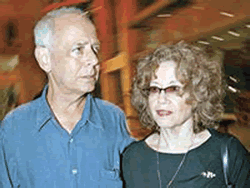
Director and screenwriter Nadav Levitan passed away Saturday night at the age of 64 in Beilinson Hospital in Petah Tikva from a lung ailment. He left behind his wife, the singer Chava Alberstein, two children and four grandchildren. His funeral was held yesterday in Ramat Hasharon.
Levitan was born in 1945 on Kibbutz Kfar Masaryk and after his military service left the kibbutz to study philosophy, literature and theater at Tel Aviv University. He worked for two years as an editor at the Maariv newspaper, published poems and stories in assorted journals, taught acting and the history of theater at the Beit Zvi and Nissan Nativ acting schools, and began his directing career in theater. A few of the plays he directed in the early 1970s became hits, including "Hasatan Ve'eshet Ha'ikar," "Ani Pashosh" and the comedy "Shir Eres". At the same time, Levitan worked at Army Radio as an editor of culture and entertainment programs.
Advertisement
Levitan moved over to film and television in the mid-1970s, when he wrote and directed two short films, "Isha Bagan" and "Hahutza". Following that he wrote and directed eight documentary films for the Israel Broadcasting Authority and the Israel Film Service, and starting in 1980 he wrote and directed dramas for film and television. Simultaneously, he taught film at the Beit Zvi and Camera Obscura schools, and published several books (including "Ma'achal Ta'ava" and "Politica Mishpahtit").
Over the years, Levitan created 11 dramas: "An Intimate Story" (1981); "The 17th Bride" (1984); "Girls" (1985, a box office success whose script was written by Assi Dayan); "Stalin's Disciples" (1988, which was shown at the Cannes Festival); "Hahaverim Shel Yael" (1991); "Retzah Beshabbat Baboker" (1992); "Groupie" (1993, which was the first film to feature actress Mili Avital and was also a commercial success); "No Names on the Doors" (1996, which was screened at the Berlin Festival); "Aviv" (1997); "Frank Sinatra is Dead" (1998) and "Ha'ahim Mevorach" (2000).
Levitan met his future wife, Alberstein, on the set of his film "An Intimate Story," in which she starred, and the creative collaboration between them continued over the years. Alberstein also appeared in "No Names on the Doors" and composed the soundtrack for the films "Stalin's Disciples" and "Groupie." Levitan wrote the lyrics for the songs on her albums "End of the Holiday," "Human Nature" and "Coconut."
Local theater critics did not always lavish praise on Levitan's works, but in 2006 the Israeli Film Academy decided to present him with its lifetime achievement award. Eitan Even, who produced "An Intimate Story" with Nissim Levy, says that Levitan "was an artist with a very large spirit, and as a person he was a mensch, a modest and humble person who is very easy to like and in whose company it is very pleasant to be. He was open, attentive and offered his opinion to those around him. His opinion was always important to those who worked with him, and it was easy to accept.
"On the other hand, he was flexible, and when he realized that it was not possible to do something, he could suggest alternative options that could be done - and not every director is able to do that."
Even though he left Kfar Masaryk after his army service, the kibbutz continued to star in many of Levitan's works. Levy, co-producer of "An Intimate Story" and a friend of Levitan, recalls that the film was based on a short story written by Levitan; it was filmed in its entirety on Kibbutz Einat. "He was a very sensitive person and smart, and forged many of his films out of his experiences on the kibbutz," says Levy. "He criticized the kibbutz, but also was deeply connected to it. It is especially apparent in his film 'Stalin's Disciples,' because after all he was one of them. He was very deeply entrenched in this environment."
Some years later, Levy also produced the film "Girls." According to him, "we thought what could be the most Israeli thing and immediately said the army. But because there were already films about the army, we decided to go with the angle of women in the army. We had Assi Dayan write the script and the result was a very commercial film, which we made using a naive approach, not a critical one, and the best actresses at the time competed to get the lead role. So the two films we did together were very different from each other, and still Nadav had a good handle on both. He was not a star director, he just made films."
Actor Amos Lavi, who appeared in three of Levitan's films, "Girls," "Frank Sinatra is Dead" and "Ha'ahim Mevorach," relates that Levitan was a director "who is fun to work with. He didn't force anything on you, would consult and ask your opinion. Twenty-nine years ago I worked with him on 'Girls,' which was a box office smash. In that film I played a friend of Hana Azoulay-Hasfari (who had the lead role), whom she does not want. I asked Nadav why she doesn't want this guy and we thought about it together. I suggested to him that the guy should stutter. He asked me to demonstrate for him. I showed him, and right away he said 'you sold me.' Since then our paths have crossed. He was a very noble person, let the actor express himself, bring himself in; he was open, attentive, pleasant, gentle and intelligent. His death is a great loss for Israeli film."
Film researcher and director Yehuda (Judd) Neeman says that "Stalin's Disciples" is, in his opinion, one of the most important films made in Israel during the era of political films, in the 1980s. "It was the first film to look ironically at Stalinism and the kibbutz movement," says Neeman. "Nadav took characters from the actual fabric of the kibbutz he knew, little by little wove the pieces, and at the end of the film there is the charming moment when one of the heroes looks at the sky, doesn't believe that this era has ended, looks at the moon and instead of seeing the crescent, sees the hammer and sickle. In my eyes, this is a brilliant cinematic touch and also a statement of political film, which was at its peak here in those days."
"In this film, Nadav cast a glance at a subject that was still untouched, the Zionist dream and the socialist utopia and its demise," says Neeman. "It's a political film, but there is a lot of heart and charm in it, and a touch of fantastic realism that did not exist here in those days. He returned to the topic in 'No Names on the Doors,' this time in retrospect. In this film he goes back to the place he visited in such a critical manner, but this time he comes back full of compassion, warmth and humanity. This was his magic touch in his humane films."
"He was a man with vast knowledge of all areas of culture and art," Katriel Schory, director general of the Israel Film Fund and a longtime friend of Levitan, said yesterday. "He was very knowledgeable about broad areas of cultural interests, and he was extremely sensitive to people and stories, and his cinematic work had an incredible sensitivity to people
--His brother is Amos Levitan ( born in Kfar Masaryk in 1936)
--------------------------------------------------------------------------------
Name Arrival Date Estimated Birth Year Gender Port of Departure Place
of Origin Destination Ship Name
H H Levitan 28 Feb 1859 1831 Male Bremen, Germany Germany United
States of America Bremen
S Levitan 12 Nov 1860 1822 Male Bremen, Germany Turkey United
States of America Bremen
Bensel Levitan 7 Dec 1886 1873 Male Hamburg, Germany Russia New
York Polaria
Esther Levitan 15 Jun 1889 1872 Female Hamburg, Germany and Le
Havre, France Russia United States of America Gellert
Lea Levitan 10 Nov 1884 1861 Female Hamburg, Germany and Le Havre,
France Russia United States of America Lessing
Nanny Levitan 11 Sep 1852 1833 Female Hamburg, Germany Germany
United States of America America
A Levitan 21 Jul 1886 1878 Male Glasgow, Scotland and Larne,
Ireland Russia United States of America State of Georgia
F Levitan 21 Jul 1886 1846 Male Glasgow, Scotland and Larne, Ireland
Russia United States of America State of Georgia
F Levitan 21 Jul 1886 1877 Male Glasgow, Scotland and Larne, Ireland
Russia United States of America State of Georgia
S Levitan 21 Jul 1886 1876 Female Glasgow, Scotland and Larne,
Ireland Russia United States of America State of Georgia
Gilel Levitan 6 Jun 1887 1879 Male Glasgow, Scotland and Moville,
Ireland Russia United States of America Ethiopia
Itzig Levitan 6 Jun 1887 1868 Male Glasgow, Scotland and Moville,
Ireland Russia United States of America Ethiopia
Len Levitan 6 Jun 1887 1839 Female Glasgow, Scotland and Moville,
Ireland Russia United States of America Ethiopia
S Levitan 8 Jan 1891 1839 Male Glasgow, Scotland and Moville,
Ireland Russia New York State of Nevada
Sam Levitan 7 Jul 1891 1868 Male Glasgow, Scotland and Moville,
Ireland Russia New York Siberian
Image
Jossel Levitan 20 Jul 1891 1862 Male Liverpool, England and
Queenstown, Ireland Russia New York Alaska
Kate Levitan 11 Oct 1886 1866 Female Liverpool, England and
Queenstown, Ireland Ireland United States of America Arizona
Lara Levitan 31 Aug 1891 1872 Female Liverpool, England and
Queenstown, Ireland Russia New York Arizona
Margt Levitan 19 Sep 1879 1860 Female Liverpool, England and
Queenstown, Ireland Ireland United States of America City of
Chester
Rosa Levitan 20 Jul 1891 1869 Female Liverpool, England and
Queenstown, Ireland Russia New York Alaska
Sore Levitan 12 May 1890 1872 Female Liverpool, England and
Queenstown, Ireland New York Servia
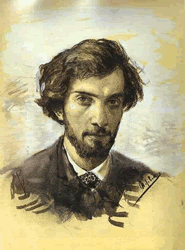
http://www.abcgallery.com/L/levitan/levitan.html
The work of Isaac Ilyich Levitan belongs to the highest achievements of Russian culture. Its significance is compared with the works of such classics as Anton Chekhov, Pyotr Tchaikovsky and Konstantin Stanislavsky.
Levitan was born in 1860 into a poor but educated Jewish family. In the late 1860s, the family moved to Moscow, where Isaac studied at the Moscow School of Painting and Sculpture from 1873 till 1883. He lost his mother in 1875 and his father two years later. He was left penniless and homeless in Moscow, sleeping alternately in the homes of relatives and friends, sometimes spending the night in the empty classrooms of the school. A nightwatch took pity on the youth and let him sleep in his cubicle. The School waived his tuition fee “because of extreme poverty and in recognition of his singular success in art”
The greatest role in the forming of Levitan’s creative personality belongs to his favorite teacher Alexey Savrasov, the most lyrical among Russian landscape painters of the 1860s-1870s, who influenced many well-known artists of Levitan’s generation Mikhail Nesterov, Constantin Korovin and others. Of course, Levitan’s passionate love for poetry and music, his persistent studying of pleine-air, the sunny paintings of Vasiliy Polenov, who also taught at the School, the works of the French painters of the Barbizon school, of Camille Corot were of great importance for the young artist. As any great talent did and does, Levitan submitted all the influences to his personality, and even his early works are very individual. Autumn Day. Sokolniki (1879). Levitan’s attitude towards nature and the poetry of his art were in many points akin to the works of Anton Chekhov, who became his friend from the late 1870s.
If his earlier works were chiefly of an intimate and lyrical character, his mature art becomes philosophical, expressing the artist’s meditation about man and the world. These pictures were particularly loved by the Russian intellectuals of the time, for they represented the purest specimen of the “mood landscape”, most popular in Russia at the end of the 19th century.
To this period belongs The Vladimirka Road (1892), a rare example of social historical landscape; Levitan painted the tragically famous road, along which convicts were marched to Siberia. In Above the Eternal Peace (1894) the artist’s meditations about the controversies of life, about the transience of human being, gained almost monumental scale and philosophic character.
In 1897, Levitan felt sick, a severe cardiac disease was revealed. Nevertheless, notwithstanding the permanent menace of death, he worked with a particular intensity and inspiration. His latest works are distinguished by a confident mastership, richness of technical methods, and new stylistic trends. One can feel the influence of ancient Russian art, which attracted him at the period, and that of modern style, and the newest searches in French painting, which Levitan always took a lively interest in. Nevertheless, Levitan did not join modern art and remained true to realism, utterly alien to mythologizing and stylization. Most characteristic in the late 1890s were numerous paintings of quiet twilights, moonlit nights, sleeping villages (Haystacks. Twilight. (1899), Sunny Day. (1898) and many others). To the very end of his life Levitan took an active part in artistic life; he taught at the Moscow School of Painting, where he had been educated, took part in organizing the Moscow Club of Literature and Art, showed his pictures at numerous exhibitions of such associations as World of Art and Munich Secession.
Leo Tolstoy once said, “The basis of human happiness is the possibility to be together with nature, to see it and to talk to it.” Levitan was granted this happy feeling as hardly any other human being ever was. He also knew the joy of recognition by his contemporaries and of friendship with the best among them. Levitan ranks among the most appreciated and loved of Russian artists.
Bibliography:
Isaak Levitan. Aurora. Leningrad. 1980
Levitan. by V.Petrov. Russian Painters of the XIX century. Moscow. 1992.
One family's Hanukkah
For the Levitans of Austin, Hanukkah traditions are a blend of ancient and modern
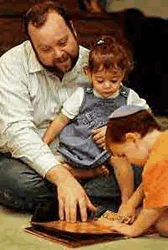
By Michele Chan Santos
American-Statesman Staff
Published: Dec. 13, 1998
Arnie and Janice Levitan started telling the story of Hanukkah to their
children, Jacob, 3, and Sarah, 2, when the youngsters were only a few
months old. They told them about Judah the Maccabee's victory over the
Greek-Syrian tyrant Antiochus, a triumph Jewish people will celebrate
tonight and for the next week. But as they grow up, Jacob and Sarah will
associate Hanukkah with more than its religious and historical meaning.
Their recollections will be enriched with the traditions and stories unique
to their family. Holiday gatherings bring back deep memories. For most
people, this time of year means "what your family did around food,
gifts, celebrations," says Anna Gonzalez-Sorenson, a clinical psychologist
with Austin Counseling and Psychological Services. "Families have
traditions, rituals, special things they do every year.They feel familiar,
bring back warm memories." The memories often span generations. Jacob
and Sarah's grandparents, Ruven and Ilana Levitan, were married during
the fourth night of Hanukkah in Tel Aviv in 1949, a year after they helped
found Israel. It was raining, and the photographer never got a picture
of the bride and groom alone, but it's a treasured moment in family history.
Forty-three years later, Arnie asked Janice to marry him on the third
night of Hanukkah in 1992. "I proposed by giving her a Hanukkah gift,"
Arnie says. "It was a Minnie Mouse watch with a 'Marry me' inscription
on the back." The rest of the inscription says "forever and
forever," a favorite phrase of the couple's, and the year based on
the Hebrew calendar, 5753. The celebrations go beyond the nuptial. Janice's
parents, Art and Bette Anderson, give a big party every year during the
holiday, where up to 150 people gather to eat and hear the story of the
Maccabees' military victory. Every gathering is marked by distinctive
foods, prayers and religious objects. Menorahs are candelabras that symbolize
Hanukkah. The Levitans have two: a delicate silver menorah that was a
wedding gift for Arnie and Janice and a golden menorah purchased in Tel
Aviv. Janice's family has a Hanukkah cookie recipe, passed from one member
to the next, from grandmother to mother to cousin to uncle, changing a
little bit with each retelling. The sugar cookies have just a touch of
orange juice in them, their secret ingredient. Janice has four cookie
cutters for Hanukkah, in the shape of a dreidel (spinning top), a menorah,
a Star of David and a cruse (bottle) of oil. She sprinkles blue and yellow
sugar on the cookies, because blue and gold are traditional Hanukkah colors.

This year, Janice is starting a collection of dreidels for her children,
planning to add a new one every year. So far, they have a Mickey Mouse
dreidel and another decorated with Winnie the Pooh. Mickey and Pooh may
be modern cartoons, but the Hebrew characters on the top have a much older
meaning: They are the initials of the phrase: "A great miracle happened
there." The dreidel game was played by Jews who were not allowed
to study the Torah during Antiochus' reign. During their studies, they
would keep a dreidel nearby, Janice says. When soldiers came by to inspect
them, they pretended to be playing a game. Hanukkah, Janice says, was
"a fight for religious freedom." It was a victory for Jews who
were resisting political and religious domination from Greek-controlled
Syrian society. Celebrating Hanukkah "is part of the whole circle,"
she says. "It's part of who we are and what we are." Still,
Hanukkah is a relatively minor holiday for Jews, Janice says, that pales
in significance next to Rosh Hashanah, Yom Kippur and Passover. The Levitans
moved from Kokomo, Ind., to Austin in March, when Arnie took a job as
a diffusion process section manager for Motorola. They attend services
at Chabad House-Lubavitch, an Orthodox synagogue and community center
near the University of Texas. Their children also attend preschool at
Chabad House. The Levitans moved from Kokomo, population less than 50,000,
with a tiny Jewish community, to the Austin metropolitan area, with a
population of more than 1 million and a Jewish community of more than
10,000 (the majority of whom belong to the Reform and Conservative branches
of Judaism). It has been a remarkable change for the family. "There
are three times as many Jewish families in our neighborhood than in Kokomo,"
Janice says of their home in Northwest Austin. The family keeps a kosher
household. This is much easier in Austin than in Kokomo, where they had
to drive four hours to Chicago to buy kosher meat. "Here, the H-E-B
kosher store has everything we need," Janice Levitan says.
Each night, they will light the menorah, a nine-branch candelabra. Using
the helper candle, or shamash, in the center, they will light one candle
tonight, two tomorrow, and so on, until the whole candelabra is lit at
the conclusion of the holiday. The ceremony commemorates the miracle of
the single jar of oil that kept the temple light burning continuously
for eight days after the Maccabees' triumph in 165 B.C. They will pray
during the ceremony: "Praised are you, Adonai (Hebrew for `Lord')
our God, Sovereign of the Universe, who has made us holy by mitzvot (Hebrew
for `commandment') and instructed us to light the Hanukkah candles."
The prayers end with thanking God "who has given us life, sustained
us, and helped us to reach this day." Little Jacob is ready. Last
week, he responded quickly when his mother asked him, "Who did the
Maccabees fight, Jacob?"
"Antiochus!" the 3-year-old said. "And they won!"
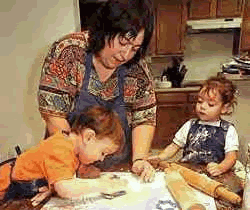 Using
a generations-old family recipe, Janice Levitan and her children, Jacob,
3, and Sarah, 2, make Hanukkah cookies.
Using
a generations-old family recipe, Janice Levitan and her children, Jacob,
3, and Sarah, 2, make Hanukkah cookies.
Photo by Rebecca McEntee/AA-S.
Surname First_name Year Town
Source Comments
LEWITAN Mordechai 1900 Jorburg, Lith. Hamelitz #247
LEWITAN Reuven 1900 Kaunas, Lith. Hamelitz #176 Kloiz Weinshtein
LEWITAN Reuven 1902 Kaunas, Lith. Hamelitz # 238 Kloiz Weinshtein
LEVITAN Shmuel 1899 Keidainiai, Lith. Hamelitz #216
LEWITAN Devorah 1895 Keidainiai, Lith. Hamelitz #230 from Dotnewe
LEWITAN Bentzion 1899 Kelme, Lith. Hamelitz #56
LEWITAN Betzalel 1903 Krekenava, Lith. Hamelitz #120
LEWITAN Yakov 1897 Nemaksciai, Lith. Hamelitz #170
LEWITAN Yakov 1898 Nemaksciai, Lith. Hamelitz # 132
LEWITAN Nisan ben Rabbi Gaon Tzadok 1899 Nodtzigrod, Lith. Hamelitz #204
Rabbi
LEWITAN Yosef 1898 Panemune, Lith. Hamelitz #173
LEWITAN Eliahu husband of Rochel from Propoisk 1893 Panevys, Lith. Hamelitz
# 201 wed
LEWITAN Shmuel 1901 Panevys, Lith. Hamelitz #85
LEPTIN Hiene 1900 Platelai, Lith. Hamelitz #140
LEWITAN A G 1902 Radziviliskis, Lith. Hamelitz #244
LEWITAN Eliezer 1902 Radziviliskis, Lith. Hamelitz #244
LEWITAN Alter 1895 Raseiniai, Lith. Hamelitz #208
LEWITAN Alter 1899 Raseiniai, Lith. Hamelitz #72
LEWITAN Alter 1900 Raseiniai, Lith. Hamelitz #204
LEWITAN Alter husband of Devorah Rosenfeld 1901 Raseiniai, Lith. Hamelitz
#27 wed
LEWITAN Alter husband of Devorah Rosenfeld 1901 Raseiniai, Lith. Hamelitz
#80
LEWITHAN 1900 Riga, Lat. Hamelitz #214 doctor
LEWITAN Shraga son of the rabbi here 1900 Salatai, Lith. Hamelitz #140
LEWIATAN Yeshiahu 1897 Seduva, Lith. Hamelitz #10
LEWITAN Yitzchok Zalman 1902 Shantz (Kaunas), Lith. Hamelitz # 240
LEWITAN Zisel 1902 Shantz (Kaunas), Lith. Hamelitz # 240
LEWITAN A 1895 Siauliai, Lith. Hamelitz #189
LEWITAN Avigdor 1893 Siauliai, Lith. Hamelitz #223
LEWITAN Ch 1895 Siauliai, Lith. Hamelitz #189
LEWITAN Ch A 1895 Siauliai, Lith. Hamelitz #189
LEWITAN Chaim Eliezer 1893 Siauliai, Lith. Hamelitz #204
LEWITAN Chaim Eliezer 1898 Siauliai, Lith. Hamelitz #173
LEWITAN Chaim Leizer 1899 Siauliai, Lith. Hamelitz # 212
LEWITAN Eliahu ben Miriam 1899 Siauliai, Lith. Hamelitz #214
LEWITAN Miriam d of brother of Zev Wolf Lewitan mother of Eliahu 1899
Siauliai, Lith. Hamelitz #214
LEWITAN Nachman husband of Friede Shefkind of Shkod 1902 Siauliai, Lith.
Hamelitz #230 wed in Mazeiki 3
Marcheshvan
LEWITAN R 1895 Siauliai, Lith. Hamelitz #189
LEWITAN Sh 1895 Siauliai, Lith. Hamelitz #189
LEWITAN Zev 1901 Siauliai, Lith. Hamelitz #87 Kloiz Hachayatim (for Bessarabia
fund)
LEWITAN Zev Wolf uncle of Miriam Lewitan 1899 Siauliai, Lith. Hamelitz
#214
LEWITAN 1899 Siauliai, Lith. Hamelitz # 212
LEWITAN B Y 1903 Siluva, Lith. Hamelitz # 224 Rabbi ABD
LEWITAN Dovid husband of Rochel Hinda 1898 Taurage, Lith. Hamelitz #94
wed (anniv?) 3 Adar
LEWITAN Falk 1900 Taurage, Lith. Hamelitz #140
LEWITAN Falk father of Shraga 1898 Taurage, Lith. Hamelitz # 132
LEWITAN Leib 1900 Taurage, Lith. Hamelitz #140
LEWITAN Rochel Hinda wife of Dovid 1898 Taurage, Lith. Hamelitz #94 wed
(anniv?) 3 Adar
LEWITAN Shraga ben Falk 1898 Taurage, Lith. Hamelitz # 132
LEWITAN Tziril 1900 Taurage, Lith. Hamelitz #140
LEWITAN Tzvi 1898 Taurage, Lith. Hamelitz #173
LEWITAN Tzvi 1900 Taurage, Lith. Hamelitz #140
LEWITAN Shlomo Yitzchok 1900 Vainuta, Lith. Hamelitz #140
LEWITAN Chaim Meir 1898 Varniai, Lith. Hamelitz #132
LEWITAN Chaim 1898 Zarasai, Lith. Hamelitz #173
LEWITAN Yakov 1899 Zasliai, Lith. Hamelitz #67
-------------------------
LEWITAN Rabbi Moshe Yosef (son of Zvi Hirsh Levitan 1840- 1915) husband
of M Yehudis married;1899
Vilnius, Lith. Hamelitz #6 wed both died in Israel
parents to; Nachum (father of Dr. Ruven Levitan and baby Yonina who was
lost during the war), Dr. Chyena
Shershevski (Her two sons perished in Kovno), Ben-Zion (father to Dr.
Avi, Ariela, Nava and Ofra) and Batia
Shapira (mother to Dr. Yair and Dr. Ami
--------------------- LEWITAN Dov Ber 1872 Kaunas, Lith. Hamaggid #17
LEWITAN Shmuel 1872 Kaunas, Lith. Hamaggid #17
LEWITAN Zundil 1872 Keidainiai, Lith Hamaggid
LEWITAN Abraham 1872 Saukenai, Lith. Hamaggid #18
LEVITAN Yitschak 1872 Seduva, Lith. Hamaggid #9 Hagvir
LEWITAN Leib 1872 Taurage, Lith. Hamaggid #13
LEWITAN Shlomo 1872 Zagare (new) Hamaggid #17
1852
LEVITAN Gershon Leyb Head of Household 46 butcher
LEVITAN Abram Gershon Son 14
1863
LEVITAN Gershon Leyb 57
LEVITAN Abram Gershon 25
LEVITAN Gershel Leyba age 52 in 1858
LEVITAN Girsha Gershel age 27 in December 1868
LEVITAN Abram Gershel 30 in December 1868
LEVITAN Leyba Gershel 13 in 1866
LEVITAN Leyba Gershel
LEVITAN Abram Gershel 30 December 1868
Kedainiai/ Kaunas 1874
LEVITAN Girsh (Zvi Hirsh?) son of Gershen Head of Household 32
LEVITAN Leah Wife 31
LEVITAN Movsha Girsh's Son 4
LEVITAN Shmuel Girsh's Son 2
LEVITAN Freyda Girsh's Daughter 7
LEVITAN Eyga Girsh's Daughter 3 weeks
HaRav Shach was born to Rav Ezriel zt"l and Bat Sheva of the Levitan family, a family of talmidei chachomim who served as rabbonim in important Lithuanian communities. Her brother was HaRav Nisan Levitan zt"l, who became one of the most senior figures in Agudas HaRabbonim of America.
HaRav Shach was born in Vabolnik, Lithuania on erev Rosh Chodesh Shvat 5655 (1895) into a home of yirei Shomayim. HaRav Shach always praised the yiras Shomayim he absorbed in his parents' house.
"I remember how I was educated in my parents' home: when my yarmulke fell off my head, I was taught that you had to cry from distress. They were guided by a concern for the punctilious observance of mitzvos. Once I woke up after the zman Krias Shema according to the Mogen Avrohom and I burst out crying and continued to cry about it all day long."
He was brought up and educated with Torah and immense yiras Shomayim. Throughout his life he was extremely careful about being medakdek bemitzvos.
Although there was a yeshiva ketana in his hometown, he begged his parents to let him go to Ponevezh Yeshiva in order to fulfill the directive, "Exile yourself to a place of Torah." When they saw how persistent he was they agreed to his request, and he set out for Ponevezh Yeshiva. He was never to see his parents again.
He pursued his studies diligently together with the other talmidim. His great rov was HaRav Itzele Blazer zt"l and he also had the merit of sleeping in the Ba'al Hamitzvos' House. Already in his youth those characteristics, which were to make him admired by the whole Jewish world, stood out: his amazing hasmodoh, wonderful talents, a shining mussar personality, respect for his fellow man, and a cheerful countenance.
He acquired his learning during his youth from Slobodka Yeshiva in Lithuania, where he quickly became one of its outstanding students. During the years 5673-74 (1913-14) he absorbed Torah and mussar from his great rov, the Alter of Slobodka, HaRav Nosson Zvi Finkel zt"l, from his son- in-law, HaRav Yitzchok Eisik Sher zt"l and HaRav Moshe Mordechai Epstein zt"l.
Throughout his life HaRav Shach considered himself to be a talmid of Slobodka and he often praised that great institution of Torah and mussar. Once he said that all the Torah in Eretz Yisroel and America today originates from Slobodka, the "mother of Yeshivas," for all the roshei yeshiva of the last generation learned there.
The Slobodka mussar outlook and the Alter's approach to the depths of ma'amorei Chazal guided the Rosh Yeshiva in his avodas Hashem in general and in his mussar shmuessen in particular.
In 5614 (1914) HaRav Shach was forced to leave Slobodka due to the outbreak of war and he returned to his hometown of Vabolnik, where he joined the yeshiva of HaRav Yechezkel Bernstein zt"l, the author of the Divrei Yechezkel, who had opened a yeshiva in the town in which his father- in-law lived.
Rav Shach writes about this period in the introduction to the new Avi Ezri edition published in 5753 (1993): "How can I repay Hashem for all His mercies? Starting from the days of my youth, when I went through periods when I had nothing at all. I cannot adequately describe this period from the beginning of the First World War in 5674 (1914) when all the Jews were exiled from the Lithuanian towns and I did not know where my parents were, for I was alone in Slutsk and I had no contact with them. That was how I spent several years, suffering much."
The Rosh Yeshiva spent these years fleeing the terrors of the First World War. He wandered from town to town, but fulfilled the posuk, "Had Your Torah not been my delight, I should then have perished in my affliction." He learned in shuls and botei medrash, washing his face, hands and feet in the sinks at the entrance of the botei medrash. Every fiber of his being was immersed only in Torah, and he could say about himself, "The Torah which I learned in the period of wrath, endured."
In later years, when bochurim came to him to complain about physical conditions in the yeshiva, he told them that in those days he would take off his shirt, soak it in the sink outside the shul and wait in the cold for it to dry outside. "I never wanted to be dependent on the kindness of others." Thus he remained immersed in the Sea of the Talmud, cleaving to his Creator.
He would subsequently say that anyone attached to materialism could never attain ruchniyus, and quoted from Vayeiro, "Sit here with the donkey": "Anyone who does not see the mokom, who does not see Hakodosh Boruch Hu, it is a clear sign that he is attached to chamor, to materialism. Only someone who detaches himself from materialism, attains spirituality."
Then he would relate the spiritual heights he attained during this difficult period, when he had no material goods whatsoever and only experienced suffering.
His unique hasmodoh was conspicuous in all stages of his life. His whole life and his whole being revolved around the holy Torah, in which he toiled and which elevated him at all times.
After a while HaRav Shach joined the HaRav Isser Zalman Meltzer zt"l who had founded a yeshiva in Slutsk in 5657 (1897). He developed a close relationship with HaRav Isser Zalman, whom he considered his rov with respect to everything, and he had the merit of absorbing Torah from HaRav Isser Zalman in his house in Slutsk.
He would recall how when he came to be tested by HaRav Isser Zalman, his clothes were torn because of his intense poverty at the time, after he had been forced to travel from town to town and he only had one set of clothes. By the time he got to see Rav Isser Zalman his clothes were tattered and he was afraid to go in to see the Prince of Torah looking like that. He turned his pants inside-out in order to make them look less torn and shabby.
HaRav Meltzer noticed the state of his clothes and accepted him to the yeshiva straight away, realizing that he was a treasure house, a plastered cistern that does not lose a drop, who was destined to illuminate the skies of Torah-true Judaism with the light of his Torah and greatness. The following day HaRav Isser Zalman bought him new clothes.
In the introduction to his great work Avi Ezri on Haflo'o-Zeroim HaRav Shach writes: "It is my duty to mention my uncle, HaRav Isser Zalman Meltzer ztv"l and my aunt . . . who were like parents to me already in my youth . . . I received much from them, and whatever is mine -- is from them."
The Rosh Yeshiva received semichoh from HaRav Isser Zalman, eventually married his sister's daughter, and was appointed maggid shiur in the Slutsk Yeshiva headed by HaRav Isser Zalman.
Throughout his life HaRav Shach related to his uncle HaRav Isser Zalman like a son to a father and a talmid to his eminent rov. In his shiurim he often cites divrei Torah of Rav Isser Zalman on sugyos of Shas. In a letter on the occasion of the establishment of Even Ho'ezel Yeshiva in Netivot, HaRav Shach wrote, "Rav Isser Zalman disseminated Torah throughout his life, and I, although unworthy of it, had the merit of becoming close to him and he taught me like a father teaches a son."
In a letter of chiddushei Torah to Rav Isser Zalman dated Rosh Chodesh Cheshvan 5799 (1938) HaRav Shach (who was then Rosh Yeshivas Karlin in Luninetz) addresses him as follows: "My teacher and master, the great and true Gaon, the Prince of Torah and treasure house of yir'oh, the Glory of the Jewish nation, the master of his nation, my uncle, Rav Isser Zalman Meltzer shlita." He concludes the letter: "With this I bow to my master and teacher with the blessing that he may live a lengthy life, remain strong and merit the comfort of Zion. His devoted student . . . ".
Rav Shach recalled that in his youth he wrote for himself a whole composition in a notebook on hilchos na'aroh besuloh and his uncle, Rav Isser Zalman would go up to the closet where the notebook was, look at it and make a few comments. The Rosh Yeshiva said that Rav Isser Zalman told him about his suggestions for a hagohoh on the Rambam (Naaroh Besuloh 3:3 -- see Avi Ezri (ibid.), dibbur hamaschil vesovur hoyisi) that he had arrived at the truth with this hagohoh and that everybody had a part in the Torah.
Rav Isser Zalman also treated HaRav Shach like his son, remaining very attached to him throughout his life and showering him with an abundance of Torah and yir'oh. Rav Isser Zalman praised Rav Shach's chiddushei Torah greatly, and due to his great admiration of them he published some in his book Even Ho'ezel. Rav Isser Zalman also encouraged the Rosh Yeshiva to publish his sefer Avi Ezri. When Rav Shach was about to publish his first sefer in 5708 (1948) there was a shortage of paper because of the war and Rav Isser Zalman took pains to obtain sufficient paper for the printing of the book.
Disseminating Torah
On 16th Av 5683 (1923) HaRav Shach was engaged to Rav Isser Zalman's niece,
Guttel, the daughter of Rav Ben-Zion Gilmovsky z"l, who was a descendant
of the Ponim Meiros. The book Shimusho shel Torah contains her lineage
as recorded by Rav Isser Zalman. They were married between Yom Kippur
and Succos 5684 (1923), Rav Isser Zalman being mesader kiddushin.
Over the years the Rosh Yeshiva would speak about the Rebbetzin's mesirus
nefesh, which allowed him to toil in Torah undisturbed. She took upon
herself the yoke of supporting the family, working as a pharmacist in
the town. "After my marriage too I would travel [to yeshiva to learn]
from Pesach to Succos and from Succos to Pesach to devote myself undisturbed
to my studies, and my whole Torah is to be credited to her."
For five consecutive years he devoted himself to his studies with amazing
hasmodoh acquiring a mastery of all parts of the Torah. His soul yearned
for Torah, and during those years he overwhelmed his inclination and purified
his body, submitting it totally to Torah with his elevated yiras Shomayim.
He did not cease his studies day or night; he did not take leave of his
books or interrupt his studies. He afflicted his body and purified his
soul until he had acquired a vast knowledge of the Talmudic waters.
In 5789 (1929) he was asked by HaRav Aharon Kotler zt"l to assist
him by becoming a maggid shiur in Kletsk Yeshiva. He disseminated Torah
there for five years, leaving his mark on many talmidei chachomim. During
this period he developed a close relationship with HaRav Yechezkel Levenstein
zt"l, the future mashgiach of Ponevezh, who was the mashgiach of
Kletsk at the time.
At this time HaRav Shach was asked by the Brisker Rov to accept the position
of rosh yeshiva of Toras Chaim in Brisk to replace the Imrei Moshe, HaRav
Moshe Soloveitchik, but for various reasons HaRav Shach did not take up
this position.
After the sudden passing of HaRav Meir Shapira zt"l on 7th Cheshvan
5694 (1933), HaRav Shach was asked by Rav Chaim Ozer Grodzensky zt"l
to become the rosh yeshiva of Lublin and he stayed there for a while.
He then served as maggid shiur in Novardok Yeshiva, where he taught Torah
to young students for two years. In a letter written by HaRav Aharon Kotler
to HaRav Chaim Ozer Grodzensky he asks Rav Chaim Ozer "to use his
influence to support Novardok Yeshiva since my relative, the Gaon Rav
Eliezer Shach shlita joined the yeshiva as a maggid shiur, and I have
it on reliable information from members of that Yeshiva that the learning
is on a superior level especially now that my above relative has been
accepted there, for he is great in Torah and influencing others in Torah
. . . "
In 5696 (1936) the Rosh Yeshiva became a maggid shiur in Karlin Yeshiva
in Luninetz, which was headed by the Rebbe Rav Avrohom Elimelech Perlow
zt"l.
This is how Rav Shach came to serve as maggid shiur in Karlin Yeshiva:
The most important rabbonim of Lithuania and Poland were once in the middle
of a meeting when a young man stormed into the room without noticing any
of the rabbonim present. Some of the participants tried to prevent him
from entering the room but he insisted on proceeding with his mission.
"I must go in," the young man said and turned straight away
to HaRav Chaim Ozer, telling him. "I've got a simple solution to
yesterday's problem."
One of the Rebbes got up and protested, "Yungermanchik, a little
derech eretz!" The avreich apologized to those present and left the
room. HaRav Chaim Ozer smiled and said to the rabbonim: "When this
avreich has a question or an answer, he is not concerned about anything
else, so there is nothing to protest about."
The Karliner Rebbe, who was also present at this meeting turned to HaRav
Chaim Ozer and said, "I am looking for such a personality to serve
as Rosh Yeshiva of my yeshiva."
The Rebbe's wish was fulfilled and HaRav Shach became rosh yeshiva in
his yeshiva, a position he maintained for four years.
During this period Rav Shach was arrested for protesting chilul yom tov.
He protested against Jews who desecrated the sanctity of Shavuos, which
fell on erev Shabbos, by buying fish from non-Jews. In a letter written
to the management of the Vaad Hayeshivos in Vilna dated Monday 9th Sivan
5697 (1937), HaRav Shach wrote the following about these events:
"You must have read in the newspapers reports about what happened
here. I wish to inform you what happened last Friday morning after davening.
The yeshiva had been up all night learning, as is customary, and davened
after alos hashachar. After davening I noticed some Jewish ladies buying
fish from two [non-Jewish] fishermen. I immediately went over to them
and protested this abomination, of yom tov being publicly desecrated.
Straight away two policemen came over and arrested me, having gathered
testimony from some non-Jews that I had incited Jews not to buy produce
from non-Jews. Boruch Hashem after people interceded with the procurator
in Pinsk I was released after having been imprisoned for two days. At
the moment I do not know whether there will be a trial about this. The
report in the newspaper is therefore a lie, and tomorrow a report will
iy"H appear in the newspaper by the IATA giving a correct version
of what happened, and this will atone for the great fear we felt in the
town, especially following the events in Brisk."
In 5700 (1940) the Rosh Yeshiva reached Vilna, where he spent some time
with Rav Chaim Ozer with whom he held a lot of Torah discussions, at the
same time learning a lot from him about Jewish leadership. Rav Shach admired
Rav Chaim Ozer greatly for his greatness in Torah and for the way he bore
the yoke of leading the nation.
While he was in Vilna in 5700 the Rosh Yeshiva's daughter, Miriam Reizel,
passed away. He recalled that following her petiroh, whenever Rav Chaim
Ozer met him he would comfort him, saying, "Rebbi Shach, `Had Your
Torah not been my delight.' Rav Shach added that Rav Chaim Ozer also had
a daughter, an only child, who died young.
During the levaya, which took place in the Vilna cemetery, HaRav Shach's
son Efraim, yibodel lechaim aruchim remained with Rav Chaim Ozer, who
held him on his lap, playing with him and making him feel relaxed.
A Lion has Come Up from Bovel
In 5700 (1940) HaRav Shach immigrated to Eretz Yisroel. He said that he
came without enough money to support himself for even one day and without
even the most minimal possessions, because all his possessions, including
his personal effects, had been confiscated at the border. He went straight
away to the home of his uncle, HaRav Isser Zalman Meltzer.
At that time a maggid shiur from a yeshiva in Tel Aviv came to see Rav
Shach offering him the position of rosh yeshiva. HaRav Shach recalled:
"His yeshiva at that time was still without secular studies. It was
an ordinary yeshiva with proper bochurim. (At that time I still was not
so much aware of the Chazon Ish, since he was not yet so well-known. The
Brisker Rov had also not yet come to Eretz Yisroel. [So he did not and
could not ask their advice - Ed.]) I asked my uncle HaRav Isser Zalman
what to do. He thought about it for a day and then told me to accept the
position, which I did. The maggid shiur in that yeshiva gave me an advance
of 13 lirot, which was a lot of money at the time, with which I also bought
some furniture -- what I have now is what I bought then -- and I rented
an apartment in the middle of Baalei Melacha neighborhood in Tel Aviv.
I was relaxed there and successful. The management of the yeshiva was
happy with me.
"As I said, the yeshiva at that time was run like an ordinary yeshiva
without any secular studies, and that maggid shiur never spoke anything
about such things. Once, when I was in my room in the yeshiva building,
Rav Avrohom Farbstein zt"l, subsequently rosh yeshiva of Chevron
Yeshiva, who was a young man at the time (and was a regular visitor to
my uncle's house, Rav Isser Zalman, from where I knew him) found me immersed
in my thoughts. He asked me what was troubling me. I told him that I had
the feeling that people around me were surprised that I had this position
here and that I did not understand why. He told me that the Chazon Ish
was in Bnei Brak and I should seek his advice.
"I went straight from the yeshiva to the Chazon Ish and asked him
what to do. He told me that I certainly had to leave my position. He added
that from what he heard about me already in chutz lo'oretz from Rav Chaim
Ozer and from the divrei Torah he had seen which were published in Knesses
Yisroel in Vilna in 5792 (1932), it was surprising that I had accepted
a position there. He then made some severe criticisms of the head of the
yeshiva -- not against the yeshiva but against him personally. He added
that if in the next world they will say that hadn't they signed for you
for a parnossoh for the year and how could you dare to abandon that parnossoh,
I should reply that I did not want to make a parnossoh that way and I
will be left alone. I told him: Shouldn't I go to my wife first to prepare
her for this step? But he told me (in these words), `If a mitzvah comes
by your way, do not let it sour!' (Mitzvah habo'oh leyodecho al tachmitzenoh.)
And he said no more.
"I therefore went straight from the house of the Chazon Ish to the
head of the yeshiva in Tel Aviv without going home first, and told him
that I was resigning. He was surprised. At first he thought that I wanted
a higher salary and he offered to double it, but I resigned without any
further ado and left the yeshiva that same day. Afterwards I went home
to tell my family that I had resigned. When I told Rav Isser Zalman what
had happened he was full of praise for what I had done."
In 5741 (1941), at the instruction of the Chazon Ish, HaRav Shach was
called by HaRav Ben-Zion Bruk zt"l to serve as maggid shiur in his
Yeshiva Beis Yosef in Yerushalayim, where HaRav Shach remained until 5704
(1944).
In 5744 he went to serve as a ram in the Kletsk yeshiva in Rechovot that
was founded by the son of HaRav Isser Zalman. Later he returned to this
yeshiva to say shiurim in 5710 and 5711 (1950-51).
In 5745 the Rosh Yeshiva was asked to become for the rest....
http://www.shemayisrael.com/chareidi/archives5762/chayesara/CS62aravshachbio.htm
Opinion & Comment
Talking About Maran HaRav Shach ztvk"l
Virtually the entire chareidi world is now learning, for the first time
ever, what it is like to live in a world without Maran HaRav Shach, zt"l.
For over ninety years he was part of the yeshiva world, and for most of
them he was at or near its summit.And what a height he scaled! He was
truly one who lived, even in our day, on the Har Hashem. He was one who
could stand in His holy place.As HaRav Shach said in his hesped of the
Brisker Rov, "No matter what words of eulogy or appreciation we use,
they will only serve to detract from the stature of the niftar, for we
are not capable of grasping what he really was."HaRav Shach's suggestion
then was just to "talk about the event." Everyone, he said,
can contribute something to such a discussion. We can only tell of what
we have seen in our small corner of the world.As is well-known, HaRav
Shach started Yated Ne'eman together with the Steipler, and the English
edition of Yated Ne'eman on his own .....
http://www.shemayisrael.com/chareidi/archives5762/chayesara/orshachm.htm
Jonina Levitan was born in Kaunas, Lithuania in 1942 to Nakhum and Ada Yeta nee Rabinovitz. During the war was in Kaunas. Jonina died? in July of 1944 in Kaunas, Lithuania. This information is based on a Page of Testimony submitted on 20/11/1956 by her father, a Shoah survivor
Source Pages of Testimony
Last Name LEVITAN
Last Name LEVIATAN
First Name JONINA
First Name* YANINA
Father's First Name NAKHUM
Mother's First Name ADA
Mother's First Name* YETA
Gender FEMALE
Date of Birth 1942
Place of Birth KAUNAS,KAUNAS,LITHUANIA
Place of Permanent Residence KAUNAS,KAUNAS,LITHUANIA
Place During Wartime KAUNAS,GHETTO
Place of Death KAUNAS,KAUNAS,LITHUANIA
Date of Death July of 1944
Type of Material Page of Testimony
Submitter's Last Name LEVIATAN
Submitter's First Name NAKHUM
Relationship to victim FATHER
Date of Registration 20/11/1956
Is the Submitter a Survivor? YES
Pages of Testimony by the same submitter ( Levitan Nachum, grandson of Nakhum and Rivka Gerstein)
Icchak Gerstein was born in Kowno, Lithuania in 1882 to Nakhum and Rivka. He was a merchant and married to Khana nee Gutman. Prior to WWII he lived in Kowno, Lithuania. During the war was in Vilkomir, Lithuania. Icchak died in 1941 in Vilkomir, Lithuania. This information is based on a Page of Testimony submitted on 20/11/1956 by his nephew .
Nachum Gerstein was born in Kaunas, Lithuania in 1909 to Icchak/Yitzkhak and Khana. He was a merchant and married to Ester nee Mishkovski. Prior to WWII he lived in Kaunas, Lithuania. During the war was in Kaunas, Lithuania. Nachum died in 1941 in Kaunas, Lithuania. This information is based on a Page of Testimony submitted on 20/11/1956 by his cousin, a Shoah survivor
Source Pages of Testimony
Last Name GERSTEIN
Last Name GERSHTEIN
First Name NACHUM
First Name NAKHUM MEIR
Father's First Name YITZKHAK
Mother's First Name KHANA ESTER
Gender MALE
Date of Birth 1909
Place of Birth KAUNAS,KAUNAS,LITHUANIA
Marital Status MARRIED
Spouse's First Name ESTER
Spouse's Maiden Name MISHKOVSKI
Age of 1st Child 4
Age of 2nd Child 2
Place of Permanent Residence KAUNAS,KAUNAS,LITHUANIA
Profession MERCHANT
Place During Wartime KAUNAS,KAUNAS,LITHUANIA
Place of Death KAUNAS,KAUNAS,LITHUANIA
Date of Death 09/1941
Type of Material Page of Testimony
Submitter's Last Name LEVIATAN
Submitter's First Name NAKHUM
Relationship to victim COUSIN
Date of Registration 20/11/1956
Is the Submitter a Survivor? YES all pages;
Name Town District Region Country Birth Date Source
Rakhel Mankevic was born in Kaunas, Lithuania in 1877 to Tzvi and Rivka. She was a housewife and a widow. Prior to WWII she lived in Kaunas, Lithuania. During the war was in Kaunas, Lithuania. Rakhel died in 1941 in Kaunas. This information is based on a Page of Testimony submitted on 20/11/1956 by her nephew
Pages of Testimony by the same submitter ( Levitan Nachum, grandson of Tzvi Eliezer and Rivka Levitan)
Source Pages of Testimony
Last Name MANKEVIC
First Name RAKHEL
Father's First Name TZVI ELIEZER
Mother's First Name RIVKA
Gender FEMALE
Date of Birth 1877
Place of Birth KAUNAS,KAUNAS,LITHUANIA
Marital Status WIDOW
Place of Permanent Residence KAUNAS,KAUNAS,LITHUANIA
Profession HOUSEWIFE
Place During Wartime KAUNAS,KAUNAS,LITHUANIA
Place of Death KAUNAS,GHETTO
Date of Death 08/1941
Type of Material Page of Testimony
Submitter's Last Name LEVIATAN
Submitter's First Name NAKHUM
Relationship to victim NEPHEW
Date of Registration 20/11/1956
Dr. Rachmiel Ligum was born in Zagare, Lithuania in 1906 to Yitzkhak. He was a physician and married to Sara. Prior to WWII he lived in Vilkomir, Lithuania. During the war was in Vilkomir, Lithuania. Rachmiel died in 1941 in Vilkomir, Lithuania. This information is based on a Page of Testimony submitted on 20/11/1956 by his cousin Source Pages of Testimony
Last Name LIGUM
First Name RACHMIEL
First Name YERAKHMIEL
Title DR.
Father's First Name YITZKHAK
Mother's First Name* FREIDA
Gender MALE
Date of Birth 1906
Place of Birth ZAGARE,SIAULIAI,LITHUANIA
Marital Status MARRIED
Spouse's First Name SARA HINDA born in 1916
Spouse's Maiden Name* GERSHTEIN She is the cousin of Nachum
Name of 1st Child DOV
Age of 1st Child 1
Name of 2nd Child YISRAEL
Age of 2nd Child 3
Place of Permanent Residence VILKOMIR,UKMERGE,LITHUANIA
Profession PHYSICIAN
Place During Wartime VILKOMIR,UKMERGE,LITHUANIA
Place of Death VILKOMIR,UKMERGE,LITHUANIA
Date of Death 08/1941
Type of Material Page of Testimony
Submitter's Last Name LEVIATAN
Submitter's First Name NAKHUM
Relationship to victim COUSIN
Date of Registration 20/11/1956
Dr. Lieb Arie Gerstein was born in Vilna, Poland in 1891 to Gershon and Miriam/ Mera. He was a physician and married to Miriam nee Blumental. Prior to WWII he lived in Kovna. During the war was in Kovna Lieb died in 1944 in Kremnic,camp . This information is based on a Page of Testimony submitted on 20/11/1956 by his cousin. More Details...
Source Pages of Testimony
Last Name GERSTEIN
Last Name GERSHTEIN
First Name LEON
First Name LEIB
First Name ARIE
Title DR.
Father's First Name GERSHON
Mother's First Name MIRIAM
Mother's First Name MERA
Gender MALE
Date of Birth 1891
Place of Birth VILNA,WILNO,WILNO,POLAND
Marital Status MARRIED
Spouse's First Name MIRIAM
Spouse's Maiden Name BLUMENTAL
Name of 1st Child* PEREL
Age of 1st Child 15
Date of Death 1944
Type of Material Page of Testimony
Submitter's Last Name LEVIATAN
Submitter's First Name NAKHUM
Relationship to victim COUSIN
Date of Registration 20/11/1956
Rachel Liba Menkevitz nee Levitan was born in Slobodke in 1870 to
Rabbi Eliezer Zvi Levitan
and Ryvka. She was a housewife and married to Avigdor ( widow). Prior
to WWII she lived in Kowna, Lithuania. During the war was in Kowna,
Lithuania she had five children (Chaia married Dzikanski lived in the
U.S, Rivka married Goldsmith lived in London,
Chana Teybe married Yisrael Shapiro lived in Israel, Moshe Eliezer
lived in Jerusalem
and Simcha Zisel born 1899 married Mina nee Zwik children; Hinda
Krashe perished at age 14, Avigdor perished at age 3 and Lea Barski
born in Kovno in 1932 now lives in New York.Rachel died in the Shoah
at the age of 71. This information is based on a Page of
Testimony submitted on 11/03/1962 by her son Moshe Eliezer Menkevitzin
Givaat Shaul, Jerusalem
Menkewic Symcha Zisl
Rabbi Symcha Menkewic was born in Slobodka, Lithuania in 1899 to
Avigdor and Rachel liba nee Levitan. He was a manager of yeshiva and
married. Prior to WWII he lived in Kowna, Lithuania with wife Mina
Zwik and 3 children, daughter Lea who survived and lives in New York,
Avigdor who perished at age 3 and Hilda Krashe who perished in the
small Kovno Ghetto at age 14. Symcha died in the Shoah. This
information is based on a Page of Testimony submitted on 14/03/1962 by
his brother Moshe Eliezer Menkevitz in Givaat Shaul, Jerusalem
Menkewic Myna
Myna Menkewic nee Zvik was born in Telsiai, Lithuania in 1908 to
Szmuel. She was a housewife and married to Simcha Zisl. Prior to WWII
she lived in Rowne, Poland. During the war was in Rowne, Poland. Myna
died in the Shoah at the age of 33. This information is based on a
Page of Testimony submitted on 11/03/1962 by her brother-in-law Moshe
Eliezer Menkevitz in Givaat Shaul, Jerusalem
Robert Levitan
1. Robert Levitan, CEO, Pando: Pando Networks is Robert Levitan's fourth start-up. Prior to founding Pando, Robert was the cofounder of iVillage, the largest community Website for women; Flooz.com, an online gift currency and corporate rewards company; and YearLook Enterprises, a publisher of video yearbooks for high schools and colleges. In between starting companies from scratch and some adventures in world travel, Robert has also been a marketing advisor and executive coach with several companies. Levitan was a strategic marketing advisor for Oddpost, an innovative Web-mail service company acquired by Yahoo. He has helped Pearson LLC launch a television series in China and AT&T Wireless set up its Internet operating division. Robert serves on the Board of Directors of Mobius Management Systems, a leading provider of software that supports content intensive e-business applications, the Executive Council of New York, a trade association and industry catalyst representing senior executives, and New York Cares, a service organization that coordinates volunteers who work with children, the homeless and the elderly. Robert also enjoys mountain climbing with his two brothers.
2.
4. Strategic Ventures & Research, Inc. | Robert Levitan
...
Robert Levitan A successful media and technology entrepreneur, Robert Levitan has founded and operated successful business ventures. Mr. Levitan offers clients marketing expertise and operational know-how to help build and grow companies. He has created companies, generated revenue and enterprise value quickly, as well as, launched new divisions and branches. He is a sought-after expert on online practices, especially e-commerce, and has been quoted in such publications and electronic media as the New York Times, Wall Street Journal, Fortune, CNN, and CBS.
Mr. Levitan was Co-founder, Chairman, and Chief Operating Officer of Flooz.com, an online gift currency accepted as payment at a variety of online stores such as ToysRUs.com, Barnes and Noble.com, Godiva, Tower Records, the Sports Authority, Gymboree, Starbucks, J Crew and Sketchers. He raised more than $50 million in venture capital financing, directed the opening of more than 100 online retailers to accept Flooz and 1.2 million consumer accounts, developed a network of 25,000 affiliate sites, and negotiated the agreement with Whoopi Goldberg to be the company's spokesperson. The company increased brand awareness from 7% in October 1999 to 64% in January 2001 and recorded $25 million in gross sales for calendar year 2000.
Prior to Flooz.com, Mr. Levitan was a Co-founder of iVillage.com, the leading online community for women with more than 12 million monthly visitors, and the company's senior vice president. He developed the company's innovative sponsorship sales strategy that featured long-term relationships; created integrated online marketing programs for companies such as Kimberly Clark, MGM, Toyota, Starbucks, Johnson & Johnson, IBM, and Glaxo Wellcome; formed a strategic relationship with Intel to develop new interactive health applications such as the Personal Health Report; and created a new online publishing model with Intuit and Charles Schwab to launch a financial planning site for iVillage called the Armchair Millionaire.
Most recently, Mr. Levitan was a Consultant to Pearson PLC for launching new media programs in China. He spearheaded the sales and marketing partnership for Pearson and developed a revenue stream for the business by identifying the top prospects for sponsors of the programs, making presentations, establishing the pricing, and negotiating contracts. He led the team that signed Kodak as the premiere sponsor for the TV program entitled "Beijing to London Taxi"; Other consulting work includes his project with America Online for whom he evaluated business models and developed non-subscription based revenue streams including commerce integration, affinity programs, and database extensions.
From 1985 to 1994, Mr. Levitan was the Founder and President of YearLook Enterprises, the world's first video yearbook publishing company with 300+ clients including high schools, universities and the United States Navy, and was named Entrepreneur of the Year by the Greater Durham Chamber of Commerce in 1988.
A cum laude graduate of Duke University with a Bachelor of Arts in History and Public Policy Studies, he serves on the Board of Directors of Mobius Management Systems (Nasdaq: MOBI), a leading provider of software that supports content intensive e-business applications; the New York E Commerce Association, a trade association and industry catalyst representing senior executives in New York; and New York Cares, a service organization that coordinates volunteers who work with children, the homeless and the elderly in New York. In 1997, Levitan and his two brothers climbed Mt. Kilimanjaro and visited CARE project sites in Africa as part of a fundraiser for international relief organization CARE.
3.
Robert Levitan. Board Secretary, Friends of Calakmul. CEO & Founder. Flooz.com. Robert Levitan is co-founder and CEO of Flooz.com, the creator of the world's first on-line gift currency for consumers and businesses, sent by e-mail and accepted as a branded form of payment at the Web's best stores. Prior to founding Flooz.com, Levitan was a co-founder of iVillage.com and a consultant to America Online. At iVillage, Levitan was responsible for developing the company's innovative sponsorship sales strategies. Levitan created integrated online marketing programs for companies such as Kimberly Clark, MGM, Toyota, Starbucks, Johnson & Johnson, IBM, and Glaxo Wellcome. Levitan also created a new online publishing model with Intuit and Charles Schwab to launch a financial planning site for iVillage called the Armchair Millionaire. In recognition of his accomplishments in developing new online sponsorship models, Advertising Age proclaimed Levitan a "digital media master." Levitan served as President of iVillage's Better Health web where he formed a strategic relationship with Intel to develop new interactive health applications such as the Personal Health Report.
Levitan serves on the Board of Directors of New York Cares, a service organization that coordinates volunteers who work with children, the homeless and the elderly in New York City. In 1997, Levitan and his two brothers climbed Mt. Kilimanjaro and visited CARE project sites in Africa as part of a fundraiser for CARE, the international relief organization. He is also a board member of HEAVEN, a non-profit organization providing youth with the technology training and tools they need to succeed and lead. Levitan graduated from Duke University with a B.A. in history and public policy studies. Levitan lives in New York City.
merchant, banker, state treasurer, b. Tauroggen ( today Taurag?, Lithuania). He studied in rabbinical schools, and as a young man went to the Crimea. In 1880 an anti-Semitic pogrom was instituted in the area, and according to his own story, Levitan was rewarded with a ticket to the U.S. for saving the life of his employer. Arriving in this country the same year, he worked as a peddler among the German-language groups in the East. In 1881 he moved to Wisconsin and worked as a peddler in the area around New Glarus. By 1887 he had accumulated enough money to open a store in New Glarus and later opened stores in Belleville and Blanchardville. In 1905 he moved to Madison and opened a dry-goods store. He was one of the organizers of the Commercial National Bank of Madison (1908), was vice-president (1909-1914), president (1914-1927), and chairman of the board (1927-1940). In 1933, the bank was reorganized as the Commercial State Bank. Soon after coming to Wisconsin, Levitan met Robert M. La Follette, Sr. (q.v.), and formed an unswerving attachment for progressivism and for La Follette as its embodiment. Twice an unsuccessful candidate for state treasurer, he was elected to that office in 1922, serving from 1923 to 1933 and from 1937 to 1939. Although his tenure as state treasurer was marked by economy, honesty, and efficiency, Levitan's popularity was based largely on personality. He loved the spotlight of political prominence, was his own best publicity agent, and never bypassed the opportunity to speak to an audience. Successfully blending a warm interest and sympathy for his fellow man with the folksy and humorous aspects of his Jewish accent and heritage, "Uncle Sol" built a personal popularity in the state that was second only to that of La Follette. A. R. Schumann, No Peddlers Allowed (Appleton, 1948); J. T. Salter, ed., Amer. Politician (Chapel Hill, 1938); M. M. Quaife, Wis. (4 vols., Chicago, 1924); N.Y. Times, Jan. 16, 1927; Milwaukee Journal, Jan. 1, 1933; Madison Capital Times, Feb. 27, 1940; Who's Who in Amer., 20 (1938).
The Wisconsin Historical Society has manuscripts related to this topic. See the catalog description of the Solomon Levitan Papers for details.
View newspaper clippings at Wisconsin Local History and Biography Articles.
Jewish Survivor
Question Answer
Name of Interviewee Bronia Levitan
Bronia Kunevna Levitan (release name)
Bronia Kunevna Levitan (current name)
Brukha (Hebrew name)
Pres (maiden name)
Galina Lobachevskaia (false name)
Pres (release maiden name)
Gender Female
Date of Birth 11/17/1924
City of Birth Andrushevka (Ukraine, USSR)
Country of Birth USSR
Religious Identity (Prewar) traditional Judaism
Religious Identity (Postwar)
Religious Identity (Time Period Unknown)
Ghetto(s)
Camp(s)
Went into Hiding Yes
Member of Underground, Resistance or Partisan Group(s) Yes
Hiding or living under false identity (Location) Liasovka (Ukraine, USSR)
Type of hiding place
Resistance Group(s) Suvorov Brigade
Liberated by armed forces, Soviet
Location of liberation Novoshepelichi (Ukraine, USSR)
Fled from Nazi controlled territory Yes
Forced (death) Marches No
Aid Giver, Liberator, or War Crimes Trials Participant
Other Experiences concealment of Jewish identity
kolkhoz
escapes from mass shootings
Sovkhoz
State of Interview NY
Country of Interview U.S.A.
Language(s) of Interview Russian
Length of Interview 1:30
Interview Code 18243
Levitan, Marie
Jewish Survivor
Question Answer
Name of Interviewee Marie Levitan
Marie Levitan (release name)
Levitan (current name)
Rywka Litvak (name at birth)
several names (last name during war)
Rywcha (nickname)
Marisha Chodowska (false name)
Litvak (release maiden name)
Gender Female
Date of Birth 9/12/1923
City of Birth Radom (Poland)(generic)
Country of Birth Poland
Religious Identity (Prewar) Judaism
orthodox Judaism
Religious Identity (Postwar)
Religious Identity (Time Period Unknown)
Ghetto(s) Radom (Poland : Ghetto)
Camp(s) Ravensbrück (Germany : Concentration Camp)
Auschwitz I (Poland : Concentration Camp)
Gross Masselwitz (Germany : Concentration Camp)
Went into Hiding Yes
Member of Underground, Resistance or Partisan Group(s) No
Hiding or living under false identity (Location)
Type of hiding place
Resistance Group(s)
Liberated by
Location of liberation
Fled from Nazi controlled territory No
Forced (death) Marches No
Aid Giver, Liberator, or War Crimes Trials Participant
Other Experiences
State of Interview CA
Country of Interview U.S.A.
Language(s) of Interview English
Length of Interview 2:30
Interview Code 33515
Levitan, Ruven
Jewish Survivor
Question Answer
Name of Interviewee Ruven Levitan
Ruven Levitan (release name)
Levitanas (name at birth)
Ruven (Hebrew name)
Gender Male
Date of Birth 3/12/1928
City of Birth Kaunas (Lithuania)
Country of Birth Lithuania
Religious Identity (Prewar) Judaism
Religious Identity (Postwar)
Religious Identity (Time Period Unknown)
Ghetto(s) Kaunas (Lithuania : Ghetto)
Camp(s)
Went into Hiding Yes
Member of Underground, Resistance or Partisan Group(s) No
Hiding or living under false identity (Location) Linkuva (Lithuania)
Lithuania
Kaunas (Lithuania)
Type of hiding place apartments
convents and monasteries
Resistance Group(s)
Liberated by armed forces, Soviet
Location of liberation Lithuania
Fled from Nazi controlled territory
Forced (death) Marches
Aid Giver, Liberator, or War Crimes Trials Participant
Other Experiences escapes from the ghettos
concealment of Jewish identity
State of Interview IL
Country of Interview U.S.A.
Language(s) of Interview English
Length of Interview 2:06
Interview Code 4933
Leṿitan, Bat Shev`a
Jewish Survivor
Question Answer
Name of Interviewee Bat Shev`a Leṿitan
Bat Shev`a Leṿitan (release name)
Ḳarabelniḳ (name at birth)
Maria* Tamotite* (false name)
Karabelnik (other name)
Bat Sheva Levitan (other name)
(release maiden name)
Gender Female
Date of Birth 10/29/1927
City of Birth Kelme (Lithuania)
Country of Birth Lithuania
Religious Identity (Prewar) traditional Judaism
Religious Identity (Postwar)
Religious Identity (Time Period Unknown)
Ghetto(s)
Camp(s)
Went into Hiding Yes
Member of Underground, Resistance or Partisan Group(s) No
Hiding or living under false identity (Location) Raseiniu (Lithuania : District)
Rossienie (Lithuania)
Kelme (Lithuania)
Krakes (Kedainiai, Lithuania)
Type of hiding place barns
houses
Resistance Group(s)
Liberated by
Location of liberation
Fled from Nazi controlled territory Yes
Forced (death) Marches No
Aid Giver, Liberator, or War Crimes Trials Participant
Other Experiences concealment of Jewish identity
State of Interview Tel Aviv
Country of Interview Israel
Language(s) of Interview Hebrew
Length of Interview 2:30
Interview Code 31986
Hello, My name is Ian Sinclair Leveton. My grandfather, Isaac Charles
Leveton (Leviton) emigrated from Kovno to England in 1880. He married
Frances Greenburg of London and settled in Norwich, Norfolk where he
opened a picture framing and art restoration business there. I am
searching for more information on my Lithuanian origins. I hope this
information is useful to you. You have a wonderful family.
Thank you. Ian.
Dear Ms. Levitan:
I am a Levitan great-great-grandchild and I'm currently in the midst of a very lively international discussion with Levitan descendants in the US, Israel, Poland, South Africa and Kenya. Our Levitans are of the Shavel (Siauliai) variety, but there are proven connections to another couple of towns, to wit: Seduva and Salociai (Salat). Have you come across these towns in your research? They're not marked on your home page map.
-
Yale J. Reisner & Anna Przybyszewska Drozd
The Emanuel Ringelblum Jewish Historical Institute
Jewish Genealogy & Family Heritage Center
Warsaw, Poland
.................................................
I live in Kenya.
I am married to a descendant of a Chaim Shaul Levitan born Sep 23 1843 in Seduva, Panevezio Region, Russia. He left Lithuania in 1921 by boat for New York but died on board. His last residence prior to leaving was Siauliai.
I have looked at your site and your list of Levitans and see no names that I recognize from our list.
I wonder if you have any information - primarily on his grandfather, father and siblings.
I hope to hear from you.
Best regards,
Belinda Levitan
Hello - I found myself on your website a few weeks ago and was
startled to see the photograph of Yuri Levitan (#lev-1a). He bears a
striking resemblance to my father, grandfather and uncles. My cousins
and I are now curious about Yuri Levitan's family and place of origin.
My grandfather came from Goworowo, Poland, and my paternal
grandmother is from Rozhan, Poland, on the Narev river. These
towns/villages are both northeast of Warsaw, less than 10 miles apart.
Most of the Levitan family that we know emigrated to the United
States in the early 1900s. I am curious also about the other Levitans
on your pages and about yourself. Thank you.
Ithaca NY 14850
OBITUARIES
August 13, 1998| By CHRISTINE WALKER Staff Writer
Hyman Robert Levitan, a World War II veteran who tried to transport Jewish refugees into Palestine after the war, died Monday of a heart attack.
Mr. Levitan, a Plantation resident for 15 years, was 76.
He retired about 20 years ago as a captain from the Miami Fire Department. Born in New York, he spent most of his life in South Florida.
Nechemia Levitan ( later changed to Levanon)
March 23, 1915 Birth of Nechemia to Yosef Levitan and Bertha Ilion Levitan, in the town of Ravina, Latvia (on the border of Estonia)
http://www.nechemia.org/nechemia.html
Nechemia Levanon -- Personal Landmarks:
http://www.nechemia.org/misgeret%20sipur_e.html
Childhood and Youth
A Wandering Childhood
I was born in 1915, during World War I in the village of Ruyene, in Northern Latvia. Ruyene was one of two regions of Latvia in which there remained strong influences from the period of German rule. During hundreds of years, the rule of this area of the Baltic changed hands several times. The Poles, Swedes, Germans and finally the Russians conquered this region of Latvia one after the other. Some of the towns and villages in the region preserved their German names, and were noted for their clean appearance, paved streets, and the style of the houses, which were well kept.
My family left Ruyene when I was a little boy. What I do remember are the descriptions of my mother and my sister, who was five years older than me. I recall the village in my imagination as clean and orderly, its citizens comparatively prosperous on the whole, and not at all like the picture generally portrayed of the Jewish shtetl (village) in Eastern Europe.
My mother, the daughter of the Rabbi Gavriel Ilion, was one of six children, three girls and three boys. According to my mother, my grandfather was an "enlightened rabbi." All three boys received university education. The eldest became a psychiatrist, the second, a pharmacist, and the youngest, a general practician. My eldest aunt was a graduate of a German seminary for girls and my mother was sent to Kiev, Ukraine, to receive training as a dental technician.
Bertha, Nechemia's mother
My father, Joseph, the son of Eliezer Levitan, I did not have the good fortune to know. While I was still a very young child, my father had to flee from the house and from the town and was never again seen by anyone in the family. My father was born in Shavli, Lithuania, and was well-educated and became manager of a candy factory. From stories I heard from my mother and other relatives, and from the few pictures we had in an album, my father was a serious-looking man, well-dressed, and respected by family, neighbors and by the workers in the factory, who considered him demanding but fair and just, as he extended to them a helping hand when they were in need.
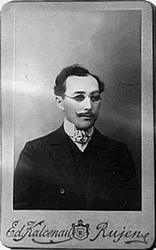
Joseph Levitan, Nechemia's father
It was only some years later that I learned why my father ran away. It seems that this quiet, orderly man and factory manager was, indeed, an underground revolutionary. Joseph Levitan, manager of a candy factory, succeeded in smuggling weapons into Latvia from a foreign country for the use of the underground, in crates that were presumed to contain raw material for the factory. When his friends were warned that his ruse had been discovered, they smuggled him out of the country. My mother never spoke of my father's escape and never mentioned anything of this whole episode. The Tsarist counterintelligence was well-known for its cruelty, and surely must have made efforts to obtain information about him. My mother said nothing and my big sister warned me not to bother her with questions on this subject.
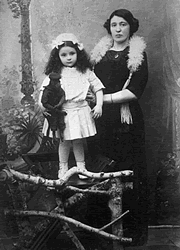
Nechemia's mother, Bertha, with his sister, Lena
Before long, the German Army approached the border of Latvia and many Jews started fleeing eastward into Russia. My three uncles decided to leave Ruyene and took my mother and her children and my grandmother on my father's side, with them. I don't know how my uncles managed to make the long journey from Latvia to Perm, in the foothills of the Urals. I was too young to remember.
I do recall quite a bit about our stay in Perm, which was a fairly large city on the banks of the Kama River. The city looked to me more like an overgrown village. The streets were paved with large round stones, and there were many two-storey wooden houses, but similar to the one-storey houses that villagers built. In winter, the Kama River would be covered with ice over its wide expanse. In the spring, we would hear terrific noises and I and all the children would run to the shores of the river to see the ice breaking up and the large chunks would float downstream. Farther down, the Kama would flow into the "Mother Volga," as that river is called by the Russians. The Kama River was the lifeblood of Perm, and connected her with central Russia and by way of the Volga, with the south as well. During the rule of the Tsars, prisoners would pass through Perm on their way to Siberia. During the rule of the Communists, the Perm Prison became infamous.
Our life in Perm was difficult after the Revolution and during the Civil War. My mother told us that our uncles, the doctors, helped us a great deal. Villagers who had need of them paid them in agricultural produce, flour or bread, potatoes and sometimes meat. My enterprising and energetic mother started a little household industry using materials she received from farmers and from her brother, the pharmacist. She manufactured soap in the bathtub and sold it or exchanged it for whatever we would need. I remember that we had a large courtyard in which we used to play, my sister watching over me, and my grandmother keeping a watchful eye on both of us.
While at Perm we received the awful news that our father had been killed in the Civil War fighting against the Poles. Friends wrote my mother, saying that my father had been the "Politruk" (political guidance counsellor) of his unit. They arranged for all of us to ride by train to Petrograd. My mother agreed to make the trip if they would also help us in Petrograd, and they did promise to do so. When I asked her once why we left Perm, she said it was to be nearer to Latvia and Estonia, where her sisters lived, in the hope of being able to visit them as soon as would be possible.
We parted from our three uncles and never saw them again. Once, when I was in Moscow in the 'fifties (I served in the Israel Embassy there), I heard that my eldest uncle, the psychiatrist Professor Ilion, had passed away a short time previously in the city of Gorky. I never heard of the other uncles.
My mother started out on the long journey with tears in her eyes. In those times of unrest and upheaval, every journey was fraught with danger, and this parting was to be forever. We were given a whole freight car for ourselves. The uncles helped us load all our furniture and kitchen and bedroom articles. We could sleep on mattresses and in general, conditions were not bad. The trip took a whole week, as we had to traverse all of European Russia. We stopped at many stations along the way, and at some we were delayed for many hours. Sometimes, weather permitting, we opened the heavy door a bit and watched the scenery which passed by the train: forests, fields, rivers and streams, and miserable villages with their huts and hovels.
In Petrograd, at the huge train station milling with very many people, we were met by total strangers. They took care of all our furniture and moved it over to a big apartment building and led us to a large apartment on one of the upper floors. The apartment was so large that we could not afford to heat it all in winter, so the extra rooms were closed off and we only used and heated what was necessary.
I remember our address in Petrograd to this very day. We lived on the island of Vassilievski, that the Neva River encircles on all sides. The island was attached to the center of the city by a long bridge. The isle of Vassilievski is a very nice residential area. The main streets run from east to west, and include three wide boulevards known as "the Small," "the Medium," and "the Large"! These were divided at right angles by smaller streets that were numbered. We lived on 6th St., house number 43. An electric tram ran along this street and the noise of its warning bell and of other traffic filled the air.
This was a period of economic depression and there was a lack of many essentials. The First World War and the Revolutions left many scars on the face of the country. I to this day do not know how my mother managed to support a family of four souls. We must have received aid from some institute or organization to move from Perm to Petrograd. Perhaps my mother also sold some of the family valuables from time to time. My resourceful mother carried on a relentless war of survival without our being aware of her difficulties. She was always a calm and smiling personality.
The city was only starting to reorganize and recover from the street fighting of the revolution. Slowly, the new regime renewed the various city services. We had water in the apartment, but the elevator did not work, nor was there central heating. We, like all our neighbors, bought a small wood-burning stove for heating and cooking. From the stove an exhaust pipe extended to a window, so that the smoke could escape, and this pipe also served to heat the apartment. We would search for wood in abandoned houses and wherever else possible, my sister and I became experts at this trade which supplemented the small amount of wood that Mother could afford to purchase.
Wandering the streets of Petrograd kept us occupied and interested. The city, charming in its beauty, was founded by Peter the Great in the 18th century. He chose the area where the Neva River spills into the Gulf of Finland. Petrograd replaced Moscow as the capital of the country, and became a "Window open to the West." Peter and the Tsars that followed him brought architects from the West who planned its streets, boulevards and bridges. The buildings were built in the French style of the period. I was fascinated by the city as a boy of seven, so much so, that 32 years later, when Beba and I visited Leningrad (formerly Petrograd) I was still amazed by its beauty, the statues and the squares, the Winter Palace and Kazanski Sobor Cathedral, which even the anti-religious Communist regime was careful to preserve. I even remembered the Lion statues on the bridge. I led Beba from our hotel in the center of the city to 43 6th St. on Vassilievski Island, and went everywhere in the city without having to ask for directions.
Another reason perhaps, as to why I recalled the city so well is that I read a great deal of Russian literature avidly in my youth. The city plays an active part in the writings of many well-known writers and poets: Pushkin, Gogol, Dostoyevsky and Alexander Bloch. I also liked to look at the drawings in the beautiful edition of Pushkin's writings. My mother bought this book in Petrograd at a bargain and we have guarded it well since then. These pleasant memories of Petrograd helped me forget the difficulties of the early 1920's. On the other hand, I recall little of school in the young grades, probably because my sister taught me to read and write even before I started formal schooling, so that I was bored most of the time. I preferred playing with the neighbors' children in the large courtyard of our house.
My childhood Petrograd period was drawing to an end. One day my mother came home very late and gathered us round the table. She told us that soon we would leave Petrograd for the city of Riga, capital of Latvia. From Riga, our grandmother would sail to America, to our two aunts, our deceased father's sisters. We, Mother, sister and I, would continue to Tallinn, capital of Estonia. My mother's oldest sister, Debora, lived there and she would help us settle in Tallinn. Some time later, our mother told us that some of her husband's friends had arranged to get them moved to Tallinn, and a Jewish-American philanthropic organization arranged for our grandmother's passage to the USA.
Shortly thereafter we left Petrograd for Riga (this time by passenger train, not freight train). As soon as the train crossed the border we were met by a tall, elegantly dressed man. He smiled and addressed my mother in Yiddish. I, Niuma (as I was called by my Russian diminutive) decided immediately that this was our good uncle. Actually, he was the representive of the American Jewish organization, and he helped us in every way possible. We were given train tickets to Riga, he had a man transfer our baggage from train to train, and brought us lots of food to eat on the trip to Riga. I probably remember all this so well because of the impression that all the delicious snacks made upon me. He stayed with us until the train pulled away from the station and then waved us on our way.
At this point, I shall stray slightly from my story. More than 43 years after that day at the Latvian border, while I was working at the Israeli Embassy in Washington, I became very familiar with a leading representative of the JDC (Joint Distribution Committee, commonly known as "the Joint"). This organization did a great deal for needy European Jewry after the First and Second World Wars from its inception in 1914. During the 'sixties, when I was sent on behalf of "Nativ" (an underground organization that opened a route--nativ, in Hebrew--to help Jews leave the Soviet Union), to work among the Jews of the Soviet Union, I worked closely with representatives of the Joint, and knew some of them very well. At a meeting with one of them one day, I told the fellow how, as a boy of seven, I had met this "uncle" at the train station at the Latvian border. That fellow told me that in 1922 the Joint received Soviet permission to help those Jews who were war refugees. No doubt that the "uncle" was from the Joint. Then this Joint representative concluded, "Now this little boy of seven has grown and is an important source of information for us in everything concerning aiding Russian Jewry today."
To return to where I was--In Riga, we said goodbye to our dearly loved grandmother. I was very sad and probably cried. Mother explained that grandmother had not seen her daughters for many years and yearned for them.
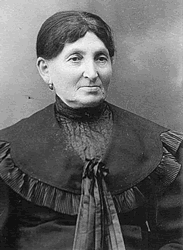
Nechemia's grandmother on his father's side
After parting from grandmother, we continued by train to Tallinn. My childhood years, that had encompassed Ruyene, Perm and Petrograd were over and gone.
Tallinn, School and Youth Movement
Aunt Debora Gurevitz received us warmly and with joy. The aunt was married to a widower, a prosperous grain merchant. They welcomed us into their spacious apartment with open arms that first day. The family consisted of my aunt and her husband, their young son, and three older children of her husband's by his first marriage. Next to the apartment were the uncle's offices. I don't know who really worked in the office, as the uncle was not in good health and only went to the office from time to time. I think it may have been the eldest daughter that did most of the work there.
Aunt Debora was an educated woman of striking appearance, and she made great efforts to ease our adjustment to Tallinn. This was quite difficult, for although she had help for the care of the house, she had to look after the needs of her sick, weak husband. Her young son was also sickly and caring for both took much of her time. To me, she looked tired and drawn, but she always smiled at me and patted my head.
From the outset we felt a bit uncomfortable in the house. Despite the welcome, we felt that the uncle did not really like us, nor did his older children want this addition to their household. The house we lived in was in a swanky neighborhood on a central thoroughfare and we did not have any playing area nearby. In short, both I and my sister did not feel comfortable there. The uncle looked grouchy most of the time, so we kept mostly to our own room. My mother went out to look for work and did not have much time for us. She also looked worried and unhappy most of the time because she too felt that we were unwanted guests, despite all the sincere efforts of her sister.
I do not remember how long it took, but soon my mother found a small, modest apartment. We were overjoyed. Mother found work which was barely enough to support us. Sometimes, if we needed a little help, it was the friends that Mother made who came to our aid, more than our relatives. Some time later, Mother found a better job, so life was a bit easier. The Jewish community in Tallinn numbered more than two thousand people, and there were two Jewish Clubs. One--a club for Zionists and their supporters, called "The Bialik Club," and the other, "the Peretz Club." Both were social-cultural clubs. Jews would meet there for a cup of coffee or a game of cards or chess. In the Bialik Club there was a small lunch-counter, cafeteria which served lunches and suppers. My mother managed this; she also cooked and served. About ten people would come to have their meals there; most of them were Jewish businessmen visiting Tallinn. We received two small rooms from the club, in which we lived. Mother was very pleased with this arrangement. She could watch over us while doing her work.
The Chazan (Cantor) of the synagogue taught singing in the school. He chose me to participate in the synagogue choir. The choir consisted of about twenty children and a dozen men. Between holidays there would be rehearsals, and on holidays, we would sing with the cantor. The cantor was a nice person and I participated willingly in the choir, but that did not bring me closer to religion. Aside from the High Holidays, I don't think I ever went to the synagogue.
From term to term, I improved in my studies and by the time I finished elementary school, I was one of the outstanding pupils. During vacations, I spent most of my time with the other pupils that did not go to camp. We invented games that brought us to all corners of the city. Tallinn was a city that had a character of its own. It is a port on the Gulf of Finland that was established by Danish invaders, on the ruins of which the Estonian city of Lindnese was founded. Tallinn became its Estonian name. The Germans and Russians used the name Revel, that has its roots in the Danish word "Rock." Indeed, the city was first built on rocky outcrops and low hills. The Germans built the fortified center of the city on top of a hill called Domberg--"Church Hill" in German. This old section of Tallinn is built in Gothic style. The narrow streets and the old church are very well-preserved. The inhabitants of the Domberg keep the area in clean and excellent condition, and this lends a certain charm to the city. Around the Domberg section, parts of the old wall of the town are still standing, with round guard towers here and there, and gardens encircling them. In the spring and summer, I played there often. In the winter, after the snow had fallen, we would go tobogganing on the slopes of the gardens.
As a Gymnasium student, I would go for walks in the park with my school chums. We would walk along the main boulevard and remark on the beauty of the blonde Estonian girls that were passing by, and in winter we would go skiing.
I entered Secondary School (the Jewish Gymnasium) with a good deal of self-assurance, since I had done extremely well in elementary school. The Jewish Gymnasium was a recognized government secondary school. The young Estonian Republic was liberal, and not only the large minorities--Russian and German--had cultural autonomy, but even the small Jewish minority enjoyed all the privileges that the government granted. In Tallinn, with its 2200 Jews, and Tartu, with 900 Jews, the government built secondary schools, and in the University of Tartu there was a cathedra for the study of Jewish culture.
Even under the Empire, Estonia was noted for its high standard of education and culture. The percentage of literacy was much higher there than in the rest of Russia. The percentage of those attending high school and university was also much higher. Tartu University was one of the best in the Russian Empire. Little independent Estonia invested a great deal of its resources in education, art and culture. Among the cultural institutions in Tallinn, which was not a large city, there was an opera house and ballet, theaters, and a symphony orchestra.
Until quite recently, Estonia had remained outside the Pale of Settlement (the region of Russia where Jews were allowed to reside). Therefore, most of Estonia's Jews came from Latvia, Lithuania, or Poland.
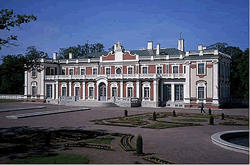
the Tsar's Summer Palace in Tallinn
The Jewish community was segmented by a diversity of political leanings. The Jewish school in Tallinn found a partial solution for some of the problems. The language of study was Russian. Hebrew and Yiddish were taught, in addition to Estonian and German. Estonia was also outstanding in the field of sports education. The influence of Finland, the Northern neighbor, was felt in this aspect. Finland was a world-class competitor in many kinds of sports. Our school tried to keep up to the standard in this area also.
I recall this period of Gymnasium study with many pleasant memories. I liked the school very much and had respect for most of the teachers. I felt I had a good standing among my classmates and often helped other students in some subjects. This was quite important, and not so easy to achieve as most Jews of Tallinn were in the well-to-do merchant or professional class, and our family were poorer and not on the same social level of the "sons of the well-to-do." I was a special case, and despite the fact that my mother barely earned enough for our upkeep, I was rather popular with my classmates. Despite our poverty, my mother always sent us to school dressed neatly and cleanly and we participated in all the after-hours social events. When I think of what this stage in our lives meant for my sister and myself, I value very highly all that my dear mother did for us, in raising us under such difficult conditions so that we could feel secure and equal to our wealthier peers.
I owe a great deal to my high school teachers (most of them were not Jewish). The good ones broadened my horizons and gave me the will to learn and the knowledge of how to go about studying on my own by reading books. The lessons of the teacher of Russian literature were fascinating. The German language teacher gave us a love for the German classics, Schiller, Goethe and Heine. He was also our class director. In the spring he would take the class for hikes in the woods and this brought him to a good rapport with the students. I recall the day before the elections in Germany, he came into the class and said, "I hope Field Marshal Von Hindenburg will save us from that madman!" He devoted the whole of the following lesson to this topic. The math teacher was an engineer and a former Russian Army officer. He and the teacher of German had come to Tallinn from Peterburg. He was a strict and exacting teacher, but he knew how to interest us in the subject. The Yiddish teacher was a likable fellow and he was a Zionist also. The Director of the school was also the history teacher. I did not care for him as an individual, but I respected him as a teacher; he happened to be anti-Zionist. I recall some of his lessons to this very day.
The physics teacher was an old bore. I wasn't very good at learning Estonian. The teacher was a good-looking young woman. I paid more attention to her shapely legs than to what she was saying. The deep decollettage of her gowns also drew our attention. Two floors of the building of our school housed the Russian Gymnasium. Between lessons we would examine the Russian girls, also, but not much more than that. We would play basketball and volleyball against the Russian boys.
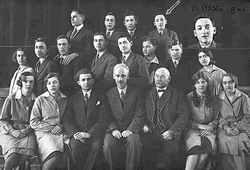
High School Photo - Nechemia is marked by an arrow
Outside the school, I led a full and active life. I was active in various fields of sport and had a busy social life. I played basketball and football (soccer) and volleyball. In the summer I was busy in field events and swimming. In winter I preferred skiing and ice skating. In some of these events I was an above-average player and competed for our school against other teams from Tallinn.
My social activity can be divided into two phases, the first--before the great change that affected me, and the second--that which came after that change. While still at school, I joined the "Jewish Battalion," this was part of the boy scout movement. I was a scout for some length of time, until after I went to the gymnasium. I liked the activity of the scouts and nature, hikes and camping in the woods, discussions and singing around the campfire,and erecting towers in the forest (without nails, using rope only). When I was 15 years old, I was drafted into the Zionist student club, "Emuna" (Faith). This club tried to resemble all the other clubs of the time. Students continued on into university into other Jewish student clubs in the University of Tartu. One such club was called "Hasmonia" (Russian for Hashmonaim). The other club was called "Limovia." These two clubs, like all the other Russian and German clubs, called themselves "societies," and each had a flag and a theme song, in addition to the student anthem, "Gaudeamos Igitur" which was sung in Latin. The Society had a strict code of behavior, the older boys held power over the "rookies" and the chief of the Society was all-powerful. The Tartu "societies" were run according to the German style, and they trained in dueling. I heard of actual duels that took place and the participants were wounded. I did not see any students with scars on their faces in Estonia, but I heard this was quite a common occurrence in Germany. Each Society had a clubhouse in which the students spent their spare time. The older students broke in the younger ones to beer drinking. They would also meet in the pubs in town and drink beer and sing. One could tell to which Society a student belonged by the color of his hat.
Of the two "societies" Limovia was more severe in the formalities of the anthem and other accoutrements of the Society and was also apolitical; it belonged to no specific party or cultural element. Hasmonia, on the other hand, was less formal as a Society, but defined itself as Zionist. Actually, most members of Hasmonia were connected to the Revisionist branch of the Zionist Movement.
I have described all of this in some detail because all of us who were members of Emuna saw ourselves as potential members of Hasmonia, even if we were not Revisionists, because we preferred a Zionist affiliation to that of the assimilationists.
I don't remember exactly how the Emuna Society chose its new members, but I do recall that not every candidate was accepted. During the first semester we learned the rules and regulations of the Society, we learned something about the Land of Israel and some of the fundamentals of what Zionism was. When we were accepted into the Society, we met at least once a week in the small club room decorated with the flag of the Society, with pictures of Herzl and Max Nordau and classes of alumni of the Society. At the meetings, having finished with the conduct of the internal affairs, there would be lectures and discussions. The lectures usually dealt with chapters in the History of the Jewish People (following the book on this subject by Simon Dubnow), and on the development of the Zionist Movement. The latter also dealt with actual, current problems of Zionism. Most of the lectures were prepared by members of the Society.
Perhaps the older members of the Society were impressed with my lectures because while still rather young, I was chosen as chairman of the Society. I found this highly complimentary that the members of my class expressed their trust in me in such a way and I was congratulated by many.

Nechemia, Chairman of Emuna Society
The class spent much of its free time together in social parties, sometimes in the house of one or another of the students. There were a few "couples" among the boys and girls, but most of us were "unattached," and there was a measure of flirtation or romancing. To sum up, what with studies and sport, Society meetings and reading, which I enjoyed greatly, the years in Gymnasium passed quickly until the "upheaval.
The story of "the great change" starts in my next-to-last term. Most of the fellows in the Emuna group to which I belonged were from rather wealthy families. From that point of view I was an outsider, and I must have felt so. I already wrote that I had no love for the Revisionism of Jabotinsky. I already knew something of Ben-Gurion and the labor movement in Israel. I had heard a lecture by Yosef Beretz, one of the founders of Dagania, who visited Tallinn on behalf of the Jewish National Fund and Keren Hayesod ; it seems that I was ripe for a change. One day, a striking young man arrived in Tallinn, dressed in a brown jacket, a gray shirt, riding breeches and high shoes with knee-high stockings. I was told that this was not a uniform but the ordinary dress of the older level of "Shomrim"--that is, the Hashomer Hatzair Youth Movement, pioneer youth scouts in Latvia. The name of this interesting fellow was Lasik Goldberg. Lasik lived and was educated in the provincial town of Rezekna and in the youth movemet "Netzach" (Noar Tzioni Chalutzi--Pioneer Zionist Youth). He was sent by his movement for the express purpose of building branches of the Netzach movement in Estonia. I learned all this from my first conversation with Lasik. The meeting originated through a member of the Socialist Zionist movement in Tallinn who was a distant relative of mine and recommended me to Lasik.
I was entranced by Lasik. I was attracted to all his stories. This was the first time that I heard about a movement of Zionist youth, a pioneering scout movement that raised the standard of "self-fulfillment" of the Socialist-Zionist goal. Lasik described to me the history of the movement, its character and its methods of youth education. He told me of the Russian members of the movement who succeeded in going to Palestine in the 'twenties and founded Kibbutz Afikim in the Jordan Valley. The members of Kibbutz Afikim broke away from the (Polish) Hashomer Hatzair movement and sent some of their people to build their branch of the movement in Latvia, Lithuania and Estonia, Czechoslovakia and Transylvania. Later they joined with the Habonim movement in England and the USA. I was particularly impressed by the USSR branch of the movement that worked for a time within Russia and some of whose members were caught and sent to hard labor in Siberia.
I was in turmoil. I lost interest in my activities in other frameworks and saw them as unimportant, a waste of time. My activity in Emuna and Hasmonia ceased and I lost all interest and contact with them. I devoted myself completely to the task that Lasik had given me; I was to convince the students in our Jewish school to join our new movement which Lasik was organizing. I suggested to Lasik that we organize the class of 14-15-year-olds, as I did not see any appropriate candidates in my own class. The wealthy students in my class were nice but too comfortable with their surroundings to be attracted to the movement.
I must have found the right road to the hearts and minds of the younger children. Lasik himself worked to get the support of parents for the new movement, which he thought should be within the framework of the scout movement. We resurrected the Jewish contingent of the Boy Scouts with the accompanying uniform and flag, etc. We had a blue/white Jewish flag with the Boy Scout symbol in the middle. One of the boys learned to play the drum and became very good at it. Lasik took my advice and we started with one group of kids from 10-12 and another group from 12-16. We figured that the youngsters would mature into the older levels of the movement. We soon had quite a few groups of children organized into units. The unit that I myself lead was called "Trumpledor," but I also met and helped the leaders of the other younger groups.

Among the Netzach leaders in Tallinn
On holidays and special events, the whole branch of the movement, called Legion, would meet. In Latvia there were four Legions in the cities of Riga, Dvinsk, Libow and Rezneke. The region around each such branch were called Galil (region). With the founding of the movement in Tallinn, this became the fifth region of the movement. There were definite advantages to leave the movement in the framework of the Scout Movement, as the idea of taking the Jewish children from the town out into the country made many other things easier, educationally, and would help us prepare ourselves for the future Aliya (immigration to Israel) and Kibbutz.
Education in the movement predicated personal example on the part of the leader. I tried to be the perfect scout, and since I loved scouting, that was not too difficult for me. I was swallowed up by the movement and my marks in school suffered. However, I passed my exams well.
My sister went to study in Tartu and married another student who had almost completed his studies (he belonged to Limovia). I remained with Mother, to whom I did not devote enough time, but she never complained. She encouraged me to continue on the path I had chosen. My mother rented two rooms to the movement and these were our first Moadon (meeting place) in Tallinn. This was convenient for all, as I was active, and also close to home.
Shortly before Pesach, I was asked by Lasik to go on my first Shlichut (mission). A request came from the Jews of Finland that the community of Tallinn send a leader to the Jewish Boy Scouts in Finland for several weeks, so as to strengthen their Jewish identity. The Tallinn community supported the request and took upon itself the financial support of the leader. Lasik helped me prepare and gave me educational material. I crossed the Bay of Finland by ship and arrived at Helsinki. I had heard that there was a small Jewish community there, and still smaller ones in two other towns. These communities, small as they were, tried their best to preserve their Jewish heritage. Most of them spoke Yiddiesh and those that were not religious kept the customs and the holidays.
I was 17-years-old at that time and had some doubts as to my abilities. Two 20-year-old fellows met me at the pier and we made each other's acquaintance. They were the leaders of the Jewish Scouts in Helsinki. From the port they took me to my dwelling place that they had prepared for me, not far from the center of the city, next to the synagogue. It was quite a comfortable room, and was usually used to house the Darshanim (those that were invited to lecture to the congregation on Saturdays). These were rabbis or scholars that came from Latvia or Lithuania.
I left my luggage in the room and we went to the home of one of the fellows to eat supper. After supper we spent several hours in conversation. They told me of the difficulties of parents in a small community with not very many children. The community is interested in the children doing scout work, but they would prefer it to have a Jewish flavor. They told me what they expected of me and I told them what I had prepared to do. We decided to meet again, they gave me some pocket money and said that until Pesach I would eat at the houses of parents of the children. When I got back to my room I counted the money and realized I had really been given very very little pocket money. There must have been some mix-up. Lasik thought they would cover all my expenses, and they thought that Lasik would cover them. I wrote to Tallinn and told them to send me more money, and meanwhile I had to nurture every coin.
I had my first meetings with the scouts and I was encouraged by them. The parents knew Yiddish very well, but the children understood with some difficulty. However, we overcame that and in general, they listened with interest to what I had to say and there was a good atmosphere at the meetings. Together with the other leaders we made plans for the Pesach holiday which was soon to begin. Before the holiday vacation started, I had some free time in the mornings, so I made myself familiar with Helsinki and toured the museums.
I ran out of money and when it came to the Seder night I was starved, as I hadn't eaten all day. I remember that Seder to this day. Two families were seated at one table, including children and grandchildren. The table was prepared in the tradition of the Seder and everything was there in abundance. The Seder was conducted by a distinguished-looking gentleman with a pleasant voice. We read the whole Haggada and heard explicit explanations. I thought it would never end. When we finally started eating, I tried everything there was to eat and in quantity. By the time we reached the Had Gadya (a song near the conclusion of the Seder) I had eaten my fill, I was in a good mood and sang lustily. I had been redeemed.
During the Pesach holidays I conducted many activities; I was full of energy. I felt I was doing my job well and that the children were enjoying themselves. Aside from activities in the clubroom, we also went out to the forests around the city and we spent nights camped in tents. It was nice to hear the children singing Hebrew songs around the campfire (probably for the first time in their lives). I liked the Finnish scenery, the dark green of the tall pine trees, the gray outcroppings of rock on the shores of many lakes.
Now time started to fly. I managed to visit the city of Turko, far to the west of Helsinki. There was a very small community of Jews there, and they seemed very isolated. However, their determination to hold on to their Jewish identity amazed me. I gathered together the dozen or so children and talked to them and to their parents.
Upon returning to Helsinki I made plans for finishing up my shlichut. I had talks with the younger and older leaders and made plans for the following summer and winter holidays. They made me a little farewell party and so, with a feeling both of satisfaction and of sadness, my first shlichut came to and end. I thought I had accomplished quite a bit in a short time, but had the feeling that without a continuation, it could not last for long. I did not think I would ever return to Finland, but I was wrong. Twenty years elapsed before I returned, but this time it was an altogether different kind of mission. (I described that mission in my book "Code Name: Nativ" {Path}). I remember my first visit in detail.
I returned to Tallinn and divided my time between my final year studies in Gymnasium and my activity in the movement. I had to prepare for my final exams in school. At this moment I had to make a very difficult decision. This was the situation: There were thousands of Chalutzim (Pioneers) in central and eastern Europe, many of whom wanted to make Aliya (immigrate) to Palestine, but could not get certificates because of the limits on immigration imposed by the British Government. Some of them went to villages to work in agriculture, in groups called Hachsharot (Training Farms). Others, as they grew older, became adult sympathizers fo the Zionist Movement. Lasik wanted to go back to Latvia to prepare himself for Aliya and he wanted me to replace him as the leader of the Movement in Estonia. However, a group also formed in Estonia to go on Hachshara, and as I was one of the oldest, I wanted to join them, according to the principle of "self-realization" (or self-fulfillment; in Hebrew, Hagshama Atzmit). Of course this meant leaving my mother all alone, but she was very supportive and urged me to do what was best for me. Since our group had to be at the farmer's village for the hay harvest, we would have to leave the city before graduation ceremony. Mother said she would take my diploma and bring it to me on her first visit.
In the spring,we set out to a large farm far from Tallinn, in western Estonia.
the Hachshara group
Our group numbered 18 young fellows and girls, all of them several years older than me. Not only was I the youngest, I was also lacking in any work experience. Maybe the others hadn't worked in farming, but they did have some work experience. I knew it would not be easy for me, but I believed I would manage. At the farm, we were given a small storeroom to be used as dining hall and place to spend our spare time, and we would sleep in the attic on straw bedding. We could wash-up at two wells nearby, one for boys, the other for girls. This farm was actually a very large estate with a large, beautiful house in the midst of other farm buildings, storage rooms, dairy barn, stables, and a smithy. There were also a few shacks where the regular workhands lived. Aside from these "regulars," there were also tens of seasonal workhands. The owner was a small, roly-poly German, a tough but decent man. I think he treated us rather well, and was patient with us because of our inexperience the first few weeks.
The regular workers did the jobs requiring greater skill, plowing, sowing, harvesting and working with the horses. We did the simple seasonal work, harvesting with scythes, stacking and loading hay with pitchforks, removing manure from the barn and spreading it in the fields. We also cleared fields of stones. The work was very hard and the days were very long. We did our best not to fall behind the husky, experienced village women, but we didn't always succeed. I grew blisters on my hands and my back ached terribly. By the evening, I would get back to the attic exhausted and throw myself on my bed of straw. Only after several weeks of "black labor" we started doing more skilled work. Some of us were even allowed to drive the horses.
At first, we were too tired after the day's work to do anything in the evenings. It took us about one month to become accustomed to physical labor. When the blisters healed and the fatigue lessened, we would stay awake longer and talk or sometimes go for evening walks. As I look back at that period, I recall that the sure sign that we had stood the test of manual labor was when we would stay up till late at night singing. We sang songs of the Land of Israel and we sang Hassidic Nigunim (melodies). Far, far away from the Land of Israel, by the shores of the Baltic Sea, we sang, "Ve Ulai lo hayu hadvarim le olam Ve ulai..." (a very popular song by the poetess Rachel, about the Sea of Galilee). We were not troubled by the fact that nearby were the cold gray waters of the Baltic; we were dreaming, probably.
We asked our relatives not to visit us until we had settled in. My mother arrived in the latter half of the summer. I thought she would be troubled by my appearance, but she was true to form; she said, "You look tanned and healthy, and a bit slimmer." I showed her my hands, the hands of a farmhand, and I told her that the blisters had hardened and did not trouble me. We went for a walk in the fields and she told me a little about herself and my sister. I told her frankly how difficult the first days were until we got used to the work. It was a great day for both of us.
Autumn had almost arrived and we received a letter from Lasik that he had rented a small house for our group to live in, in a workers' section on the outskirts of Tallinn. He also mentioned the possibility that some of the group might get certificates for immigration to Palestine.
The day of departure finally arrived, and we took leave of the fat little German and the steady workers. We were the last of the temporary workers to go. We had had some very difficult times there, but also some very beautiful experiences.
We returned to Tallinn and I went to tell my mother that I would be living with the rest of the group, but would come to see her often. Mother was still living in the apartment where she had rented a room to the movement. I was to take over from Lasik in the movement for half the time, and the other half, I was at the service of our group. The house we lived in was very crowded, but there was a friendly atmosphere there. Several months after our having moved there several chaverim (friends, members) received certificates of immigration to Palestine. They left, and new memebers came to join us in their stead.
The movement meetings were in the room in my mother's house, so I would see her before and after the meetings and we would have long conversations. I loved discussing things with my mother. She was a sympathetic listener and we understood each other very well. One day I came up to her room and it was locked. Someone told me she had gone to the hospital, so I ran there. I stood by her bedside shocked; she was very pale and talked without raising her head from the pillow. "Don't worry and don't be sad, everything will be okay," she said. I kissed her forehead. Several days later I stood by her grave and read Kaddish (the prayer for the dead) with tears in my eyes and my heart.
I returned to the kibbutz apartment (commune) and lay on my bed. One by one, chaverim and chaverot (friends, male and female) came in and sat around. No one spoke; they were just there with me for a long time...
It was then time to say goodbye to Lasik. We not only respected him as our leader, we loved him as an individual. He took me to Latvia to participate in several events there and to get more of a feel for the movement, and I was impressed. It was not simple to "fill his boots" and only after I felt that I had made some headway in the movement did I gain more confidence.
Most of my time was taken up with the Legion of the movement in Tallinn, but I also would visit the other branches (four smaller ones) in the other cities of Estonia, and sometimes the leaders of those branches came to see me. Most of the mail and other printed educational material was distributed to all of us direct from Riga.
The group in Tallinn grew. The best of the youth in the Jewish school came to us. We had a large group, with new leaders who worked together closely and were also good friends. The youth had a feeling they were doing something constructive and important. They liked the movement and they liked to spend time together in the Moadon (clubhouse). They enjoyed scouting and hiking and comping out, summer and winter. All these activities created close ties between the madrichim (leaders), as well as between them and the youth they were leading.
I was in steady contact with the leadership of the movement in Riga and visited them also periodically. Sometimes I, or a group of the Estonians, attended summer camp of the Latvians. The contact with the large movement that also had shlichim (representatives) from Israel was vital to us and we felt that we were duly respected by the others and we held our own in scout and sport competitions. However, we were probably also a bit foreign to the Latvians, and no strong personal bonds were formed between, or within, the two groups. I remember one camp at which there was a mixture of Latvians and Estionians from both the large cities and a number of the smaller towns.
The atmosphere of this camp was very good and I was proud of the behavior and achievements of my bunch. I recall a small passing incident: in the movement we usually did not encourage "romantic episodes" and there was comparatively little loose sexual interplay, and I also was wary of spoiling my reputation with the younger scouts by engaging in too loose behavior in this manner. But one day I happened to notice a beautiful, vivacious young woman in a group of scouts from Dvinsk. I was stricken with her and indirectly inquired about her and found out that her name was Beba Levin.
Soon after this camp had closed down, there were some drastic changes in the Republic of Latvia. The Social-Democratic Party that had been in power was badly defeated by the right-wing conservative National Agrarian Party. The regime of their leader, Ulmanis was a domineering man who ruled almost single-handledly. There was no room for a socialist youth movement under his rule. With the aid of a member of Parliament, Rabbi Nurock, the government did allow the establishment of a youth movement going by the name of "Olim" (immigrants), the aim of which was to educate Jewish youth to immigrate to the Land of Israel.
The Netzach movement continued to operate, but did not hold any public meetings of any sort that would attract attention. The head committee of Netzach therefore decided to hold a leadership seminar in Estonia and I was to make all the arrangements for this activity. The seminar was a success and it was also there that I met for the first time a promising young leader, Rivka Dukravitz. She was from Dvinsk and appeared to be a serious and capable person. This first perception did not alter even after many years of living in the same kibbutz, Kfar Blum.
As the summer approached, I was asked by the movement leadership committee to find a place to hold the summer camp for the Latvian movement in Estonia, and to get the necessary tents and equipment and food supplies to run the camp for its duration. I found what looked to be the most suitable place on the island of Serema, not far from the mainland of southern Estonia. The Latvians came by ship from Latvia and we came via a port in Estonia to the south side of this island, somewhat inland from the main town of Kuresare, and hidden in the woods with only some farmers' houses spread about, and the small fields they cultivated. We bought our food in the town, and some from the surrounding farmers. We drew water from the well in buckets. It was a wonderful camp and a uniting experience which gave added strength and vigor to the movement.
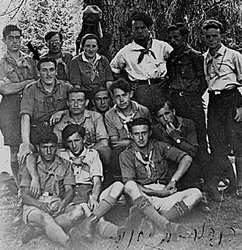
Kuresare Summer Camp staff, 1935
This camp was my last activity in Estonia. I was told to find someone to take my place in Tallinn and I was called to join the group of leaders in Riga, where the movement numbered about 300 members of all ages. I had started preparing someone to take over from me, because I thought the time was approaching for me to make Aliya (immigrate to Palestine). I chose Monka Shmotkin as being the most capable and responsible, even if sometimes a bit bombastic. There was a group of other good people as leaders of the movement. I was certain that they would get along without me. More than fifty years have gone by since I took my leave of the movement in Tallinn.
In 1990 I visited the city again, with Beba. I found that besides the few who had managed to emigrate to Israel, very few others remained alive. I learned that when the German Army drew close, the group of leaders, with Monka at their head, decided that at that moment the most important matter was the fight against the Nazis, so they volunteered to join a battalion of Estonian-Soviet soldiers and fell in the course of battle. We sat in the house of Vulia Shatz' sister with those that remained and recalled the "good old days." We were warmly received by them and I was very moved by the memories, but deeply saddened. I'll go back to the past later.
Riga, A Mission for the Movement, Aliya
I took my leave of my sister and the kids I worked with in the movement and the leaders of the Socialist-Zionist Party that had supported our work. I arrived in Riga, where they had prepared two jobs for me: I was to be in charge of all the scouts on one level (age group) and specifically, I was to lead the Herzlia troop. I considered the latter to be the more important, because if I succeeded with that one group it would have a positive repercussion on the whole age level. When I left for Riga I knew that all the madrichim (leaders) who did not have a home in the city had to live very frugally, because the sum that the movement was able to give them for their support was a pittance. This did not worry me particularly, however, as even in Tallinn I had learned to live on very little money. In Riga I boarded for a time with Eliezer Porat (Fried, at that time). He came from a small town in the hinterland to study at a technical school in Riga. This had a good side to it since he often received packages from home and he would share them with me. During the subsequent years that I lived in Riga, I wandered from one little hole of a room to another, all over the city, but as I said, these difficulties did not particularly bother me.
The head of the Riga Legion was Chanan Feldman (Shadmi). He took charge mostly of the older group of members, called Shomrim (guards). Chanan (generally called by his nickname, Chodgik) was the supposed "culture expert" of the movement; he knew Hebrew very well, and knew all that was going on in the Zionist world and in Palestine. I had the impression that he was very well-respected in the movement. I got acquainted with the Central Committee of the movement and with the Shlichim (emissaries) from Palestine. I knew they were all waiting to see how this promising young fellow would make out. I realized that I had to prove myself at my job in these new surroundings.
My first meeting with the Herzlia troop went off very well and I gained much confidence. This was a big group of about 40 boys and girls; they were lively and intelligent, full of life and a bit noisy. Definitely to my liking. I felt, of course, that they were also testing me, to see what sort of a character was that Estonian that they had been saddled with.
I was warned that it would not be easy to work with this group, as the one who preceded me, Yisrulik Astrachan, had been very popular and very well liked by the group. However, from the outset, I felt at ease with them. About a third of the group came from the wealthier areas of the city, and the rest came mostly from the poorer quarter, "Moskva" which they called "Moskatch." Many of those from this quarter did not have more than elementary education, but others were going to Hebrew gymnasium. It was obvious that if I wanted to succeed, I would have to bridge between the two halves of the group, with their differing economic and cultural backgrounds. My plan was to be a disciplinarian when it came to formal meetings and other activities, but on an individual and social level, to be as kind and understanding as possible. When we would gather before the meetings at the moadon they would "latch on" to me and badger me with all sorts of provocative questions, and kid around with me; but once the meetings got going, I was the leader and took charge.
Once the meeting was over, we would leave together and walk for quite a long way until our roads parted. On these walks, I would act as "one of the gang" and we would talk about anything that entered our heads, but I also found ways to tell them a bit about myself and the movement in Tallinn. I found the kids from Moskatch particularly interesting and noted that what they lacked in formal education, they made up for in their knowledge of the ways of the world. The closer I came to any of the children, the more I could feel their inner world, so that in truth, I felt very close to the whole group and they bared more of their thoughts and feelings to me.
I did not only have activities in the moadon, but as in Tallinn, we went on many hikes and camped out in the woods. The troop flourished and more boys and girls from all over the city joined, and the name and reputation of the troop grew. My success with the Herzlia troop helped me with the whole age group, of course. I started preparing the troop for the transfer to the next age level. Along with an intensification of lectures, etc., I continued with the scouting and camping, and I tried to find new ways to do things we had previously done. Even hikes and camps can become monotonous. Once, I even went a bit too far, I'm afraid, as I look back on one incident. Through the help of one of the boys we were able to procure a pretty large launch, which we used to cross the Bay of Riga, and camp at a beautiful spot on the far side of the shore. On the way back, when we were still about a kilometer from shore, the motor went dead. I decided to swim to shore to get help, and one of the boys whom I knew to be a very good swimmer came with me. We swam to shore and managed to get someone to tow our launch back in, and so we arrived back in Riga safe and sound that evening; but the adventure could have ended badly.
It seems that some of the boys and girls in the troop had good enough relations with their parents so that they could tell them of the various activities in the troop. As a result, I became known to them as the "meshugener Est," the crazy Estonian. The kids in the troop liked that, and it served to improve my standing with them. I was convinced that the sum of these activities was not only good for the troop, but also strengthened the boys and girls as individuals.
While working in Riga, I had the good fortune to participate in a very important and impressive convention of the whole European movement, which was organized by the shlichim (emissaries) from Palestine. There were groups from the Netzach movement in Europe or other groups close to Netzach under other names, such as Habonim from England and Blau Weiss from Austria. There were also groups from Czechoslovakia, Austria, Transylvania, Yugoslavia, England, Latvia and Lithuania. Years later, they all became Habonim. This was an interesting meeting of Jewish youth from varying cultures who believed in similar ideals. Many of the lectures were by the shlichim from Israel, amongst whom I recall Elik Shomroni from Afikim especially, and Lasia Galili, also from Afikim. But to my mind, the central and most impressive character at the convention was Berl Katznelson, the well-known leader of the Labor Party in Palestine. He was a short man with graying curly hair and penetrating, intelligent eyes. He fascinated us and I recall that he did not dwell so much on the problems of the Labor Party in Palestine, but more about the problems of maturing Jewish youth in the Diaspora. During the question and answer session, he was asked about boy-girl relationships and he replied that it is true that young people do have trouble finding solutions for their sexual relationships, but then even adults, and he, too, didn't have all the answers.
I was very pleased with my Latvian Herzlia group at the convention. For example, before we left Riga, I suggested that we visit Vienna and Warsaw on the way to the convention, and Prague on the way back. In order to meet the expenses, they themselves decided to make a common "kitty" into which each would put all that they could get from home, and then share all expenses from the kitty. This example was followed by all the others in the Latvian contingent.
I recall my years of work with the Herzlia troop as one of the best periods in my life. I liked the whole gang very much and remember them vividly. Dicky, the fat gymnast, clever and responsible; Leibele, the strong man from the Moskatch quarter, that even the goy hooligans were afraid of; Tomachik, with a great sense of humor, fair and practical, whose older sister was already in Palestine and a member of Kfar Giladi. Cute, curly-haired Breindl was also from Moskatch; she was diligent in everything she did. Mulka and Yaka were the best of friends but totally different. Mulka was tall, strong and athletic,with a strong personality. Yaka was frail and blond, a good pianist, but did not shirk from hard work. Hemi was a sensitive boy; Feigele was good-hearted; Mulka Levin looked like a little boy but his mind was razor sharp. And there were others. All in all, a great gang.
Once again I will detour from my story and return to it shortly: there were difficult years for the Jews of Latvia after I had made Aliya (immigrated to Eretz Yisrael). With the outbreak of WWII, Latvia was overcome by Soviet Russia (as was arranged in a pact with Nazi Germany). This was a difficult period for the Jews there, but it did not last long. The Germans attacked the Russians, invaded the Baltic countries and drew near Latvia. The Jews fled into Eastern Russia and those that did not leave in time were exterminated in the Holocaust.
Some of my Herzlia scouts managed to get to Palestine before the outbreak of the war, but a greater number found themselves far from Latvia in eastern Russia or central Asia. I myself came to Palestine a year and a half before the outbreak of the war. We in Palestine knew very little about the fate of our brothers in the Baltic countries until after the war was over.
Along with all the Jews who had gone east were a good number of members of Netzach. They tried to keep in contact with each other and succeeded in time in contacting a good many in several central locations in the Asiatic Republics of the Soviet Union. When the war was over, they started to look for ways to leave the boundaries of the Soviet Union and make Aliya to Palestine. The border of Poland seemed the most likely place to cross and, inded, in the beginning, their efforts were successful. In time, contact was made with the Israeli members of the Bricha (young men sent specially from Israel to help Jews read the Mediterranean ports, or soldiers of the Jewish Brigade, ordered by the Jewish Underground to do this job). Mulka and Yaka were among those organizing these border crossings. They needed more money to do their work, and Mulka crossed over to Italy and met shlichim from Israel there and asked them for help. When he was asked to prove who he said he was, he gave them my name. I was excited and thrilled to hear of him, and begged the shlichim to do all they could for him. He received the money and the brave fellow went back to the Polish border to continue his work. As happens in this sort of activity, the Soviet authorities caught on to the scheme, and all those involved were arrested. Mulka and Yaka found themselves in a prison camp. Mulka, the strong one, took sick and died in the camp. Yaka, the weaker one physically, managed to survive and after several years, finally managed to reach Israel, via Poland.
Yaka worked with me for years in "Nativ" (path, route--underground Jewish organization for aiding Soviet Jewry to reach Israel). With a combination of ability and thoroughness, he collected information on the state of Eastern European Jewry, and the struggle of those active in Aliya from the Soviet Union. He also aided those who worked for Nativ in the West, who tried to gain support from people and governments to raise money for the work in the east, or to help "open the gates" of the eastern countries so that the Jews would be able to leave. There was also the work of trying to free those Jews that had been incarcerated in prison camps for the offense of being Zionists. He played a role in improving the radio programs that were beamed at the Eastern European countries. At a rather early age, he suffered from heart disease, and this is what brought him down finally. In his last year, he published a book about his friend Mulka, who had been the most instrumental figure in the "stealing the Polish border" operation. The book was published shortly before Yaka passed away. More than once, Yaka and I would reminisce about the old days of the Herzlia troop. He once made an accounting and found that about twenty members of the group had reached Israel. Now I'll return to where I left off...
Even before we left for the camp in Czechoslovakia, I had been chosen to head the Legion of Riga, the biggest one in the Latvian mevement. I hope that did not cause my ego to swell too large. I now had more contact with the heads of the movement in Latvia, but except for Chanan, I never really formed really close ties with most of them, and that includes Rafael Bash, the leading figure in the Latvian movement, and I remained a sort of outsider.

Netzach Movement leaders, August, 1936
In my new job, I got to know the various Kibbutzei Hachshara (training groups waiting to make Aliya). Until this time, I had only visited one of them, and that was an agricultural training farm several tens of kilometers from Riga. I had brought the Herzlia troop to visit this place. We were very impressed to see young men and women doing all kinds of farm work; they worked with horses, plowed fields, milked cows, and spread straw and cleaned out manure. During the harvest, they did all the harvest work, etc. Among these new farmers, I met Moshe Nir, Chaya Nir, Yamima Ribeck and .. Beba Levin (do you remember her, the good-looking girl at the camp near Riga?).
This farm was the only one there was in Latvia for agricultural training. Most of the adult members of the movement who were waiting to make Aliya were living in apartments in cities all over the country, and they worked in the cities as laborers in order to earn their living. Those that had done hard physical labor before they went to the agricultural training farm found it easier to get used to the conditions there. For those who came straight from high school to the training farm, it was a much more difficult task. The conditions in the collective houses were also difficult; the food not like in their mama's home. However, were it not for their collective spirit and their movement background, it would have been next to impossible to hold out and make a go of it.
What depressed the chaverim most were the periods when there was no Aliya, or very little. At times, the mandatory power would limit immigration even more than usual, and certificates for making Aliya were rare. This would cause an extended stay for the veterans sharing their apartments, which led to complications of all kinds, especially as they did not know when this situation would end. On the other hand, when a good number of certificates arrived, there would be jubilation and a lifting of spirits.
Time flew by, and six years after I had entered the movement in Tallinn, my turn came to make Aliya. I received some money in order to buy clothes. I visited my sister and friends in Tallinn, and set out on an indirect trip to Palestine. Indirect, because the leaders of the movement who had met me in Vienna wanted me to stop over there and work for a time in the movement. Vienna was one of the most important centers of activity and thought in Europe between the two World Wars. It had been governed until recently by a militant Social-Democratic Party, supported by a strong labor union, but was now in the hands of reactionary elements who, in the end, negotiated the transfer of Austria to Nazi Germany. Shortly before I arrived there, the power was in the hands of the little dictator Dolfuss. It was said of his regime, "Dictatorship mellowed by inefficiency and diluted with Viennese light-headedness."
The character of the movement in Vienna was different than that of Latvia. Ideological and intellectual discussions were the main interest of the older level of the movement, and even of the younger levels. I felt there was too much talk. When I said that to the leaders, they said that is why they wanted me there.
I lived in a very nice section of Vienna with a very kind Zionist family. The Freulich family, who were adult members of the movement, did not lose much time and made Aliya, one following the other. The oldest son settled in Ein Gev, his younger brother also was there for a time but later moved on to Tel Aviv and was a successful theater director (he took the Hebrew name of Ronen). I enjoyed staying with them while in Vienna. At the same time, I put a lot of energy into the movement in Vienna, and in the forests on the hills above the city. Time passed quickly and then one day, I boarded the train for Trieste on the shore of the Adriatic, where I was booked on a ship to Haifa.
Beautiful Vienna, rich in its cultural and artistic institutions, was then only months away from Anschluss with Nazi Germany, but very many of the 200,000 Jews who lived there did not see the approaching danger. Many thought that Schushnig would make some convenient arrangement with Hitler.
On the train I had a lot of time to think. The farther we travelled, the more the past receded from memory. From early youth, trains have taken me from one known station of life to an unknown station. On this train to Trieste, I did not think of those stations behind me, but of the one before me, my future. I tried to imagine what was held in store for me. I knew that I was scheduled to join a Garin Hachshara (nucleus for establishing a new kibbutz), which was to gather at Kibbutz Afikim. This kibbutz, which was established by Russian members of the movement,was considered its crowning achievement. I was glad to start my life in Israel there.
When it came to boarding the ship, I was very affected and close to euphoria. What I felt at the time was probably a feeling which many young members of the movement had. I was 23, not a boy. I knew quite a bit about what was transpiring in Israel. I knew that not all was rosy in the Yishuv (Jewish settlement in Palestine), nor in the workers' movement, nor in the agricultural settlements. I knew there were difficulties in the process of absorbing people in the kibbutzim, and of people leaving the kibbutzim who had been active leaders in the movement. I had heard, but I wasn't worried and wasn't afraid of what was waiting for me in Palestine.
While writing these lines, I recall that we used to complain to the shlichim that they paint too rosy a picture of what goes on in Palestine, and didn't prepare us for the difficulties to be faced. One of them responded, "You hear only what you want to hear; you are deaf to the criticisms we make!" Now, as I recall it, he was correct. In any case, there I stood on the deck of the ship, enthusiastic and optimistic.
On the ship, I met two pairs of Olim (immigrants) who were members of our movement from Yugoslavia. I don't know how we recognized each other, as were were not dressed that differently from others, but still there is something about youth movement members that identifies them and causes them to recognize one another. Meir and Rivka Polikan and Tova and Yitzhak Levinger were planning to join other Yugoslavian immigrants that had been absorbed into Afikim. I mention them because several years later, Meir and Rivka joined the Anglo-Baltic kibbutz of which I was one of the founders. Tova Levinger was the older sister of Miriam Shalev, who made Aliya later and joined our kibbutz in Benyamina. I didn't ask the two Yugoslav couples how they felt, but I had the impression they were somewhat tense. I was full of curiosity and confidence when I disembarked from the ship in Haifa and took my first steps on the soil of the Land of Israel.
I was taken from the port, along with my Yugoslavian friends, to the absorption center at Bat-Galim, a suburb of Haifa. We were kept there until we had a medical check-up and received several vaccinations. Even this did not dampen my spirits. That is where Elik Shomroni found us and came to take us with him to Afikim. Elik told me that he knew the Yugoslavs wanted to settle in Afikim, but he had the feeling that I preferred to go to Ein Gev, a younger kibbutz on the eastern shore of Yam Kinneret (the Sea of Galilee). Elik was right; that is what I wanted. "How many members of the Garin have already arrived at Afikim?" was my first question.
To my mind, the road from Haifa to Afikim was a dream. It was the winter season and the fields and hills were a vivid green. As our luck would have it, it was a sunny winter day. I have since traveled from Haifa to Tiberias and Afikim dozens of times, but I remember this first time, along with Elik's explanations, as if it were yesterday. Once we left Haifa behind, we came to Yagur, the biggest kibbutz at that time, then we passed Sheikh Abreik (home of one of the first Shomrim {guards} in the Valley of Jezreel), in the direction of Nazareth. From the hills we could see the breadth of the Jezreel Valley. We passed through Nazareth, the biggest Arab town in the region, with its old churches, and headed for Tiberias. When we were not far from Tiberias, Elik, who had been explaining non-stop, said that soon the Kinneret would come into view. All the journey I had been astounded by the scenery, but when the view of the Kinneret hit my eyes, it was something special, extraordinary. In the movment, we had read of the Kinneret and sung of the Kinneret and dreamt of the Kinneret. The view before us was fantastic in its beauty. The deep blue of the water below, with the wall of the Golan Heights behind it and Tiberias hugging the shore near us, and one could see the road twisting down the slope towards the town.
Old Tiberias, with its old buildings of grey-black stone, also made an impression on us. We continued south along the lake, passing the Moshava (village) Kinneret. Then followed Kvutzat Kinneret. We crossed over the Jordan River on the bridge close to where the Jordan leaves the Kinneret. All this was completely new to me, but somehow I seemed to feel that I recognized it. A short distance before Tzemach, which was then an unfriendly Arab town, the road turned south and traveled along the length of the valley. Parallel to the road ran the "Emek Railway" (from Tzemach to Haifa). On both sides of the road grew the bright green fields of alfalfa and clover, stands of banana trees and grapefruit orchards. In the middle of the valley, we turned right into Afikim, my first stop in the Land of Israel.
Levitan geneaology
I live in Kenya.
I am married to a descendant of a Chaim Shaul Levitan born Sep 23 1843
in Seduva, Panevezio Region, Russia. He left Lithuania in 1921 by boat
for New York but died on board. His last residence prior to leaving
was Siauliai.
I have looked at your site and your list of Levitans and see no names
that I recognize from our list.
I wonder if you have any information - primarily on his grandfather,
father and siblings.
I hope to hear from you.
Best regards,
Belinda Levitan
Levitan Family of Kovno
A letter by Nachum Levitan in Kaunas (written shortly after the liberation of Lithuania by the Red Army, which took place in the summer of 1944) sent to his brother in law in the US
From: <scribecat@aol.com>
Date: Sat, Mar 30,
noticing the work you've done on your family's website, I write with a random query.
My grandfather, a Simonowsky, had a sister, Frieda, who married an Abraham or Avraham Levitan in Belarus, possibly Minsk or Odessa. This Levitan was born about 1870 and he emigrated to the United States in 1908, eventually followed by his wife and two children, my father's first cousins, Ben and Frances Levitan, in 1913. The family settled in Washington D.C. and ran a corner grocery for the 1930s-1950s.
Does that history match up to any of your Levitans in any way? Probably not as you guys seem to be from elsewhere than Minsk-Odessa. But maybe you have an Abe Levitan disappearing from your family line at about the same moment....
Best,
David Simon
scribecat@aol.com
A female member of my LEVITAN family from Shavel married a man named KLAFF
from Shavel in the early-to-mid 1800s. I am interested in hearing from
anyone who may have a connection to KLAFF or CLAFF families from Shavel.
I am aware there was a very large family whose branches spelled it CLAFF
after immigrating to England, the States, and elsewhere. I believe I am
connected to a CLAFF family who eventually lived in the Boston=, Mass=
Massachusetts area beginning in the late 1800s - father Isaac CLAFF
(1837-1915), mother Rebecca, and 12 children. I believe Isaac had a
sister living in New York City at the time who married a man named
KAUFMAN.
There is some information about these families online, but I would like
to communicate directly with those who are researching them to confirm
the connection and other details.
Thanks,
Joe Lonstein=
East Lansing, Michigan
